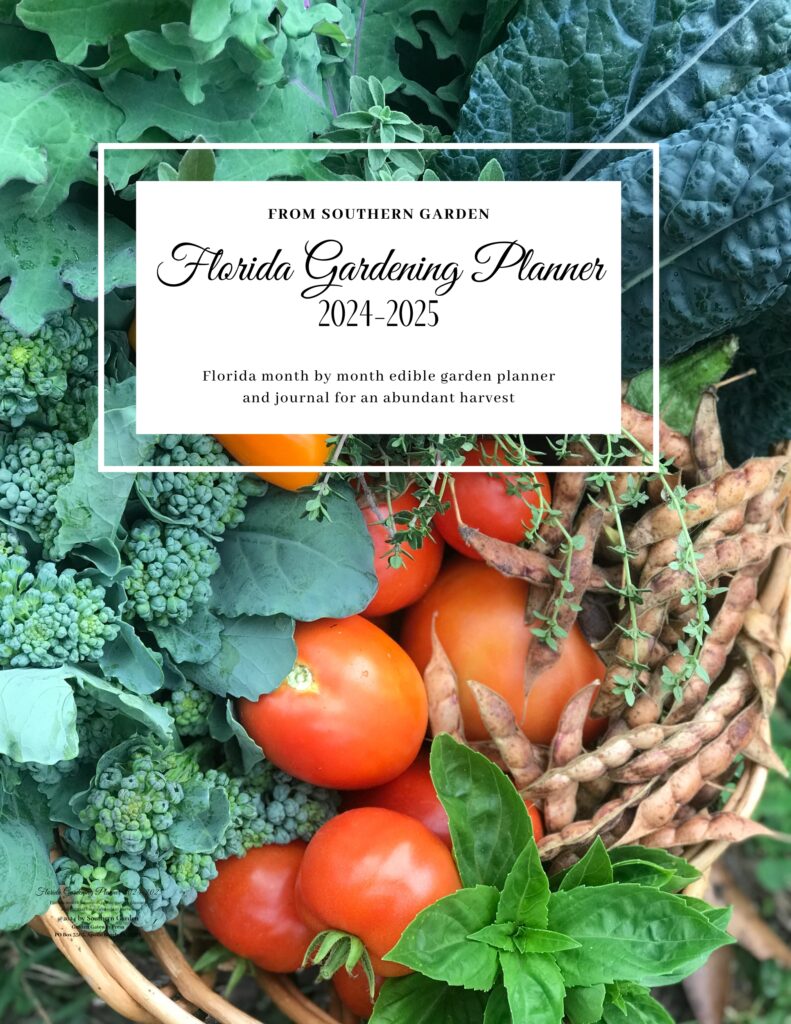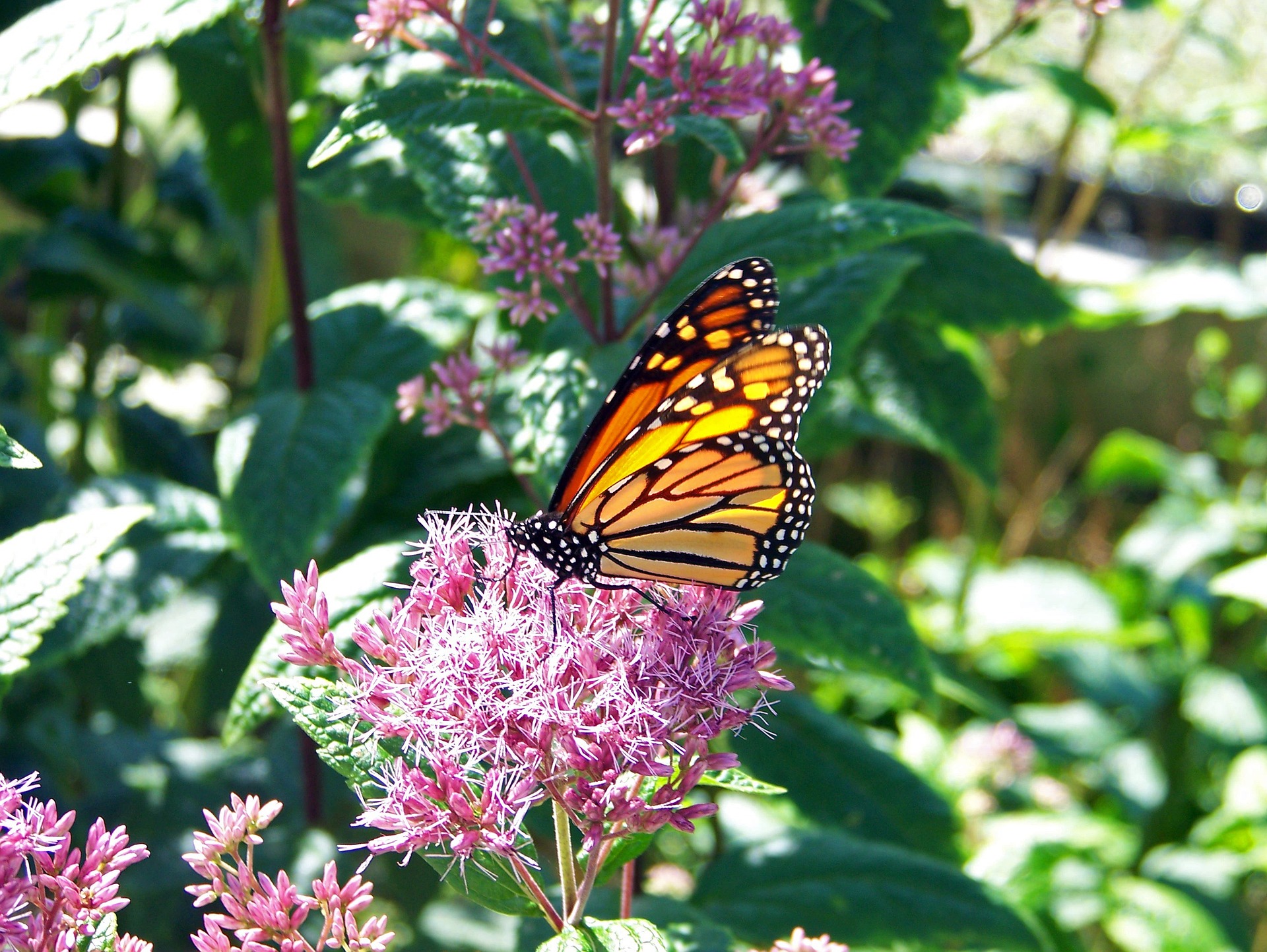
Florida native plants are the original inhabitants of our state’s landscapes, flourishing here long before we arrived and built golf courses and housing developments. These plants evolved to thrive in Florida’s unique climate and soils, and along with our wildlife. This makes them ideally suited for local gardens.
Best of all, unlike exotic or non-native species, Florida natives require minimal intervention and minimal care.
Our Favorite Flowering Florida Native Plants
- Partridge Pea (Chamaecrista fasciculata)
- Scarlet Paintbrush (Castilleja coccinea)
- Spanish Needles (Bidens alba)
- Beach Sunflower (Helianthus debilis)
- Lanceleaf Coreopsis (Coreopsis lanceolata)
- Black-eyed Susan (Rudbeckia hirta)
- Indian Blanket Flower (Gaillardia pulchella)
- Florida Tasselflower (Emilia fosbergii)
- Scarlet Sage (Salvia coccinea)
- Spotted Beebalm (Monarda punctata)
- Butterfly Milkweed (Asclepias tuberosa)
- Blue-eyed Grass (Sisyrinchium angustifolium)
- Swamp Sunflower (Helianthus angustifolius)
- Pineland Lantana (Lantana depressa)
- Lyreleaf Sage (Salvia lyrata)
- Scarlet Hibiscus (Hibiscus coccineus)
- Swamp Milkweed (Asclepias perennis)
- Coastal Mock Vervain (Glandularia maritima)
- Elliot’s Aster (Symphyotrichum elliottii)
- Spiderwort (Tradescantia ohiensis)
- Stokes Aster (Stokesia laevis)
- Swamp Rosemallow (Hibiscus grandiflorus)
- Wild Bue Phlox (Phlox divaricata)
Why Choose Florida Native Plants for Your Flower Garden?
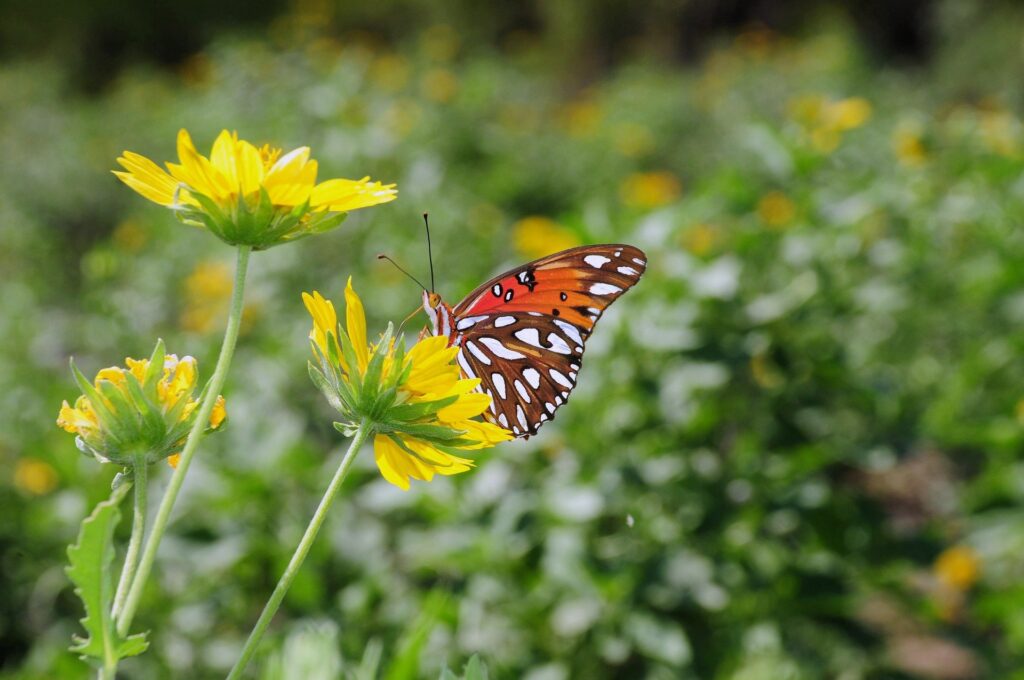
Choosing native plants isn’t just a nod to Florida’s natural heritage — it’s a smart and sustainable gardening choice. Native plants are adapted to Florida’s often harsh conditions, meaning they need less water, fertilizer, and pesticides. This conserves resources and saves you money. Lots of money.
It also saves you lots of effort. I don’t know about you, but with our erratic weather and exhausting heat, the less physical effort I have to spend outdoors, the better. I like to save my energy for tending the vegetable garden. It’s nice to know that native flowering plants will keep my yard looking pretty without any pampering.
Even better, native plants create habitats for pollinators, birds, and other wildlife. Planting native promotes biodiversity and ensure the garden becomes a lively, thriving ecosystem.
Florida’s Diverse Ecosystems: A Garden for Every Condition
Florida’s ecosystems are as varied as its landscapes, offering gardeners endless inspiration. From the sun-drenched coasts to the shady hammocks and wetlands, there’s a native plant species for every type of growing condition.
Whether your yard is sandy, marshy, or somewhere in between, native plants are ready to meet the challenge. Understanding Florida’s ecosystems helps you select the perfect plants for your garden’s specific needs.
Why Home Gardeners Need This Guide to Florida Native Plants
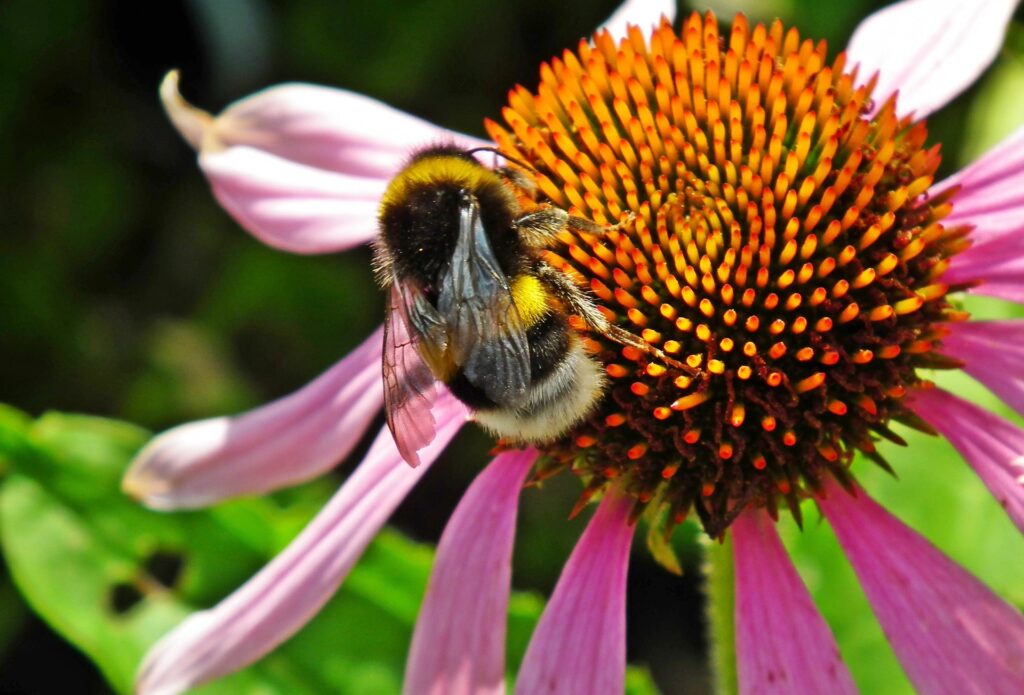
Choosing the right plants for your Florida garden can feel overwhelming. When I first contemplated adding natives, I was frankly uninspired. I thought most of them looked a bit … weedy.
But since then, I realize I just didn’t have all the information. The same four or five “natives” pop up on every internet list, and many of them aren’t really suited to creating an attractive flower garden.
But now I know better, and that’s where this list comes in. You really can focus on Florida native plants while creating a garden that’s beautiful, low-maintenance, and contributes to the local environment.
Understanding Florida’s Growing Conditions
Florida’s USDA hardiness zones span from a tiny section of 8b in the cooler north to 11b in the tropical south. This offers a wide range of growing environments. These zones dictate which Florida native plants will thrive in your garden.
From frost-tolerant species in the north to heat-loving varieties in the south, knowing your zone helps you make informed plant choices.
How Temperature and Frost Affect Florida Native Plants
Temperature extremes in Florida can range from occasional winter frosts in zone 8b to balmy year-round warmth in zone 11b.
Frost dates are crucial for gardeners, especially in northern regions, where native plants must tolerate brief cold snaps. Southern Florida gardeners, on the other hand, can grow frost-sensitive natives with little care.
Adapting to Florida’s Rainfall and Humidity
Florida’s unique rainfall patterns and high humidity are central to selecting the right Florida native plants for your garden. With wet summers and drier winters, native plants have evolved to handle these fluctuations.
Choosing species that naturally tolerate these conditions ensures your garden remains lush and resilient year-round.
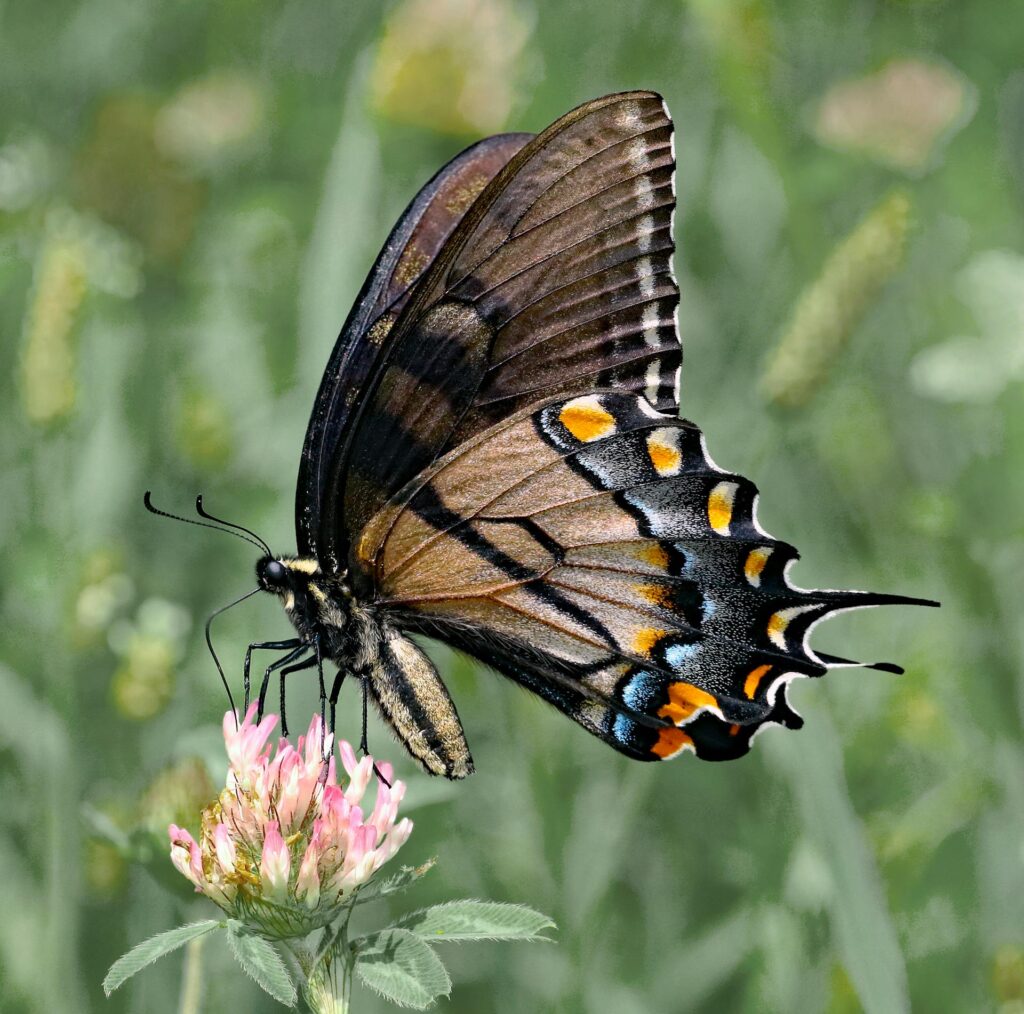
Microclimates: Tailoring Florida Native Plants to Your Garden
Your garden likely contains microclimates — small areas with unique growing conditions. These can include shady spots, areas with poor drainage, or wind-exposed corners.
Recognizing these variations allows you to select Florida native plants that thrive in each specific area, ensuring a thriving and visually balanced garden.
You can also create your own microclimates by using small trees or bushes for extra shelter. If you have the space, you can even create mini-wetlands or ponds for swamp-loving species.
Beautiful Florida Native Plants to Add to Your Garden
With Florida’s diverse climate and ecosystems, there’s a native plant for every type of garden. Florida native plants offer stunning options that thrive naturally in any conditions or growing zone in the state.
In this section, we’ll explore some of the most best native plants for your Florida garden. These plants not only add beauty and functionality to your landscape but also provide essential support for local wildlife and the environment.
1. Partridge Pea (Chamaecrista fasciculata)
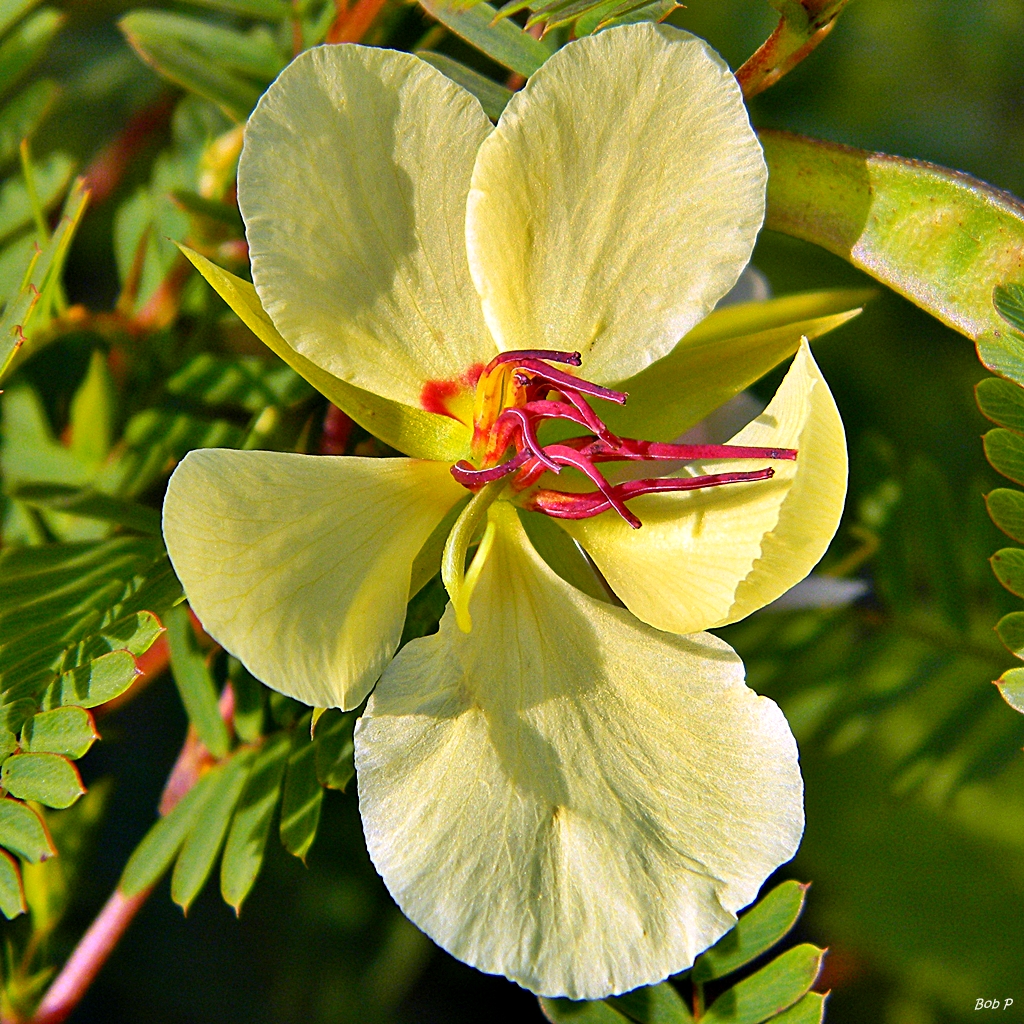
Partridge pea is an annual leguminous plant that forms a bushy, upright habit. It has bright green, pinnately compound leaves and produces small, striking yellow flowers with red markings at the base. The flowers are 1 to 2 inches across, attracting various pollinators, including bees and butterflies.
The plant also produces slender, elongated seed pods that stay on the plant into the fall. Partridge pea is valued for its ability to fix nitrogen in the soil, helping to improve soil fertility, making it a popular choice for wildflower mixes and naturalized landscapes.
Best Growing Region / Zone:
In Florida, partridge pea grows best in USDA hardiness zones 8b to 10, which covers much of the state. It is especially well-suited for central and northern Florida, where it can thrive in the warmer months and handle mild winters.
Native to Florida’s upland habitats, it is commonly found in dry prairies, disturbed fields, and sandy pinelands. The plant does well in the state’s central and north-central regions, where it naturally grows in full sunlight.
Preferred Growing Conditions:
Partridge pea prefers full sun and well-drained soils that are either sandy or loamy. It is drought-tolerant once established and can adapt to various soil types, though it thrives best in moderately fertile soil.
The plant is often found in disturbed areas, such as roadsides and field edges, where it benefits from the exposure to direct sunlight and open space.
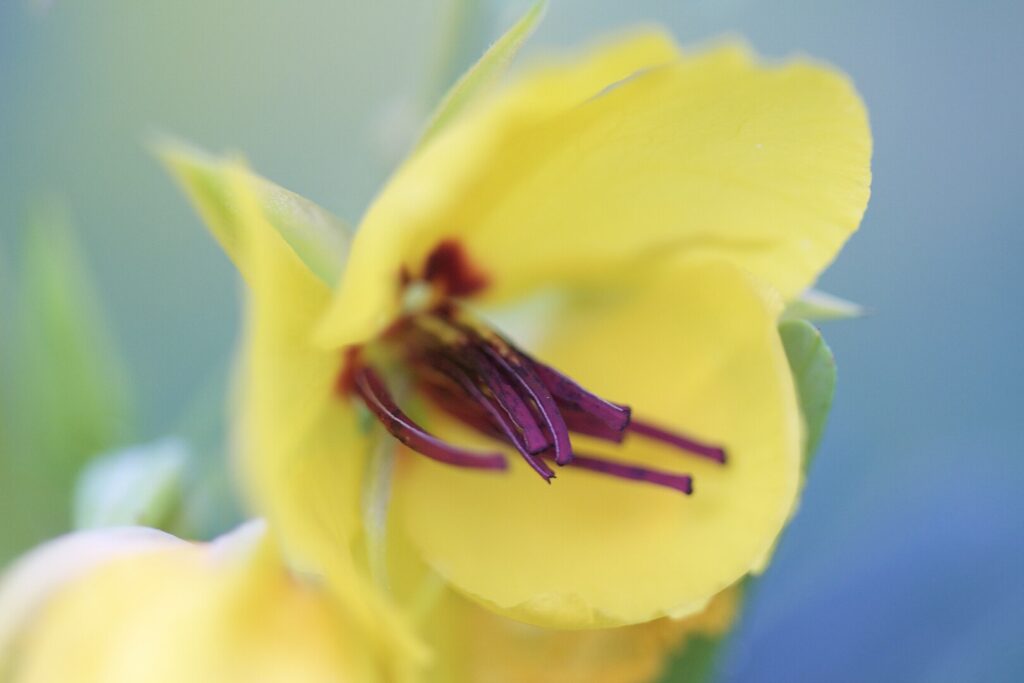
Height / Spread:
Partridge pea typically reaches 2 to 3 feet in height and spreads about 1 to 2 feet in width. Its compact, bushy growth habit makes it ideal for planting in wildflower gardens, meadows, or naturalized landscapes where it can create dense clusters of yellow flowers.
Lifespan:
As an annual, partridge pea completes its life cycle within one growing season. It germinates in the spring, blooms during the summer, and dies off after setting seeds in the fall. It relies on seed reproduction, dispersing its seeds for future generations.
Bloom Period:
In Florida, partridge pea blooms from mid-summer to early fall, typically from June to September. Its bright yellow flowers, which are adorned with red markings, bloom profusely in clusters, offering a striking visual display during the hottest months of the year.
Flower Color:
The flowers of partridge pea are a vivid yellow, often highlighted with red or orange markings at the base. This coloration makes it particularly attractive to pollinators, including bees and butterflies, helping to support the local ecosystem.
Wildlife Value:
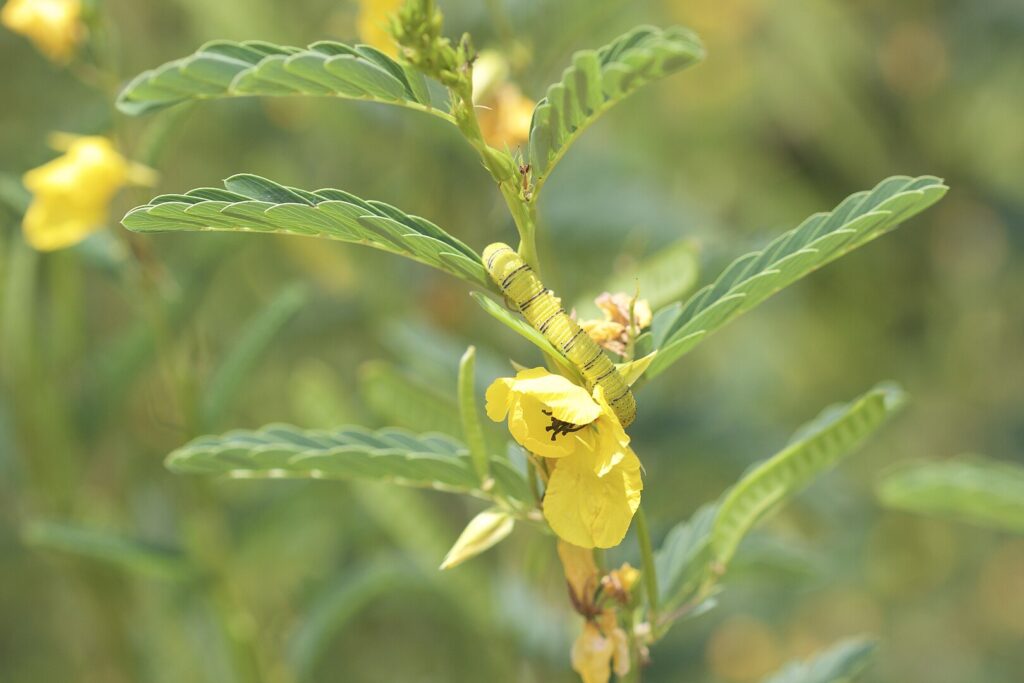
Partridge pea is highly beneficial to Florida’s local wildlife. Its flowers provide nectar for native bees, such as the Eastern Bumblebee (Bombus impatiens), and butterflies like the Tiger Swallowtail (Papilio glaucus).
The seeds produced in the pods serve as an important food source for birds, including species like quail and sparrows. This plant is especially valuable during the summer and fall when other food sources might be less available, helping to sustain various wildlife populations in Florida’s natural habitats.
2. Scarlet Paintbrush (Castilleja coccinea)
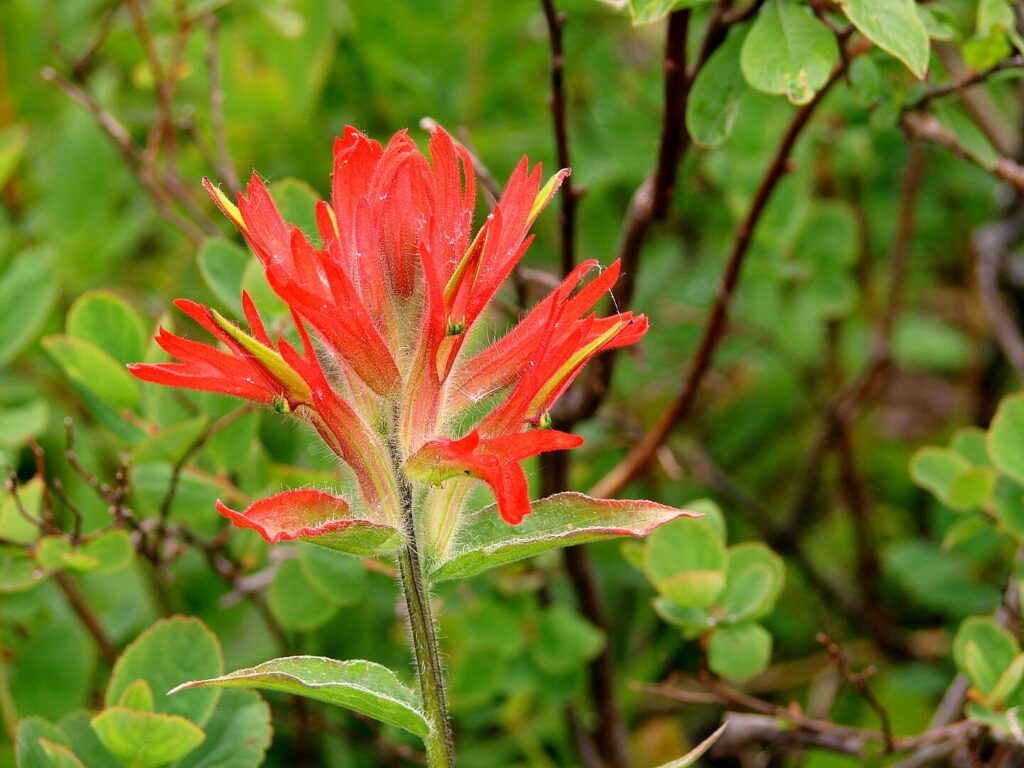
Scarlet Paintbrush is a striking perennial wildflower that can be recognized by its upright, slender stems and bright red flowers, which are surrounded by red bracts that resemble a paintbrush. The flowers themselves are tubular and clustered at the tops of the stems, with long, pointed leaves growing along the stem.
The plant is typically around 1–2 feet tall, and the leaves are lance-shaped and narrow, contributing to the plant’s delicate appearance. The brilliant red color of the flowers stands out in natural landscapes, adding a splash of color during its blooming period.
Best Growing Region / Zone:
Scarlet Paintbrush thrives in Florida’s central and northern regions, primarily in USDA Hardiness Zones 8b to 9a. This species is found in areas with slightly cooler conditions than southern parts of the state and performs best in the open, sunny landscapes of these regions.
It is particularly suited for environments such as sandy or well-drained soils in upland areas, meadows, and roadsides, where it can tolerate some disturbance and drought.
Preferred Growing Conditions:
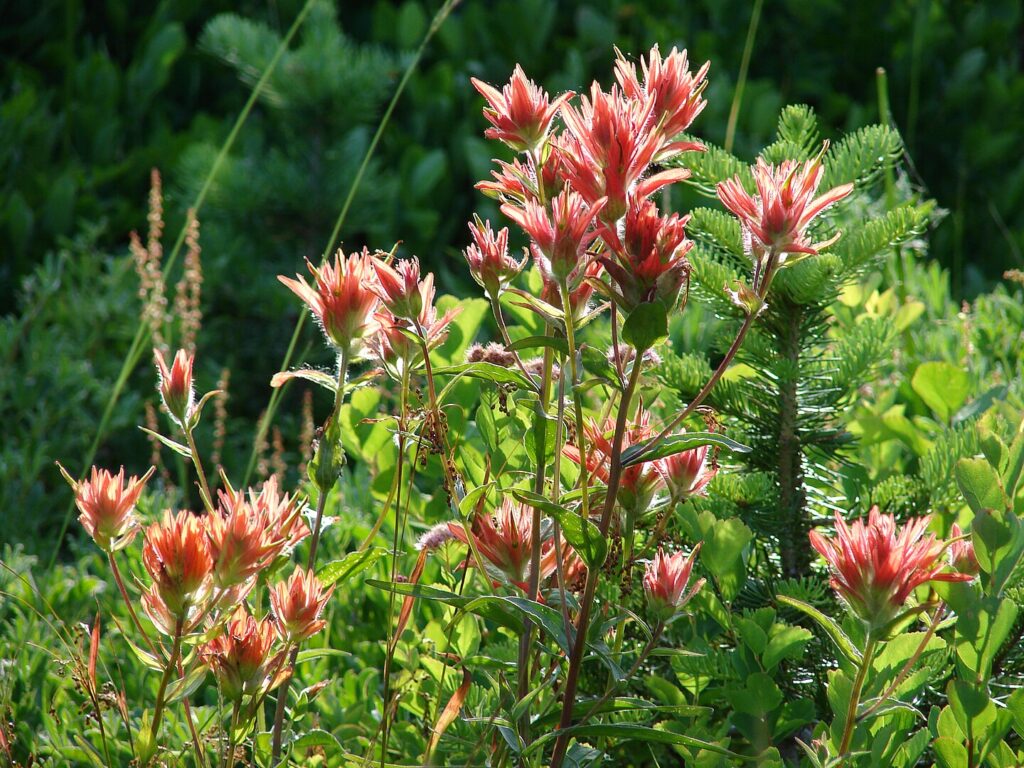
This plant is typically found in areas with well-drained, sandy soils and is adapted to regions that experience moderate rainfall. It prefers full sun but can also tolerate partial shade, though it may not bloom as vigorously in lower light conditions.
Once established, Scarlet Paintbrush is drought-tolBy Steve Redman (MORA) – NPGallery, Public Domain, Linkerant, though it requires moisture during its growing season. The plant performs well in acidic soils with good drainage, often thriving in disturbed areas or places where other plants have difficulty growing, making it a useful species in reclaiming disturbed habitats or adding color to less fertile locations.
Height / Spread:
Scarlet Paintbrush grows to a height of 1 to 2 feet and spreads about 1 to 1.5 feet. It has a compact, upright growth habit, which allows it to fit well in native plant gardens, wildflower meadows, or areas where plant diversity is desired.
Lifespan:
This species is considered a short-lived perennial, typically living 2 to 3 years. While it does not persist for decades like some other perennials, its fast growth and vibrant blooms make it a valued addition to landscapes during its lifecycle. It will often self-sow in favorable conditions, creating new plants each season.
Bloom Period:
Scarlet Paintbrush blooms from late spring into early summer, generally between May and June. The plant produces its most abundant blooms during this period, with clusters of bright red tubular flowers, drawing pollinators to the area. The bloom period is relatively short, lasting for about 4 to 6 weeks, but it provides critical nectar during the early summer months.
Flower Color:
The most notable feature of this plant is its brilliant red flowers, which are clustered at the tops of the stems. The flowers are tubular and surrounded by red bracts that mimic the appearance of a paintbrush, giving the plant its common name. This vivid color provides a striking contrast to the green foliage and surrounding plants, making it a popular choice for adding color to gardens or natural landscapes.
Wildlife Value:

Scarlet Paintbrush is an important nectar source for various pollinators. It attracts hummingbirds, particularly the Ruby-throated Hummingbird, which feed on the sweet nectar. Several species of native bees, such as bumblebees and mason bees, also visit the flowers to collect nectar and pollen.
In addition to being a valuable food source for pollinators, the plant supports various butterfly species, including the Eastern Tiger Swallowtail, which feeds on its nectar. It also serves as a food source for other wildlife in natural settings, making it a beneficial addition to ecosystems where pollinators are crucial.
3. Spanish Needles (Bidens alba)
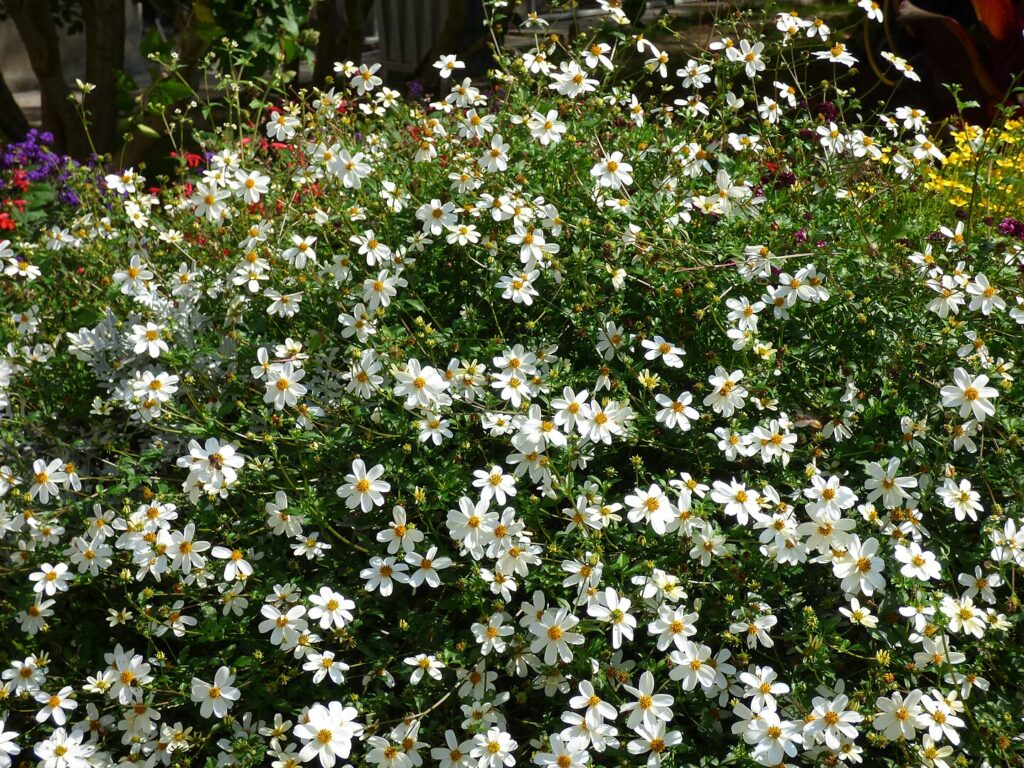
Spanish Needles is a fast-growing, herbaceous perennial that typically grows as a bushy, multi-stemmed plant. Some people think it’s a weed, but it’s an official Florida wildflower.
It produces long, slender leaves with serrated edges and bright yellow, daisy-like flowers with distinctive dark centers. These flowers are held above the foliage on tall, slender stems.
The plant is known for its ability to spread rapidly, often forming dense patches in suitable habitats. Its seeds are equipped with needle-like barbs that easily attach to fur, clothing, and other surfaces, aiding in seed dispersal.
Best Growing Region / Zone:
Spanish Needles thrives in Florida’s warmer climates, generally performing best in USDA hardiness zones 8a to 11. It is commonly found in the central and southern regions of Florida but can be found in various habitats throughout the state, particularly in coastal and disturbed areas.
Preferred Growing Conditions:
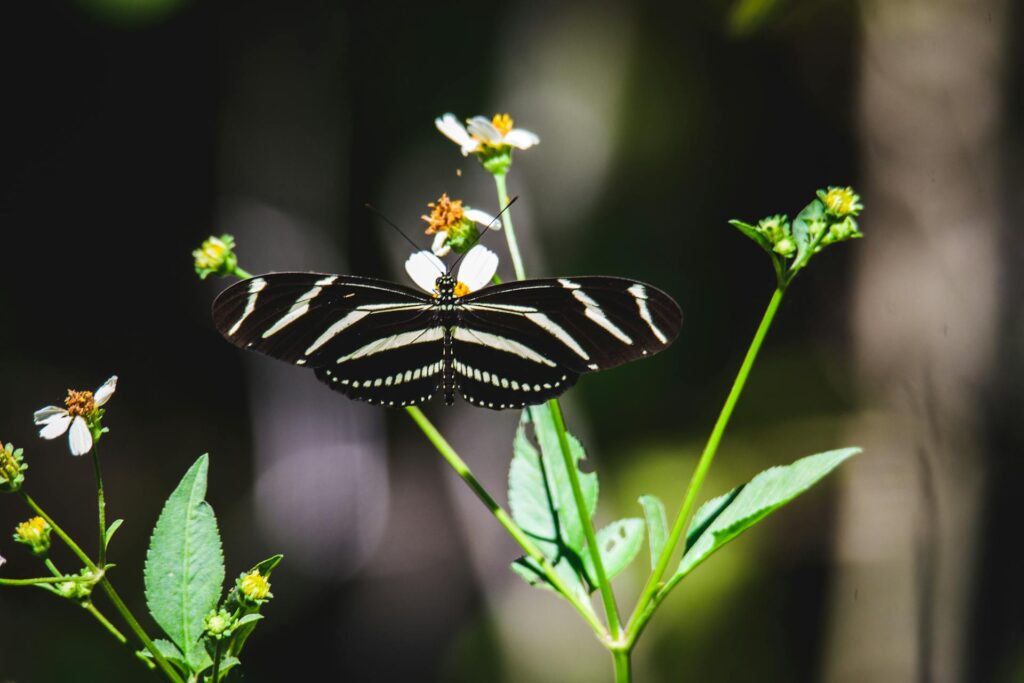
Spanish Needles is adaptable to a wide range of soil types but prefers well-drained soils that are moderately fertile. It grows best in full sun but can tolerate partial shade, particularly in hotter regions. Once established, it is relatively drought-tolerant but benefits from occasional moisture during prolonged dry spells.
Spanish Needles also thrives in disturbed areas, roadsides, and field edges, often growing in areas that are subject to occasional flooding.
Height / Spread:
The plant typically reaches a height of 2 to 4 feet and spreads up to 3 feet wide. It can become bushy and sprawling if grown in favorable conditions, creating a dense ground cover.
Lifespan:
Spanish Needles is a fast-growing and prolifically reseeding annual.
Bloom Period:
Spanish Needles flowers from very early spring to early winter, with peak bloom typically occurring in late spring to early summer. Its ability to flower for much of the year makes it an important nectar source for various pollinators.
Flower Color:
The flowers are bright yellow with a prominent dark center, giving them a striking appearance. The petals are thin and ray-like, surrounding a central disc that attracts a variety of pollinators.
Wildlife Value:
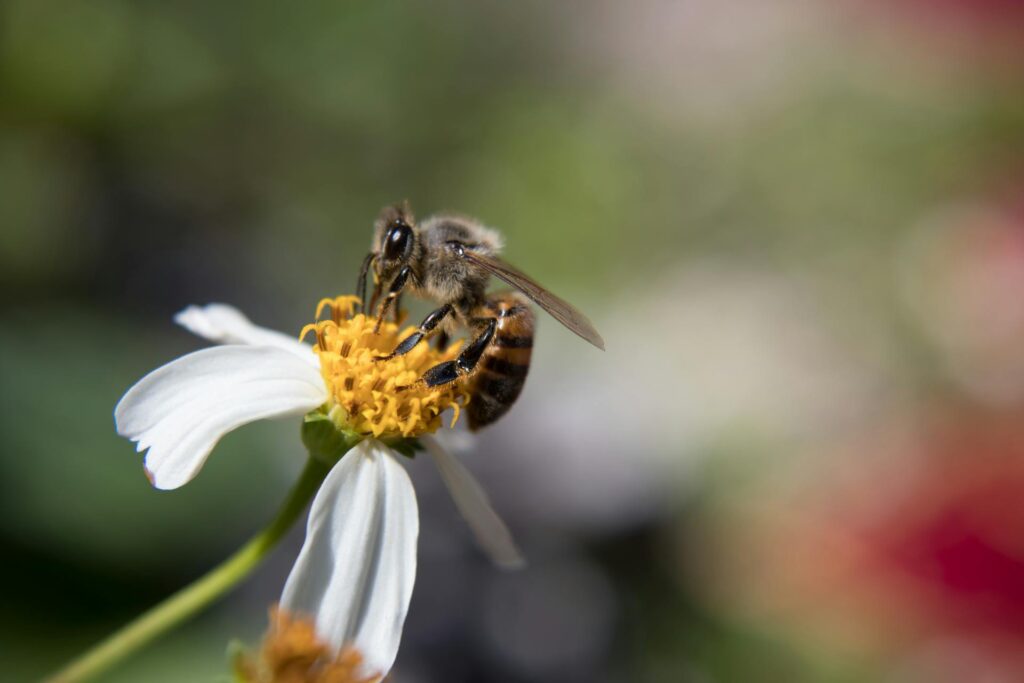
Spanish Needles is highly attractive to a wide range of wildlife. Its abundant yellow flowers are a key nectar source for bees, butterflies, and other pollinators, including species such as the honeybee (Apis mellifera), the common buckeye butterfly (Junonia coenia), and various native bee species.
The plant’s seeds are eaten by birds, especially during the fall and winter months. It also provides habitat for small insects, making it an important plant for supporting biodiversity.
4. Beach Sunflower (Helianthus debilis)

Beach Sunflower is a low-growing, sprawling perennial that thrives in sandy soils and coastal habitats. It has wide, dark green leaves with a rough texture and produces bright yellow flowers that resemble traditional sunflowers, though they are smaller in size. The plant’s stems are often reddish and covered with fine hairs.
Beach Sunflower is an excellent ground cover due to its spreading habit, often forming dense patches along the edges of dunes and beaches. It is salt-tolerant and can withstand occasional saltwater exposure, making it ideal for coastal gardens.
Best Growing Region / Zone:
Beach Sunflower is well-suited for Florida’s coastal regions and thrives in USDA hardiness zones 9a to 11. It is found in sandy, well-drained soils along coastal areas, including dunes, beaches, and roadsides in Florida.
Preferred Growing Conditions:

This plant prefers full sun and well-drained sandy soils but is highly adaptable to a variety of conditions. It is tolerant of salt and drought, making it ideal for coastal gardens and areas prone to salty air and occasional sea spray. It performs best when given plenty of sunlight but can tolerate light shade, especially in hotter parts of the state.
Beach Sunflower requires minimal watering once established, but it can benefit from occasional irrigation during prolonged dry periods.
Height / Spread:
Beach Sunflower typically grows to a height of 1 to 2 feet and spreads 2 to 3 feet wide, making it an ideal choice for ground cover or as a border plant in coastal landscapes. Its spreading habit allows it to quickly cover large areas.
Lifespan:
This plant is a perennial in Florida, typically living for several years in the right conditions. It may exhibit some dieback during colder winter months but will regenerate each spring from its root system.
Bloom Period:
Beach Sunflower blooms from late spring through the fall, with its peak bloom typically occurring in the summer months. The plant produces an abundance of yellow flowers, which attract pollinators throughout its long blooming season.
Flower Color:
The flowers are bright yellow with a dark brown center, resembling the traditional sunflower shape but smaller in size. The yellow petals are often narrow, giving the flowers a distinctive appearance compared to other sunflower species.
Wildlife Value:
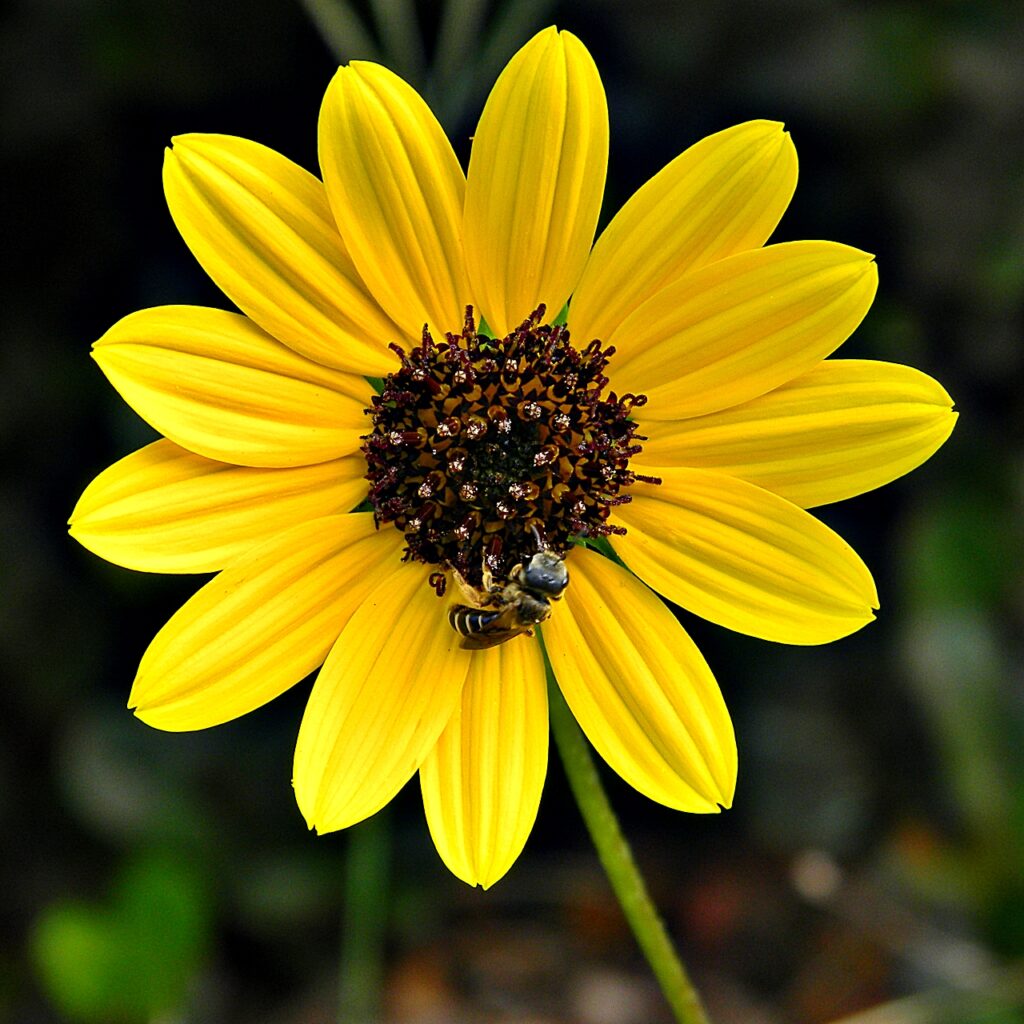
Beach Sunflower is an important plant for local wildlife. The flowers provide nectar for various pollinators, including native bees and butterflies, such as the Gulf Fritillary (Dione juno) and the common buckeye (Junonia coenia).
The seeds are consumed by birds, including sparrows and other seed-eating species. Additionally, the plant offers shelter to insects and small wildlife, helping to support a diverse ecosystem in coastal areas.
5. Lanceleaf Coreopsis (Coreopsis lanceolata)
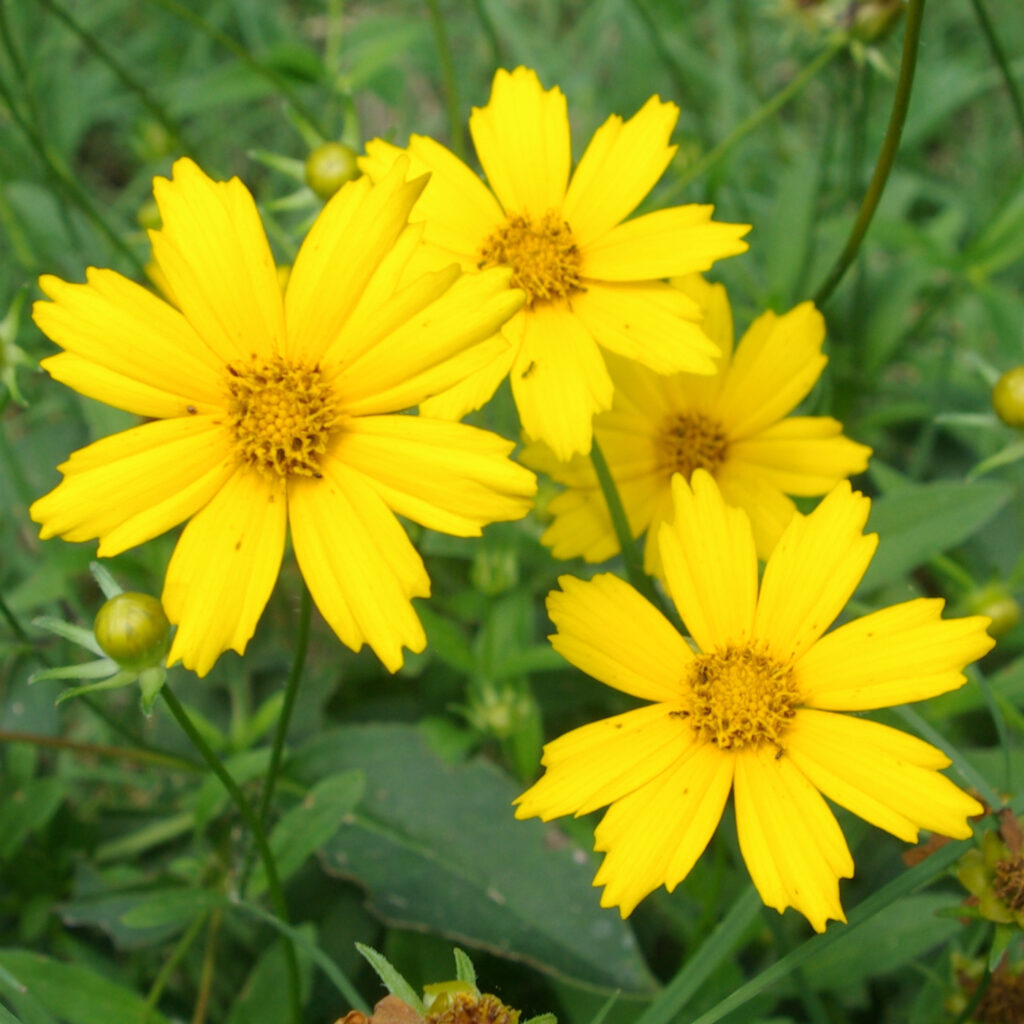
Lanceleaf Coreopsis is a perennial wildflower that grows in a compact, upright form. The plant has narrow, lance-shaped leaves that are light to medium green. It produces bright yellow flowers with a central disk surrounded by narrow, petal-like rays. The flowers are typically held on long, slender stems above the foliage, creating a striking display of color.
Lanceleaf Coreopsis is a versatile plant that thrives in a range of landscapes, from meadows to roadside habitats. Its drought tolerance and long bloom period make it a reliable addition to native plant gardens.
Best Growing Region / Zone:
Lanceleaf Coreopsis is native to the southeastern United States and thrives in Florida’s USDA hardiness zones 8b to 11. It is found in natural areas such as prairies, fields, and open woodlands. The plant is well-suited for a variety of regions within Florida, from central to northern areas, and it is particularly well-suited for landscapes with poor, well-drained soils.
Preferred Growing Conditions:
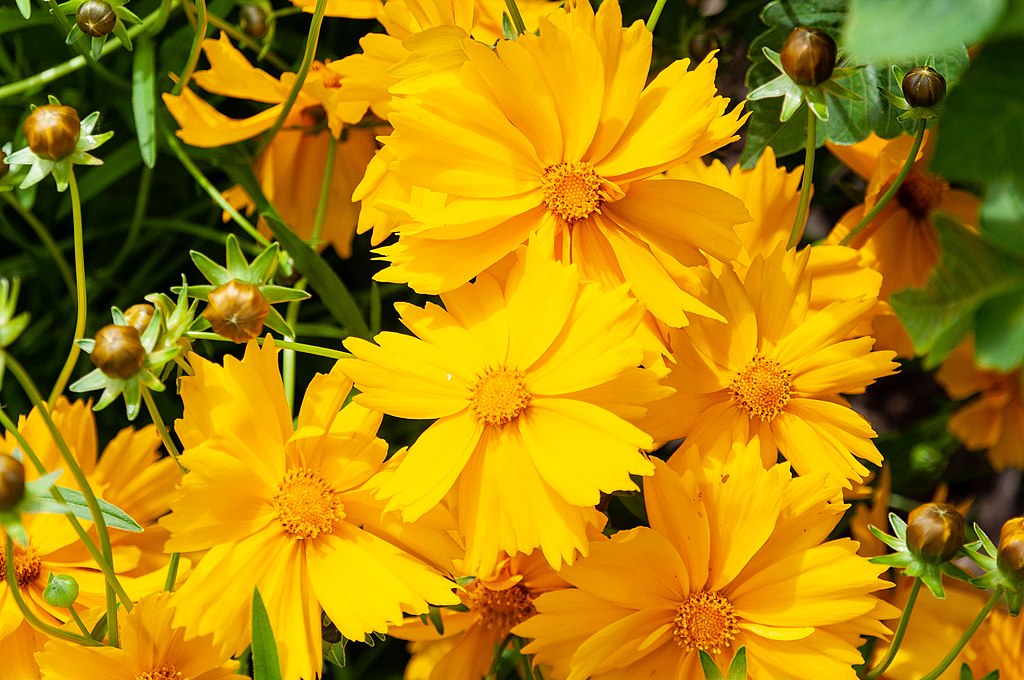
This plant prefers full sun and dry to medium moisture levels, thriving in well-drained soils. It is highly adaptable to a range of soil types, including sandy, loamy, and slightly acidic soils. Lanceleaf Coreopsis is drought-tolerant once established, making it an excellent choice for xeriscaping and native gardens. It does best in areas with low humidity and can tolerate periods of dry weather, but it does not perform well in excessively wet or waterlogged soils.
Height / Spread:
Lanceleaf Coreopsis typically reaches a height of 1 to 2 feet and spreads about 1 to 2 feet wide. It forms clumps and can spread moderately over time, making it suitable for both borders and mass plantings.
Lifespan:
This plant is a perennial, meaning it will live for several years, producing flowers each season. It may die back in winter but regrows from its roots in the spring. Proper care, such as periodic division, helps to extend its lifespan and maintain vigor.
Bloom Period:
Lanceleaf Coreopsis typically blooms from late spring through early summer, often starting in May and continuing into June. During this period, it produces abundant yellow flowers that create a bright contrast with the surrounding foliage. A second, lighter bloom may occur in late summer or early fall, depending on environmental conditions.
Flower Color:
The flowers are a bright, cheerful yellow, with long, narrow petals surrounding a central disk that starts out yellow and darkens to brown as it matures. This striking combination of color makes Lanceleaf Coreopsis a popular choice for ornamental gardens.
Wildlife Value:
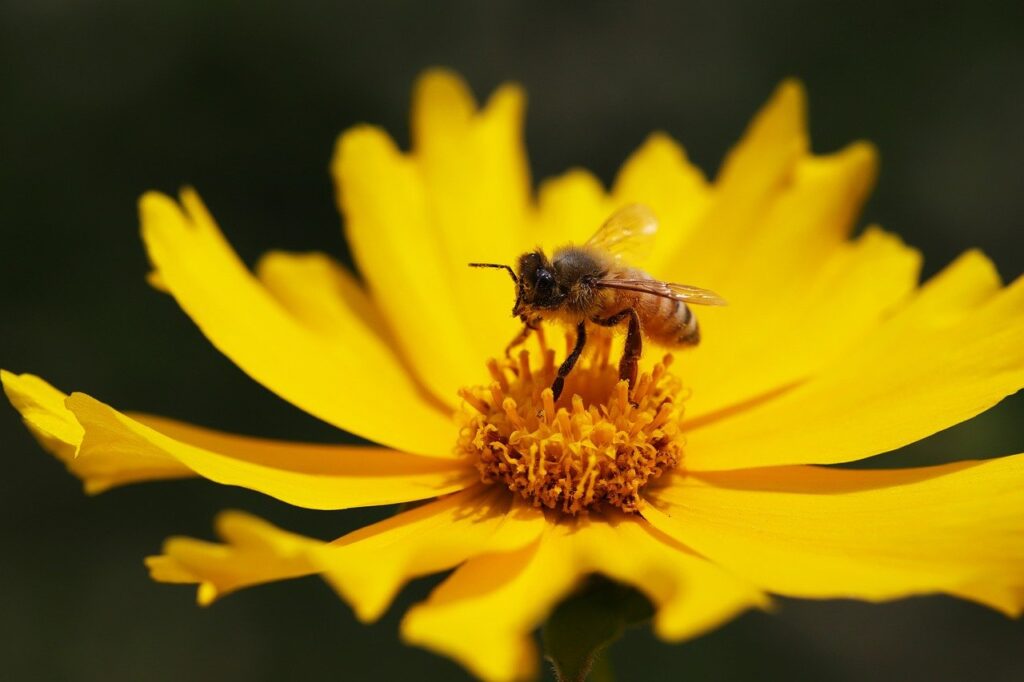
Lanceleaf Coreopsis is beneficial to a variety of wildlife. Its nectar-rich flowers attract pollinators such as native bees, including the carpenter bee (Xylocopa spp.), and butterflies, including the common checkered skipper (Pyrgus communis).
The plant also provides seeds that are eaten by birds such as sparrows. Its dense foliage offers shelter for small insects and beneficial creatures, making it an important part of the local ecosystem.
6. Black-eyed Susan (Rudbeckia hirta)
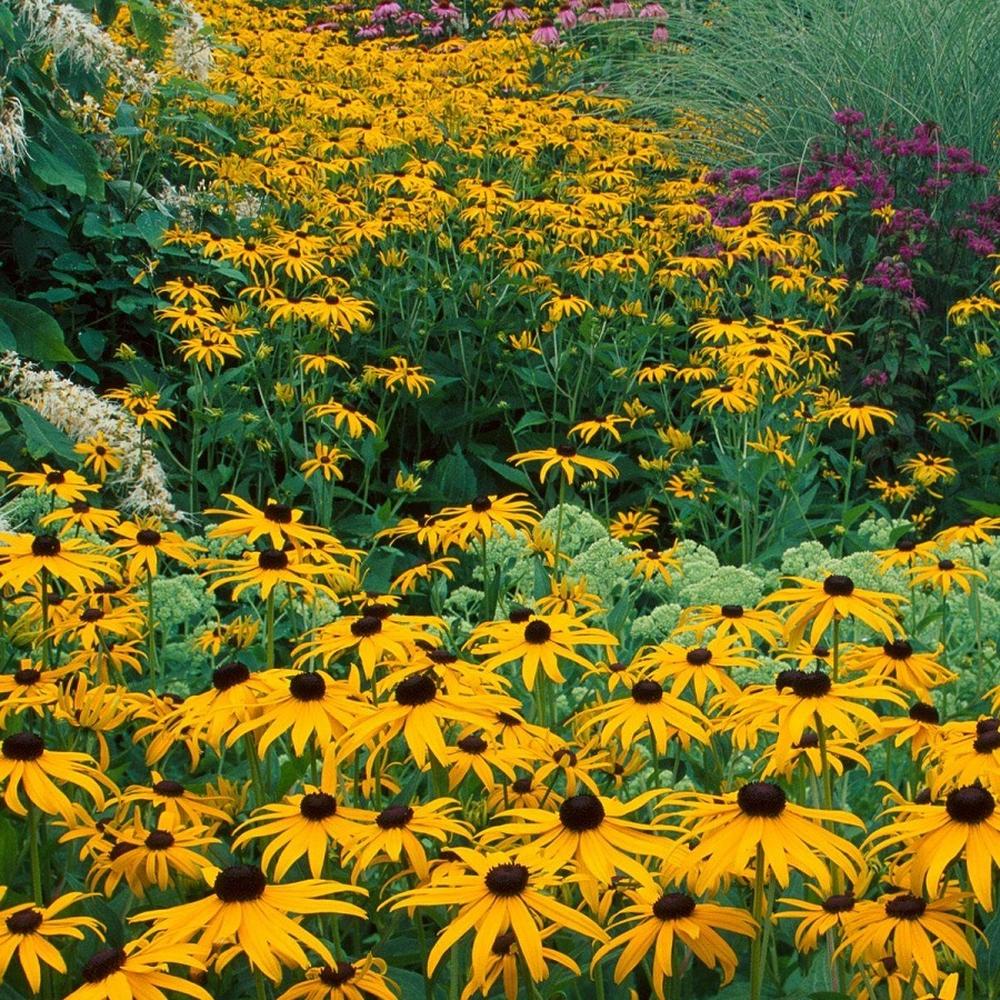
Black-eyed Susan is a striking perennial or biennial wildflower with daisy-like flowers that stand tall on sturdy, erect stems. The plant has dark green, coarse-textured leaves that are lance-shaped and covered with fine hairs. The flowers feature vibrant yellow petals surrounding a dark, cone-shaped central disk, which gives the plant its name.
Black-eyed Susan is a hardy and resilient plant, known for its ability to withstand a variety of growing conditions, and it is often used in gardens for its long-lasting blooms and attractive foliage. It forms clumps and can spread moderately by seed.
Best Growing Region / Zone:
Black-eyed Susan thrives in USDA hardiness zones 3 to 9 and is found throughout much of Florida. It is native to a wide range of habitats, including prairies, meadows, and open woodlands. In Florida, it is best suited to regions with moderate to well-drained soils, where it can be found in both natural settings and cultivated gardens.
Preferred Growing Conditions:
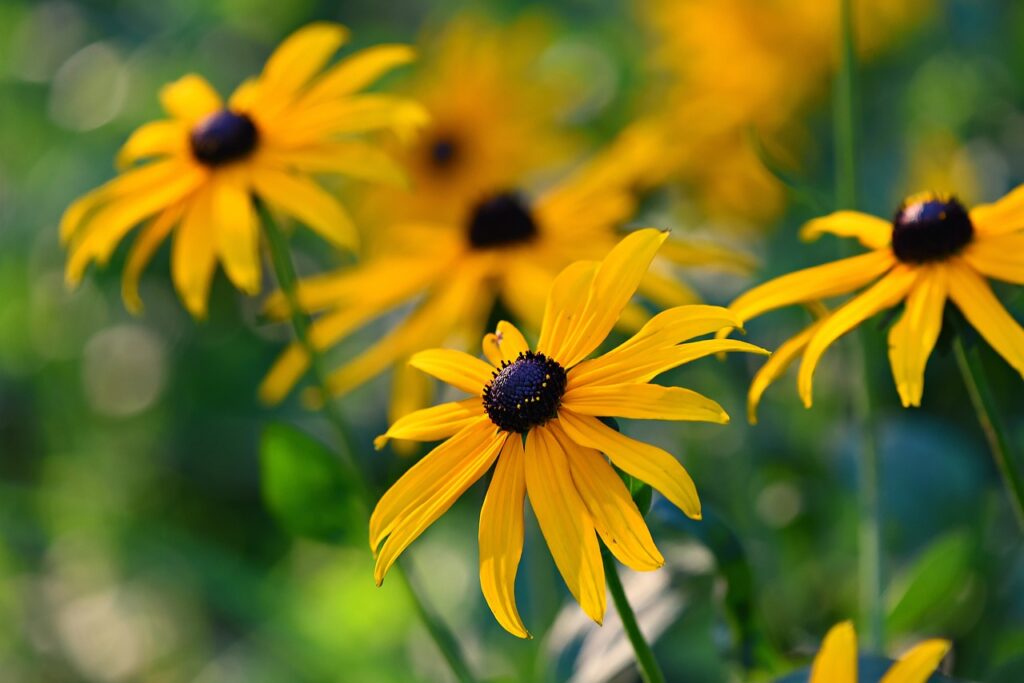
This plant prefers full sun but can tolerate light shade, especially in warmer climates. It grows well in well-drained soils, including sandy or loamy soils, and is adaptable to a range of pH levels, including mildly acidic to neutral.
Black-eyed Susan is drought-tolerant once established, making it a good choice for xeriscaping and areas with dry conditions. However, it does need consistent moisture during its growing season to perform optimally, particularly during dry spells.
Height / Spread:
Black-eyed Susan typically grows between 1 and 3 feet in height and spreads about 1 to 2 feet wide. Its upright, bushy habit and profuse flowers make it an excellent choice for borders, naturalized plantings, and wildflower gardens.
Lifespan:
Black-eyed Susan is generally a short-lived perennial or biennial, with a lifespan of 2 to 3 years. Though it may only survive for a few seasons, it often self-seeds and will return year after year in the same spot, providing long-term beauty. Regular deadheading and division can help prolong its flowering and vitality.
Bloom Period:
Black-eyed Susan blooms from early to late summer, typically from June through August. Its large, yellow flowers are borne on tall stems above the foliage and create a bright, cheerful display throughout the growing season. The plant may produce occasional blooms into early fall, especially if the weather is favorable.
Flower Color:
The flowers of Black-eyed Susan are a rich, golden yellow with a distinctive dark brown to black central disk. The petals are long and slender, and the flowers are held on tall stems that give the plant an airy, open appearance. This striking combination of colors makes Black-eyed Susan a favorite in wildflower and cottage gardens.
Wildlife Value:
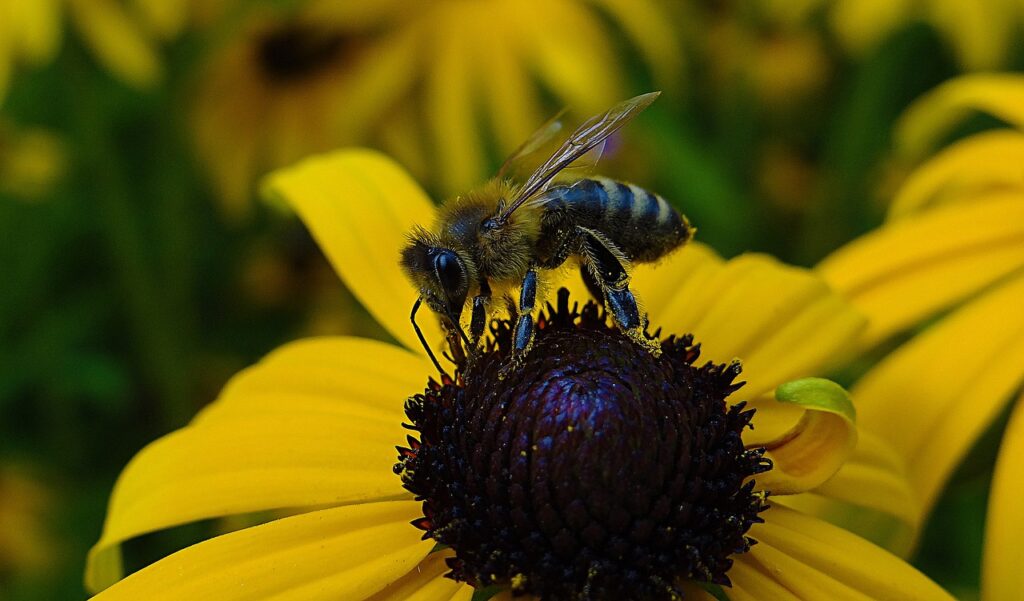
Black-eyed Susan is an excellent plant for attracting pollinators. Its nectar-rich flowers attract native bees, including the honey bee (Apis mellifera), as well as butterflies such as the American lady (Vanessa virginiensis) and the painted lady (Vanessa cardui).
The seeds of Black-eyed Susan are consumed by birds, including finches and sparrows. The plant’s sturdy stems and foliage provide shelter for small insects and beneficial wildlife, making it an important addition to a pollinator-friendly or wildlife garden.
7. Indian Blanket Flower (Gaillardia pulchella)
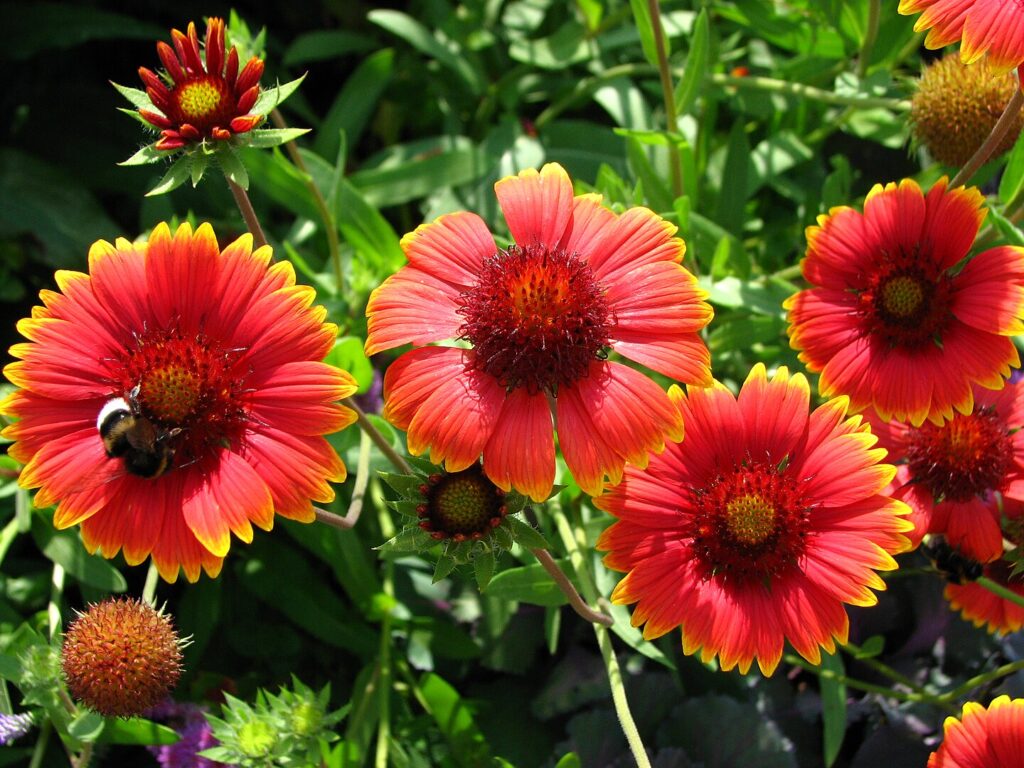
Indian Blanket Flower is an annual wildflower known for its vibrant, multicolored flowers. The plant has narrow, lance-shaped leaves that are green and slightly hairy. The flowers consist of bright red and yellow petals surrounding a central disk, which ranges from dark brown to purple.
Indian Blanket Flower has a bushy, upright growth habit and is often used in naturalized gardens or wildflower meadows for its cheerful color. This plant is drought-tolerant and can grow in poor, sandy soils, making it well-suited to arid or low-maintenance landscapes. It can self-seed readily, contributing to its spread and creating bright, colorful patches year after year.
Best Growing Region / Zone:
Indian Blanket Flower is native to Florida and is found in USDA hardiness zones 8a to 11. Even in Florida’s warmer climate, it has an annual growing cycle. It thrives in dry, open habitats, such as coastal dunes, roadsides, and disturbed areas. The plant does well in full sun and is commonly found in the central and northern parts of Florida.
Preferred Growing Conditions:
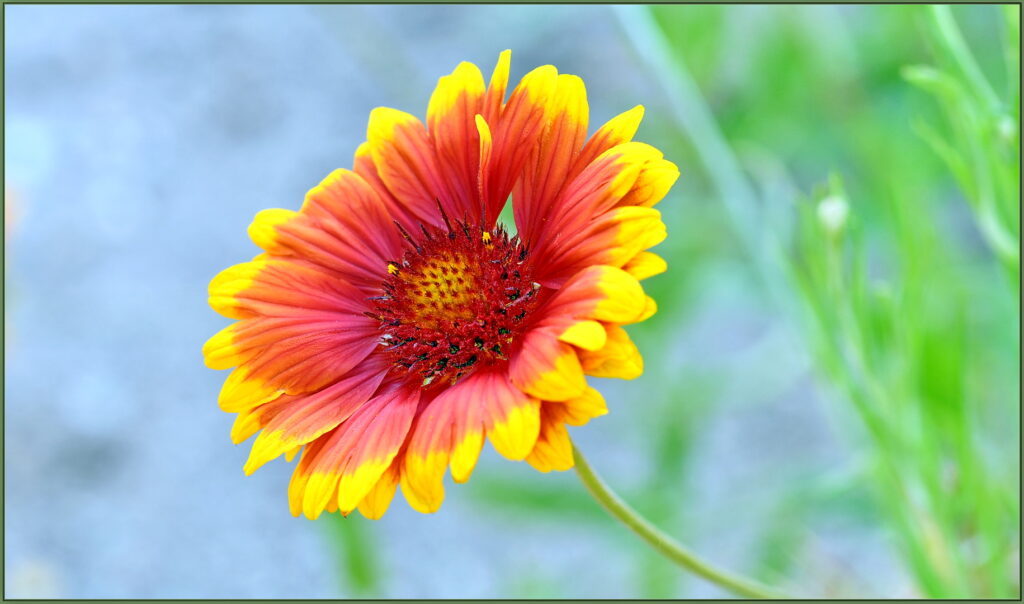
Indian Blanket Flower prefers full sun and well-drained, sandy, or loamy soils. It is highly drought-tolerant once established and thrives in nutrient-poor soils. This plant does not require frequent watering, and it can survive periods of dryness, making it ideal for xeriscaping and coastal gardens.
It is adaptable to a variety of conditions but performs best in dry, sunny spots with minimal competition from other plants. While it can tolerate some light shade, it flowers best with ample sunlight.
Height / Spread:
Indian Blanket Flower typically grows between 12 to 18 inches in height and spreads about 12 to 18 inches wide. It is a compact, mounding plant that is well-suited for smaller garden spaces, edges of wildflower meadows, and containers. Its spreading habit can fill in areas with its bright, colorful flowers.
Lifespan:
Indian Blanket Flower is an annual in Florida, completing its life cycle within one growing season. The plant germinates, blooms, and sets seed during the spring and summer months, then dies back after the first frost. However, it readily self-seeds, allowing it to return the following year without replanting.
Bloom Period:
Indian Blanket Flower blooms from late spring through the fall, with peak bloom occurring in the summer months. The flowers are long-lasting, providing a burst of color throughout the warmer season. The plant is particularly attractive to pollinators during this time and continues to bloom until the first frost.
Flower Color:
The flowers of Indian Blanket Flower are a striking combination of red and yellow, often arranged in a fiery, sunset-like pattern. The petals are bright red with yellow tips, while the central disk is typically dark brown to purple, providing a stark contrast to the colorful petals. This makes the plant highly attractive to both humans and pollinators.
Wildlife Value:
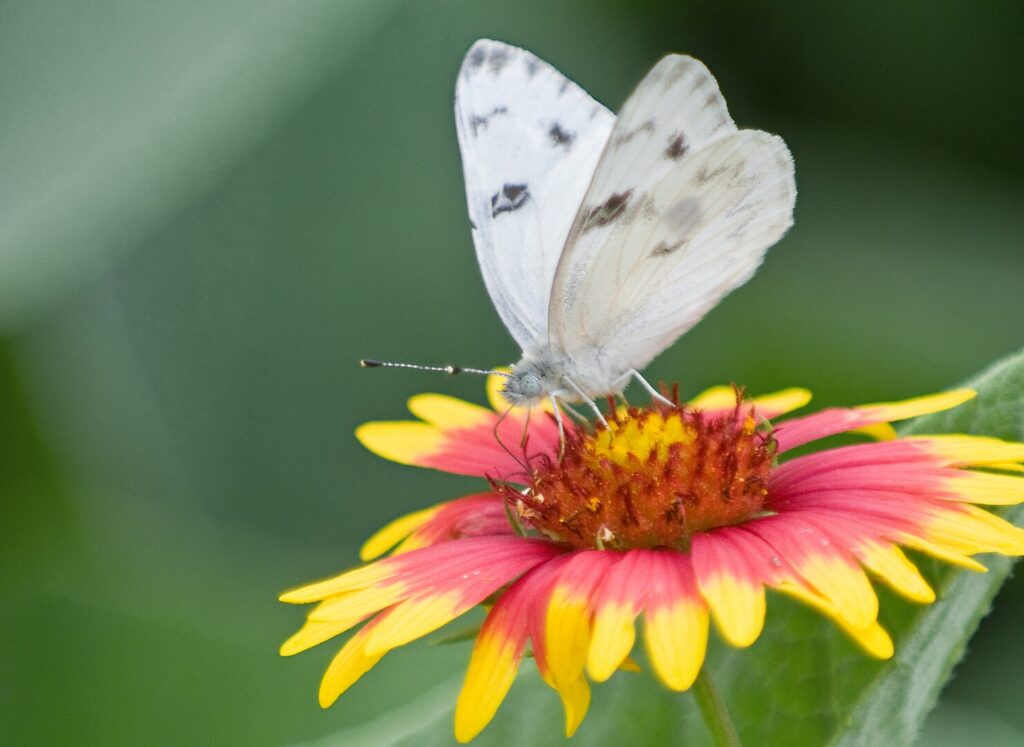
Indian Blanket Flower supports a variety of wildlife. The colorful blooms are rich in nectar, attracting numerous pollinators, including honeybees (Apis mellifera), bumblebees, and solitary bees. Butterflies such as the common buckeye (Junonia coenia) and painted lady (Vanessa cardui) are drawn to the flowers.
Birds, including finches, feed on the seeds, and the plant’s structure provides shelter to beneficial insects. This makes the Indian Blanket Flower a valuable addition to pollinator gardens and wildlife habitats.
8. Florida Tasselflower (Emilia fosbergii)

Florida Tasselflower is an annual herbaceous plant with slender, upright stems and narrow, lance-shaped leaves. The leaves are bright green and often have a slightly wavy edge. The plant’s most striking feature is its unique flower heads, which resemble fluffy, red to orange tassels. These flowers are made up of numerous long, slender, tubular florets that give the plant a distinctive, feathery appearance.
Florida Tasselflower can grow in clumps, often reaching several stems per plant, and is used in wildflower gardens or naturalized landscapes for its showy blooms. The plant can sometimes reseed itself, though it is more commonly grown as an annual in Florida.
Best Growing Region / Zone:
Florida Tasselflower thrives in Florida’s USDA hardiness zones 8b to 11, and is found throughout the state in a variety of habitats, from disturbed areas to roadsides, fields, and coastal regions. This plant is native to tropical and subtropical regions, and it is well-adapted to Florida’s climate, performing well in areas with full sun and moderate to high humidity.
Preferred Growing Conditions:

Florida Tasselflower prefers full sun and well-drained soils, including sandy, loamy, and occasionally clayey soils. It grows best in moist but not waterlogged conditions, though it is drought-tolerant once established. This plant is highly adaptable and can survive in disturbed sites, such as fields or the edges of roads.
It does best in areas with moderate rainfall but can tolerate drier periods if needed. Once established, it requires minimal care, only needing watering during prolonged dry spells.
Height / Spread:
Florida Tasselflower typically reaches a height of 2 to 3 feet, with a spread of about 1 to 2 feet. The plant has a bushy growth habit, with several stems emerging from a central base. It is relatively compact for an annual, making it a good option for smaller garden spaces or naturalized areas.
Lifespan:
This plant is an annual in Florida, completing its life cycle in one growing season. It germinates in the spring, flowers in the summer, and dies back in the fall after producing seeds. Though short-lived, Florida Tasselflower is often able to reseed itself and return the following year, depending on the growing conditions.
Bloom Period:
Florida Tasselflower blooms from late spring through the summer, often continuing into the fall. Its bright, colorful blooms attract a variety of pollinators during its long bloom period. The feathery flowers are most vibrant in the warmer months, creating a striking display in the garden.
Flower Color:
The flowers of Florida Tasselflower are primarily red to orange, with a fluffy, tassel-like structure. The tubular florets are densely packed, creating a rounded head that looks similar to a small, colorful pom-pom. The vibrant flower heads make the plant highly attractive to pollinators and a focal point in any garden setting.
Wildlife Value:
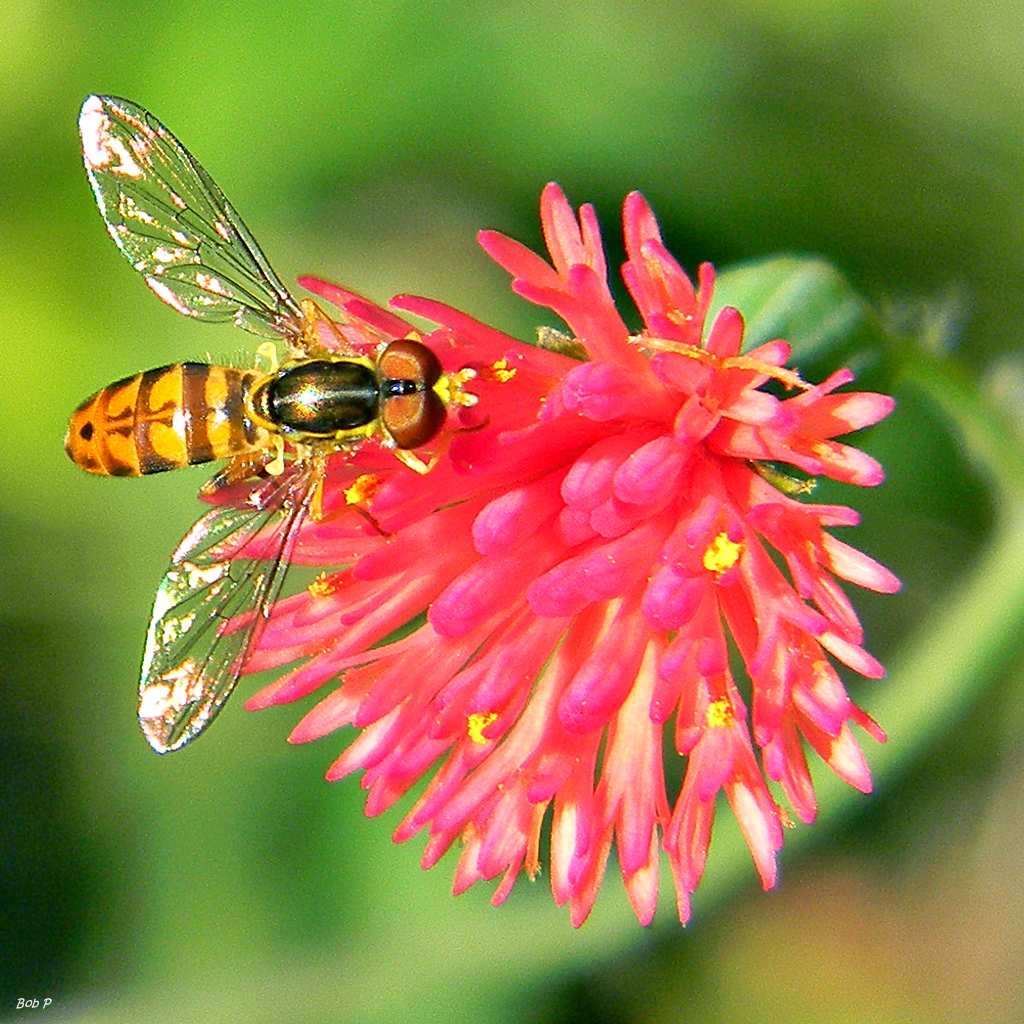
Florida Tasselflower is beneficial to pollinators, attracting bees, butterflies, and hummingbirds. It is particularly valuable to native bees, such as the carpenter bee (Xylocopa virginica) and small native bees, which feed on the nectar of the flowers. Butterflies like the common buckeye (Junonia coenia) are also drawn to the plant.
Additionally, the seeds produced by Florida Tasselflower are eaten by birds, making it an important plant for seed-eating species. The plant provides habitat for small pollinators, enhancing biodiversity in gardens and naturalized spaces.
9. Scarlet Sage (Salvia coccinea)
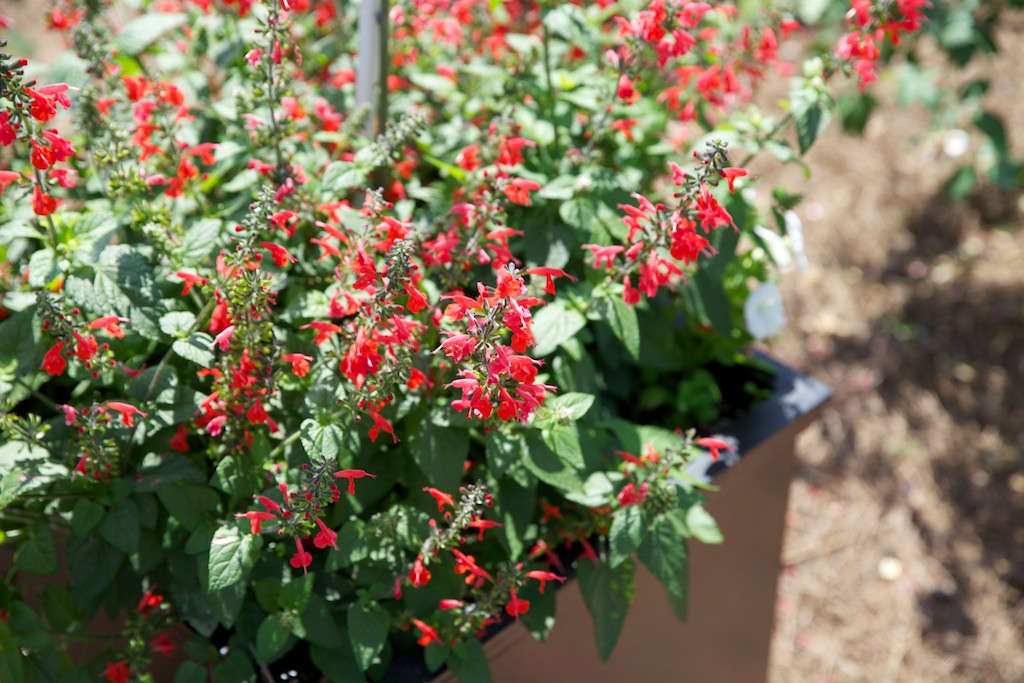
Scarlet Sage is a perennial herb that grows upright with a bushy form. It has lance-shaped, dark green leaves with serrated edges and aromatic foliage. The plant produces clusters of tubular flowers that are bright red, though they can also appear in shades of pink or white in some varieties. The flowers are arranged in spikes that rise above the foliage, attracting a wide variety of pollinators.
Scarlet Sage is typically grown for its striking, vibrant flowers and its ability to thrive in diverse conditions, from garden beds to naturalized areas. This plant’s height and spread make it an excellent choice for attracting pollinators and adding color to garden borders or as a background plant.
Best Growing Region / Zone:
Scarlet Sage grows well in Florida’s USDA hardiness zones 8b to 11, adapting to both tropical and subtropical climates. It is found naturally throughout Florida in disturbed areas, roadsides, and fields, where it thrives in full sun and can withstand the heat and humidity typical of the state.
Preferred Growing Conditions:
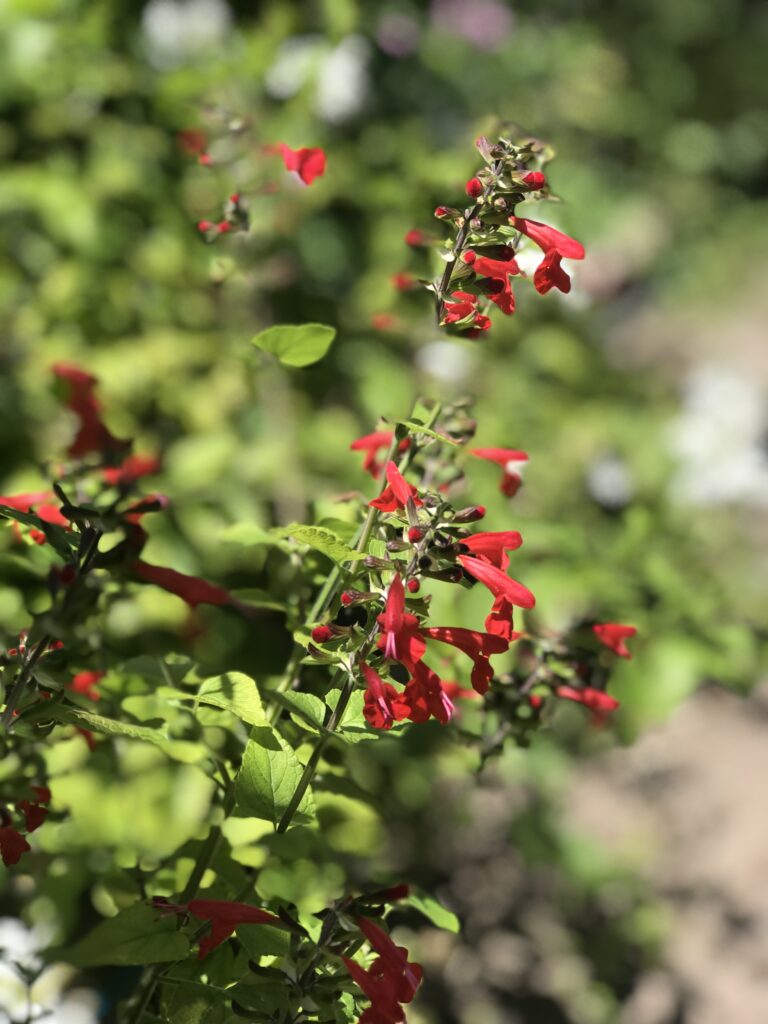
Scarlet Sage prefers full sun and well-drained soils, including sandy, loamy, or even slightly clayey soils. It is highly adaptable to a range of soil types and is tolerant of both drought and occasional flooding, though it performs best with regular moisture. Once established, the plant is relatively low-maintenance, requiring only periodic watering during dry spells. While it does well in sunny locations, it can tolerate partial shade, especially in the hotter parts of Florida.
Height / Spread:
Scarlet Sage typically grows to a height of 2 to 3 feet, with a spread of 1 to 2 feet. It has an upright habit, with flower spikes rising above the foliage to add vertical interest to the garden. Its relatively compact size makes it suitable for garden beds, containers, or as part of a wildflower mix.
Lifespan:
Scarlet Sage is a short-lived perennial in Florida, typically living for 2 to 3 years. It often behaves as an annual in certain conditions, especially when it does not survive colder winters, but it will self-seed and return year after year if the seeds are allowed to mature.
Bloom Period:
Scarlet Sage blooms from spring through winter, with the peak bloom time occurring in the summer. In Zones 10-11, it may even bloom year-round. The plant produces an abundance of red, tubular flowers throughout its bloom period, continuing to attract pollinators into the cooler months. Its vibrant flowers make it a standout in any garden.
Flower Color:
The flowers of Scarlet Sage are typically a striking red, though some varieties may exhibit lighter pink or white hues. The tubular shape of the flowers is characteristic of the Salvia genus, and they are clustered together in spikes that rise above the foliage. The bright red flowers make it a favorite of hummingbirds and bees.
Wildlife Value:
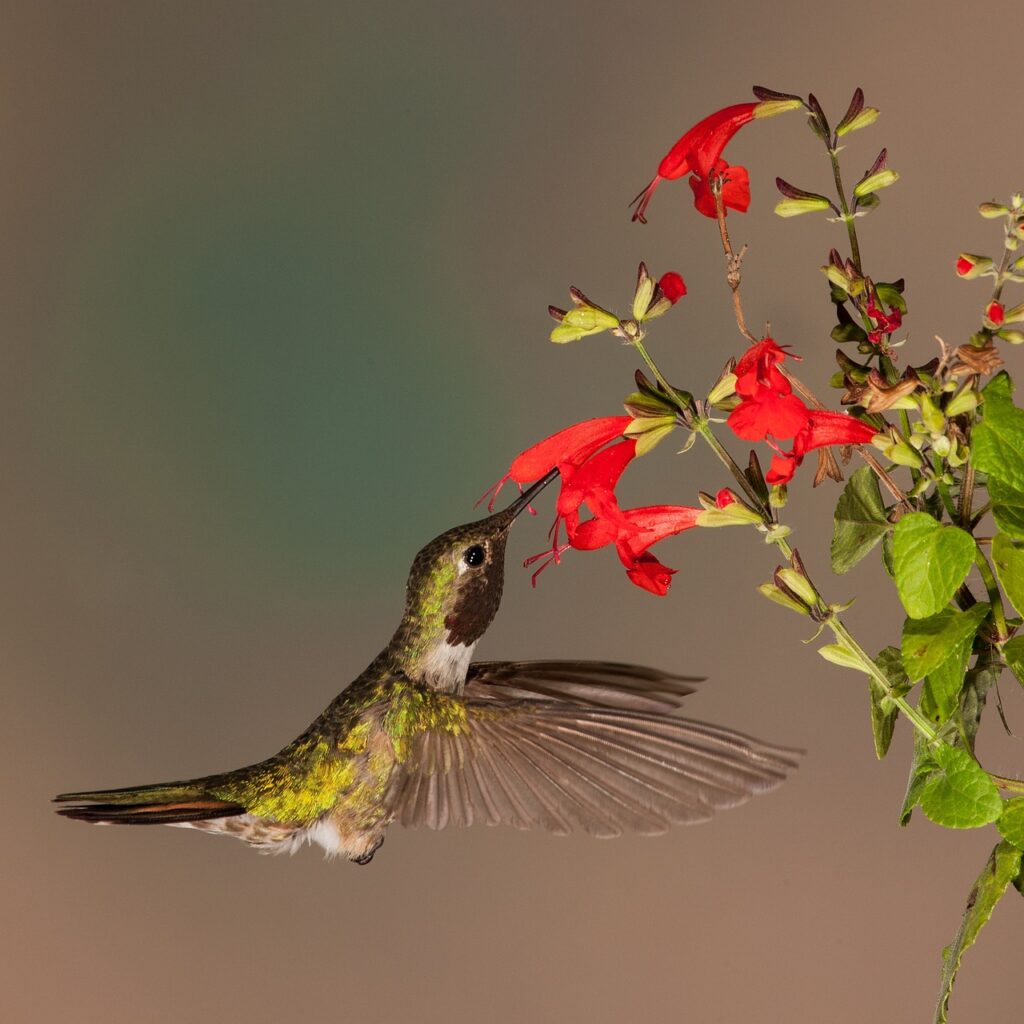
Scarlet Sage is highly beneficial to a range of pollinators, particularly hummingbirds, which are drawn to the plant’s tubular flowers for nectar. It also attracts a variety of native bees, such as honeybees (Apis mellifera) and bumblebees (Bombus species), as well as butterflies like the Gulf Fritillary (Dione juno).
The seeds produced by the plant are eaten by birds, providing additional wildlife value. Overall, Scarlet Sage plays an important role in supporting a healthy pollinator population in Florida gardens.
10. Spotted Beebalm (Monarda punctata)
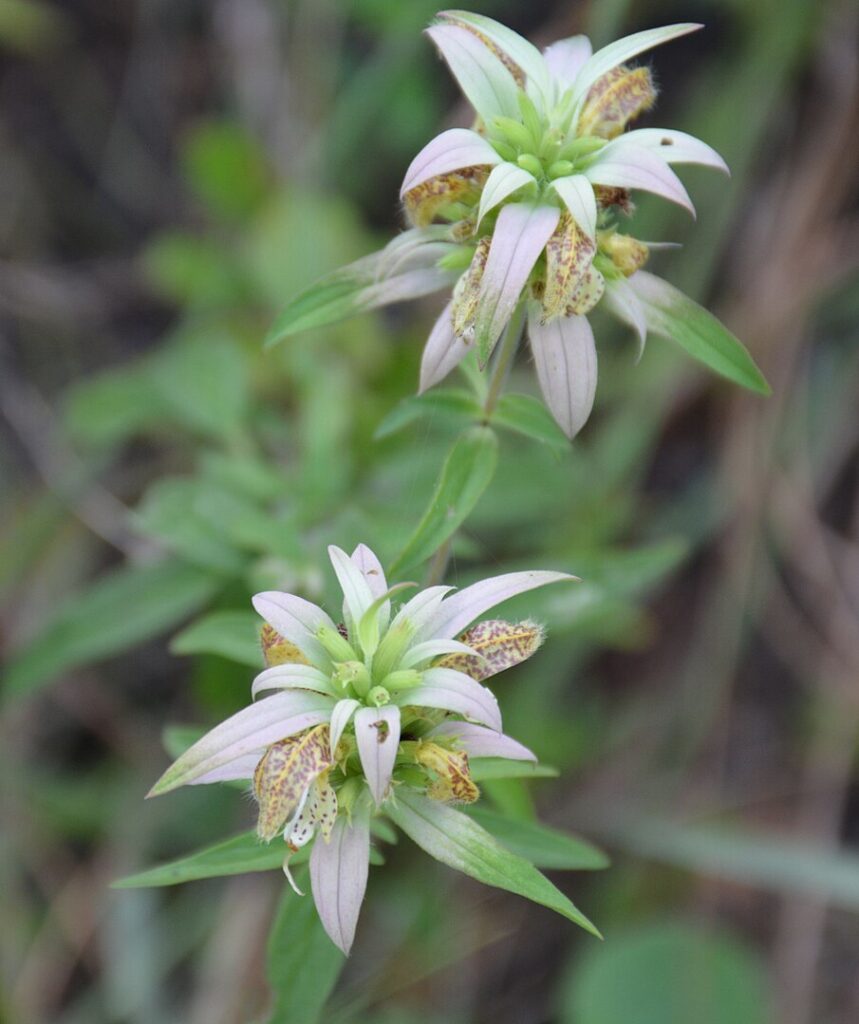
Spotted Beebalm is a perennial herb that forms clumps of upright stems with rough, aromatic foliage. The plant produces unique, tubular flowers that have distinctive purple-spotted yellow bracts, making them stand out in any garden. The flowers are borne in dense clusters at the tops of the stems, surrounded by the showy bracts. The plant has a spreading habit and produces square stems typical of the mint family.
It is relatively tall compared to other wildflowers, and its flowers provide a striking contrast to the surrounding greenery. Spotted Beebalm is commonly used in native plant gardens for its visual interest and its appeal to pollinators.
Best Growing Region / Zone:
Spotted Beebalm thrives in USDA hardiness zones 8a to 10, which includes much of Florida, particularly in areas with moist, well-drained soils. It is found naturally in open, disturbed habitats such as prairies, fields, and roadsides, making it well-suited for Florida’s diverse ecosystems. Its tolerance for a range of conditions makes it adaptable throughout the state.
Preferred Growing Conditions:
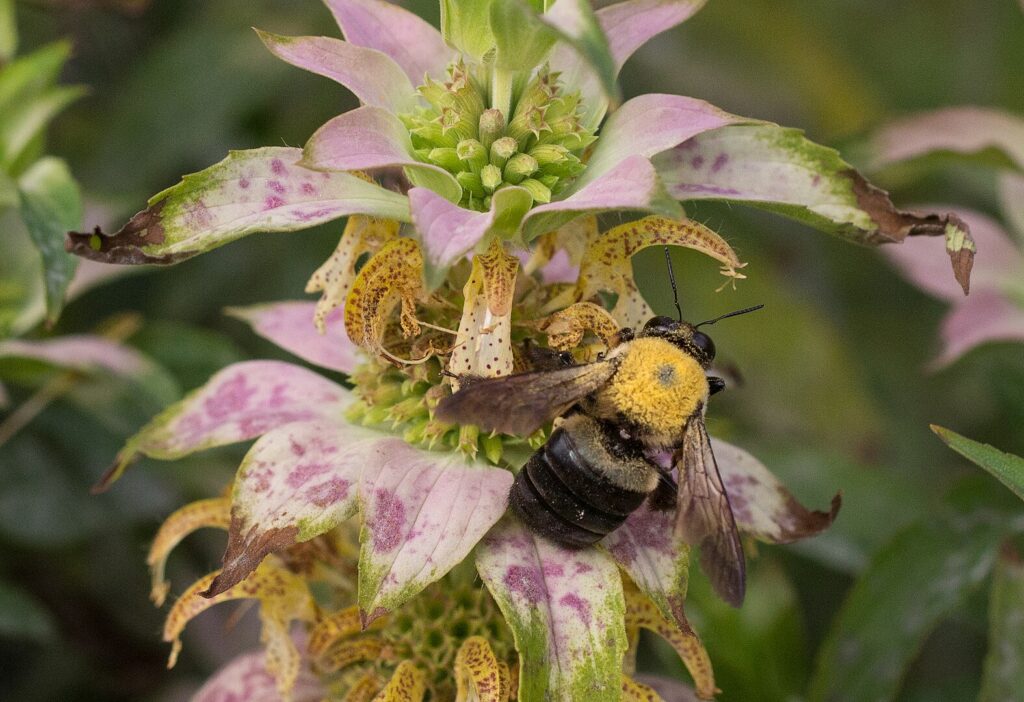
This plant prefers full sun to partial shade and moist, well-drained soils. It is tolerant of a variety of soil types, including sandy and clay soils, but it performs best in loamy soils that are rich in organic matter.
Spotted Beebalm is drought-tolerant once established but benefits from regular watering during dry spells, especially in the warmer months. The plant is also somewhat tolerant of moderate flooding, which makes it ideal for garden areas with fluctuating moisture levels.
Height / Spread:
Spotted Beebalm typically grows to a height of 2 to 3 feet, with a spread of 1 to 2 feet. Its upright, clumping growth habit makes it an excellent background plant or a specimen in garden beds, borders, or naturalized areas. The plant’s bushy nature creates a dense structure that works well for filling in gaps or adding vertical interest to a landscape.
Lifespan:
Spotted Beebalm is a perennial in Florida, living for several years. It is typically long-lived in suitable conditions, though it may die back to the ground in the winter, regenerating from its root system the following spring. It often self-seeds in the wild, ensuring that it can continue to thrive in its native habitat for many seasons.
Bloom Period:
Spotted Beebalm blooms from late spring through the fall, with its peak bloom occurring in the summer. The plant produces abundant clusters of tubular flowers with unique purple-spotted yellow bracts, attracting pollinators throughout its long bloom period. The flowers provide color and nectar for bees, butterflies, and other beneficial insects.
Flower Color:
The flowers of Spotted Beebalm are tubular and pale yellow with prominent purple spots on the bracts that surround the flowers. The contrast between the yellow and purple creates an eye-catching display, making the plant a favorite for pollinators and gardeners alike.
Wildlife Value:
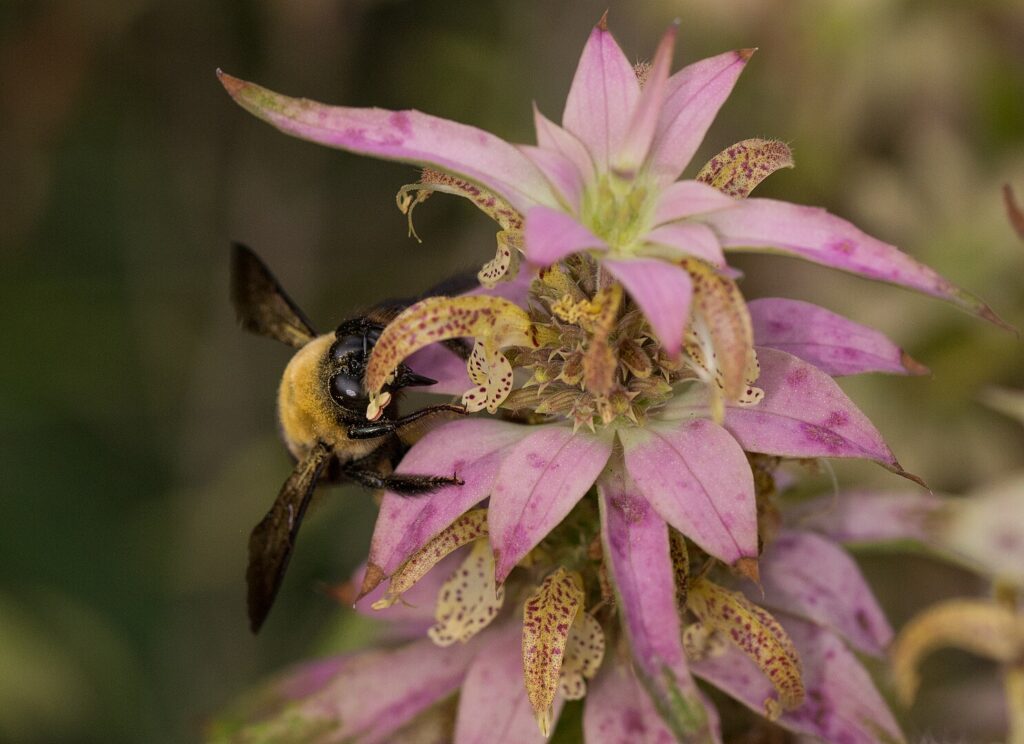
Spotted Beebalm is an important plant for local wildlife, particularly for pollinators such as bees, including native bee species like the honeybee (Apis mellifera) and bumblebees (Bombus species). The plant is also visited by butterflies like the Gulf Fritillary (Dione juno), as well as hummingbirds, which are attracted to the tubular flowers.
The seeds produced by the plant are consumed by birds, contributing to its value as a wildlife-friendly garden addition.
11. Butterfly Milkweed (Asclepias tuberosa)
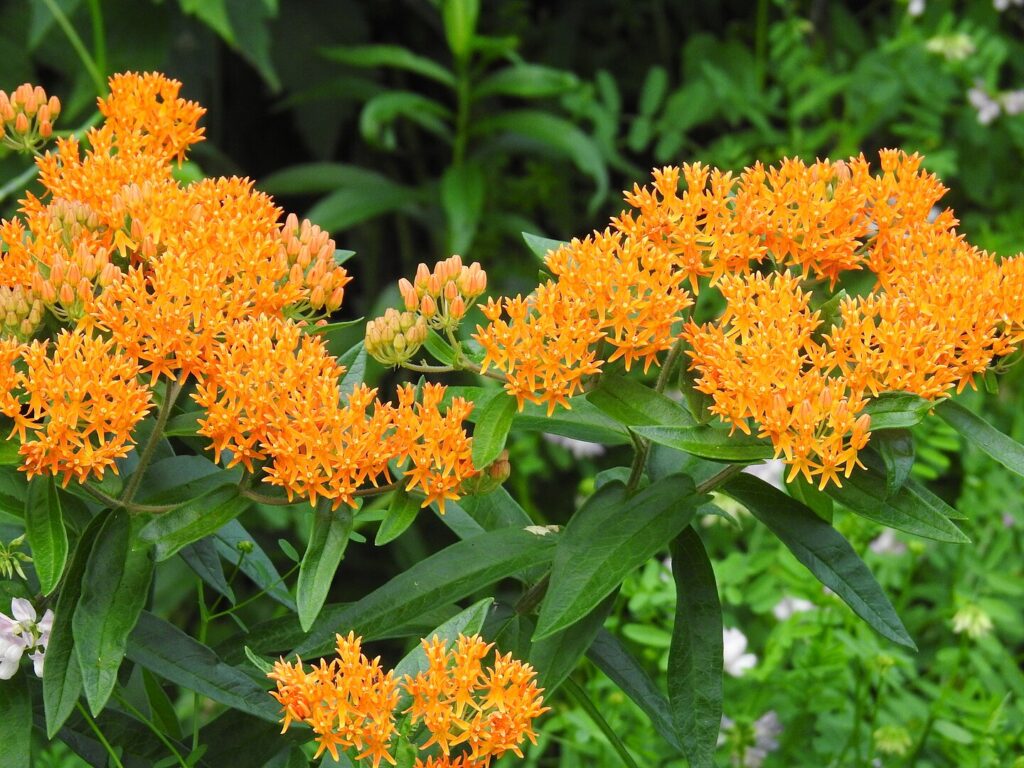
Butterfly Milkweed is a hardy perennial that features bright orange to yellow flowers arranged in dense clusters. The plant has narrow, lance-shaped leaves with a rough texture and grows in an upright, bushy form. It is commonly found in prairies, open fields, and roadsides, where it adds a splash of color to the landscape. Its attractive flowers not only draw attention but are also a vital nectar source for pollinators.
The plant has a taproot system, which makes it drought-tolerant once established but also means it can be more difficult to transplant. The stems of the plant are typically thick and sturdy, providing support for the dense flower clusters.
Best Growing Region / Zone:
Butterfly Milkweed is well-suited for Florida’s climate, thriving in USDA hardiness zones 8a to 10. It grows best in well-drained, sandy or loamy soils and is commonly found in dry, open areas. This species is adapted to Florida’s summer heat and humidity and can be found in a variety of habitats, from coastal plains to inland prairies.
Preferred Growing Conditions:
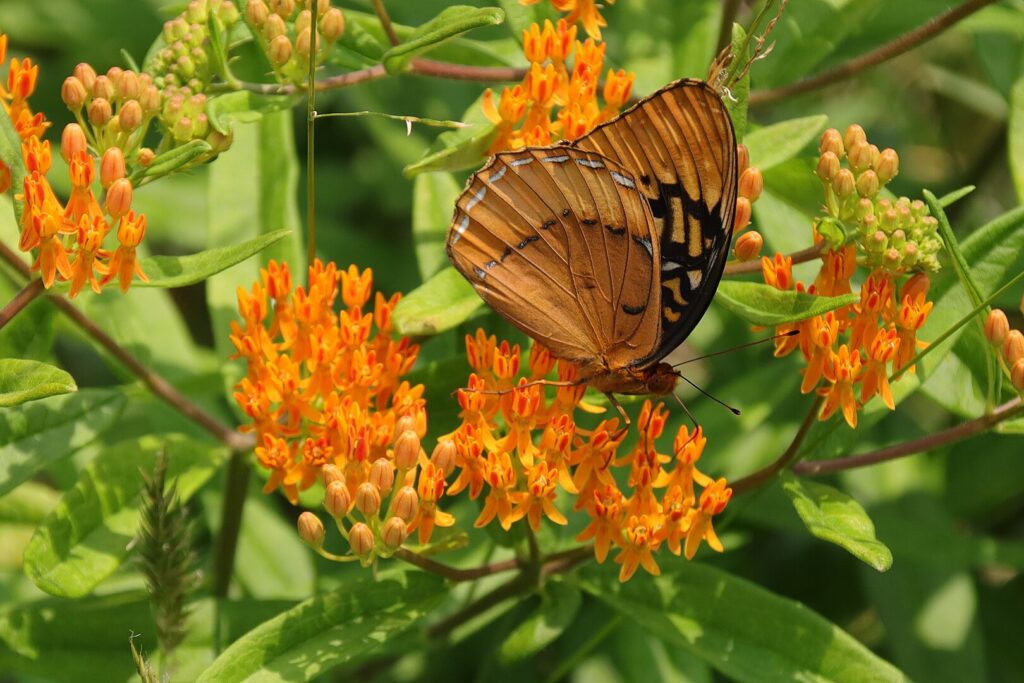
This plant prefers full sun and well-drained soils. It is highly drought-tolerant once established but does not perform well in areas with excessive moisture or poorly drained soils. Butterfly Milkweed is not particular about soil type but benefits from slightly acidic to neutral soils with good drainage.
It thrives in dry, sandy or loamy soils and is ideal for xeriscaping or wildflower gardens. While it is relatively low-maintenance, it will benefit from occasional watering during extended dry periods, especially during the hottest months.
Height / Spread:
Butterfly Milkweed grows to a height of 1 to 2 feet, with a spread of 1 to 1.5 feet. Its compact size makes it suitable for garden beds, wildflower meadows, or as a border plant. It has an upright, clumping growth habit, with a dense, bushy appearance when in full bloom. The plant’s size makes it an excellent choice for attracting pollinators without overwhelming smaller garden spaces.
Lifespan:
Butterfly Milkweed is a perennial in Florida, living for several years. It has a long lifespan and can continue to thrive if planted in the right conditions. The plant may die back to the ground in the winter, but it regenerates from its roots in the spring. It is a self-seeding species, ensuring it will continue to produce new plants in the area year after year.
Bloom Period:
This plant blooms from late spring through the summer, with its peak bloom occurring in early summer. The bright orange to yellow flowers are arranged in tight clusters that attract a variety of pollinators. The flowers are a rich source of nectar for butterflies, bees, and other beneficial insects, making it a valuable addition to any pollinator garden.
Flower Color:
Butterfly Milkweed produces vibrant orange flowers, though yellow varieties can occasionally be found. The flowers are arranged in tight clusters at the tips of the stems, forming a round, globe-like shape. Their bright color makes them highly visible to pollinators, particularly butterflies, and provides a striking contrast against the plant’s green foliage.
Wildlife Value:
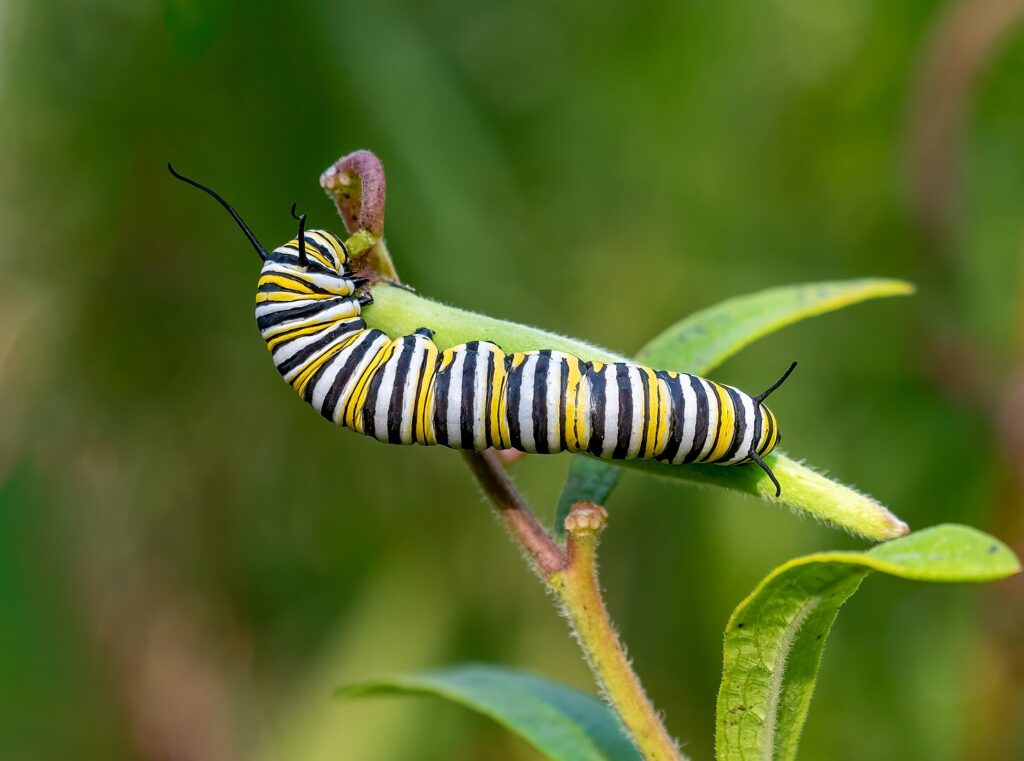
Butterfly Milkweed is an essential nectar source for many pollinators, including butterflies such as the Monarch (Danaus plexippus), Queen (Danaus gilippus), and Gulf Fritillary (Dione juno), as well as bees like the honeybee (Apis mellifera) and native solitary bees. The plant’s flowers attract these species throughout its bloom period, helping to support pollinator populations.
In addition to providing nectar, the plant’s seeds are eaten by birds, contributing to its wildlife value. Butterfly Milkweed is also a host plant for Monarch caterpillars, which feed on its foliage, making it an important part of the Monarch’s life cycle.
12. Blue-eyed Grass (Sisyrinchium angustifolium)
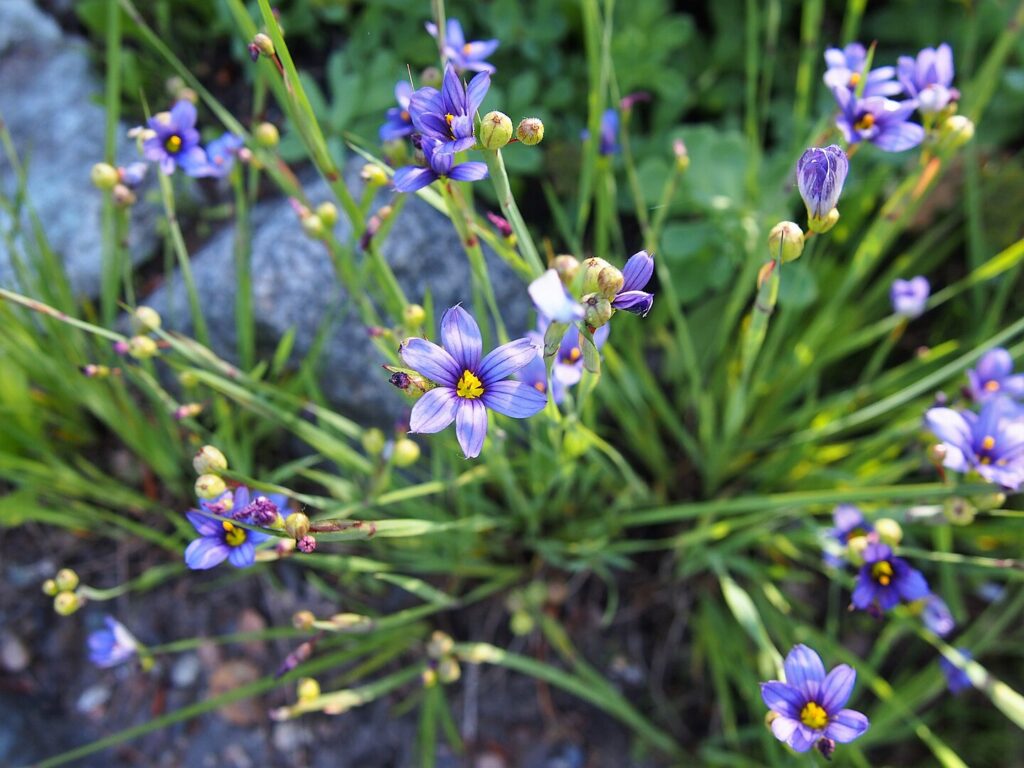
Blue-eyed Grass is a small, herbaceous perennial that produces delicate blue to violet flowers resembling miniature irises. The plant has long, narrow, grass-like leaves that grow in clumps, with flower stalks rising above the foliage. The flowers are typically 1 to 2 inches across, with six petals and a prominent yellow center, creating a striking contrast.
This plant is often found growing in moist, open meadows, prairies, and along roadsides, where it adds subtle color to the landscape. Blue-eyed Grass is well-suited to naturalized areas and wildflower gardens, where its compact size and attractive blooms make it an excellent choice for low-maintenance plantings.
Best Growing Region / Zone:
Blue-eyed Grass thrives in USDA hardiness zones 7 to 10, making it well-suited for most of Florida’s climate. It is commonly found in moist, well-drained soils throughout Florida’s uplands, including prairies, meadows, and roadsides. It thrives in areas with full sun to partial shade, and is a good choice for natural landscapes that require a low-maintenance, native groundcover.
Preferred Growing Conditions:
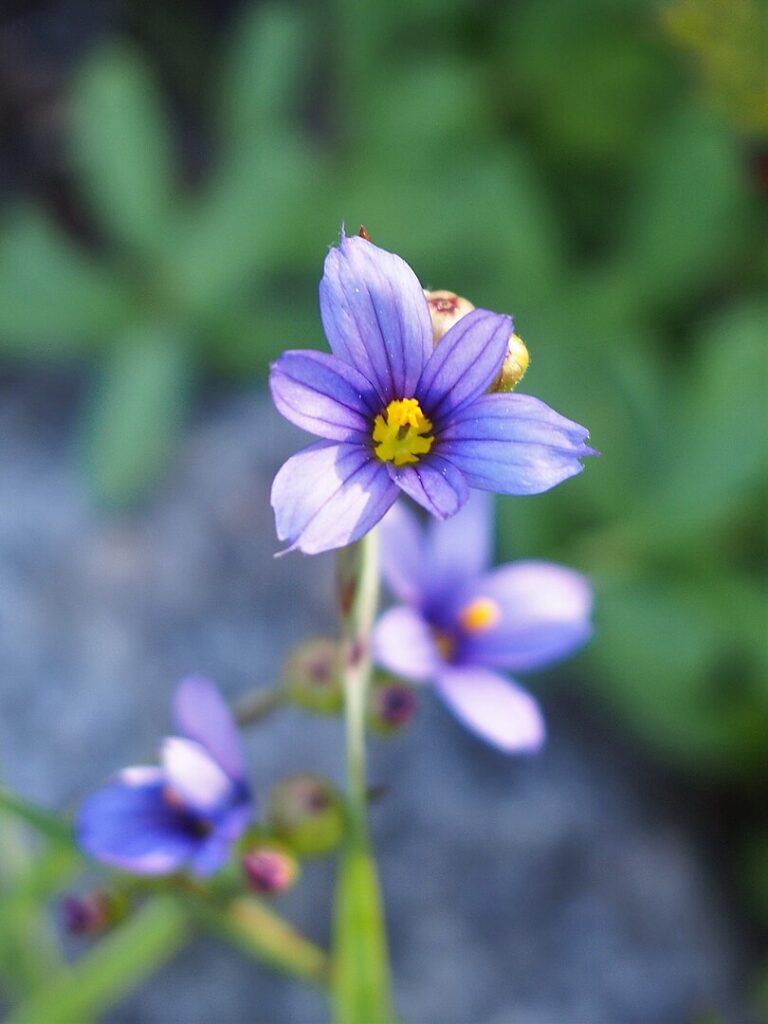
This plant thrives in full sun to light shade and prefers moist, well-drained soils. While it can tolerate some drought once established, it does best in areas with consistent moisture, such as along the edges of ponds or in wet meadows.
Blue-eyed Grass is adaptable to a variety of soil types, including sandy or loamy soils, but it performs best in soils that are kept relatively moist. Once established, it requires minimal care and can handle occasional periods of dry conditions.
Height / Spread:
Blue-eyed Grass grows to a height of about 12 to 18 inches, with a spread of around 6 to 12 inches. Its compact size makes it well-suited for use in wildflower gardens, rock gardens, or as an edging plant. The plant has a clumping habit, and when in bloom, it forms a striking, colorful display that stands above its grass-like foliage.
Lifespan:
Blue-eyed Grass is a perennial, living for several years in the right conditions. It can self-seed, which allows it to spread and naturalize over time, though it may not always be as prolific as other species. It is relatively low-maintenance and can be left to grow and reseed without much intervention.
Bloom Period:
Blue-eyed Grass typically blooms from early spring to late spring, with the peak bloom occurring in late spring. The flowers bloom in succession, with new flowers opening up along the stem as older ones fade, providing a long-lasting display of color. The plant’s flowers are particularly attractive to small bees and other pollinators during its bloom period.
Flower Color:
The flowers are a vibrant blue to violet color, with a distinctive yellow center that stands out against the petals. The flowers are shaped like small irises, with six petals that form a star-like shape. Their bright color and distinctive appearance make Blue-eyed Grass a striking addition to any garden or landscape.
Wildlife Value:
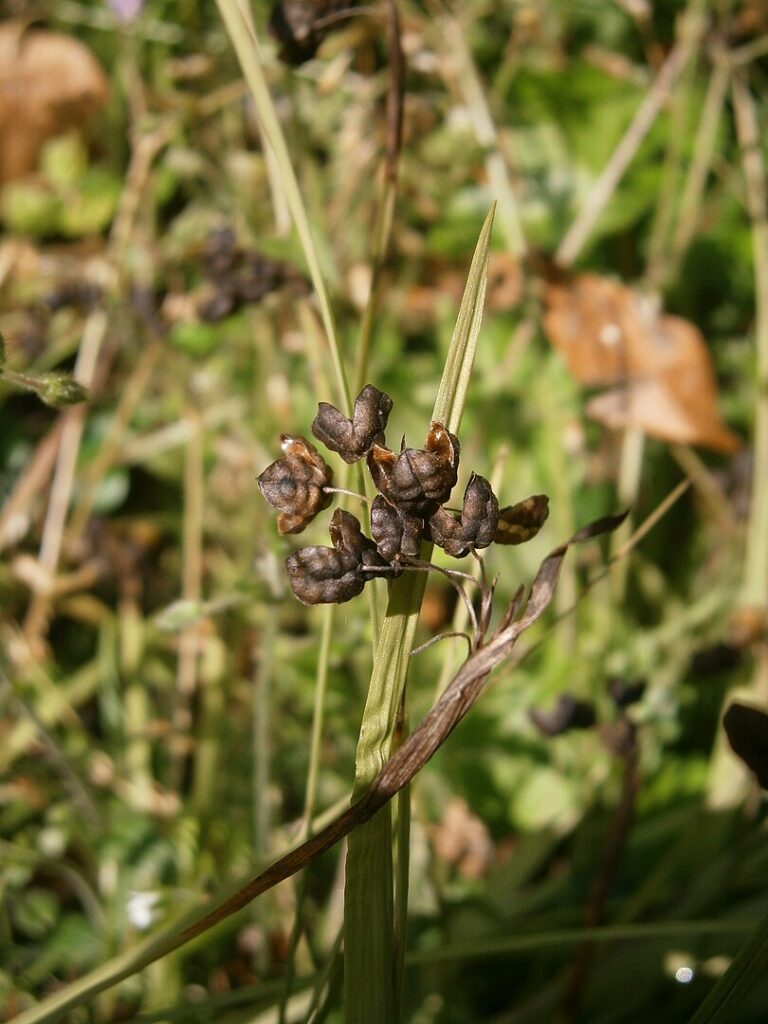
Blue-eyed Grass is a valuable plant for pollinators, particularly small bees and butterflies. The plant’s flowers provide nectar and attract a variety of insect pollinators during its bloom period.
Additionally, the seeds produced by Blue-eyed Grass are eaten by birds, providing an important food source for seed-eating species. Its compact size and attractive flowers make it a good choice for adding diversity to pollinator-friendly landscapes.
13. Swamp Sunflower (Helianthus angustifolius)
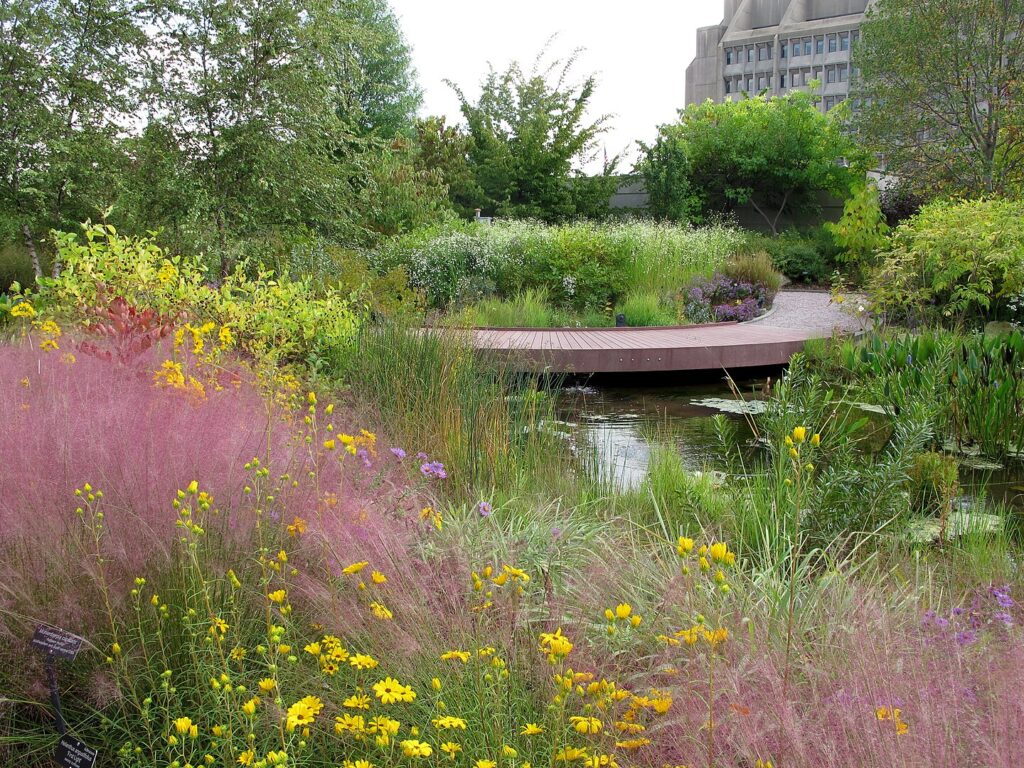
Swamp Sunflower is a tall, upright perennial that thrives in moist to wet conditions. It has narrow, lance-shaped leaves and produces clusters of bright yellow flowers with dark centers that resemble the traditional sunflower, though on a smaller scale. The plant has an airy, open habit, with its multiple stems branching upward, typically reaching 4 to 6 feet in height.
Swamp Sunflower is commonly found in wetlands, swamps, and along the edges of streams, where it adds a splash of color to these habitats. It is an excellent choice for rain gardens, naturalized areas, or as a tall background plant in native plant gardens.
Best Growing Region / Zone:
Swamp Sunflower thrives in USDA hardiness zones 8 to 10, making it well-suited for Florida’s climate. It is commonly found in Florida’s wetland areas, including swamps, marshes, and along streambanks. It can tolerate occasional flooding and is an excellent choice for planting in moist or seasonally wet soils.
Preferred Growing Conditions:
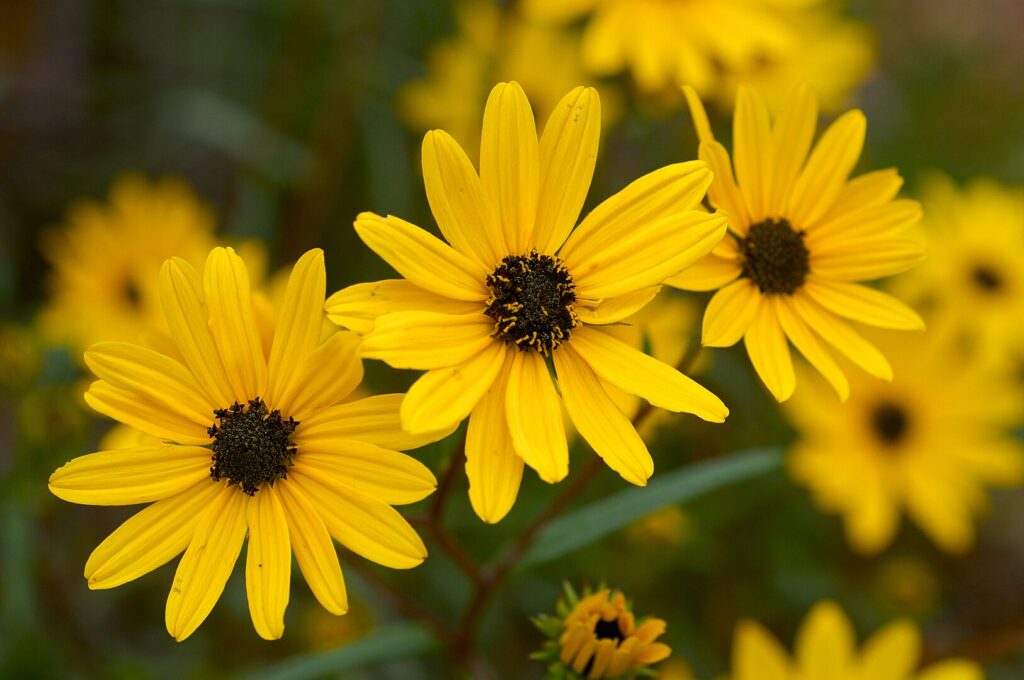
This plant prefers full sun but can tolerate some light shade, especially in hotter parts of Florida. Swamp Sunflower thrives in moist to wet soils, including those in rain gardens or along water features, and it can tolerate standing water for short periods.
It does best in soils that are rich in organic matter but is adaptable to a variety of soil types, including sandy and loamy soils. Once established, it is relatively drought-tolerant but benefits from regular moisture, especially during prolonged dry spells.
Height / Spread:
Swamp Sunflower grows to a height of 4 to 6 feet, with a spread of 2 to 3 feet. Its tall, open habit makes it an excellent plant for the back of borders or as a striking vertical element in a naturalized landscape. The plant’s height and spreading habit allow it to create a bright, yellow backdrop when in full bloom.
Lifespan:
Swamp Sunflower is a perennial, living for several years in the right conditions. It may die back in colder winter months but will regenerate from the root system in the spring. Its long lifespan makes it an excellent choice for a permanent fixture in wetland or water-side plantings.
Bloom Period:
Swamp Sunflower blooms from late summer through fall, with peak bloom typically occurring in September and October. The plant produces numerous small yellow flowers arranged in large, branching clusters that provide an extended bloom period, often lasting into the cooler months.
Flower Color:
The flowers are a brilliant yellow with a dark brown to black center, resembling the classic sunflower but smaller in size. The flowers are arranged in loose clusters, and their bright yellow color stands out against the narrow green leaves, creating a cheerful display that attracts pollinators.
Wildlife Value:
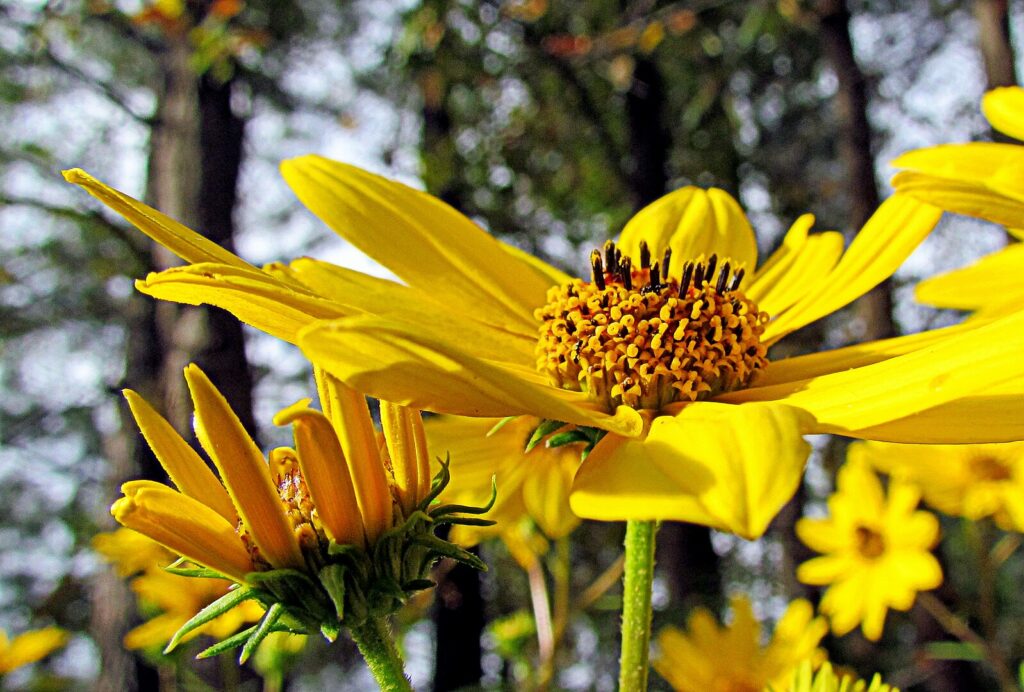
Swamp Sunflower is an important plant for a variety of pollinators, including native bees, butterflies, and other insects. The flowers provide nectar and pollen for these pollinators, and the seeds are consumed by birds, such as finches, sparrows, and other seed-eating species.
The plant’s tall structure also offers shelter for small wildlife, making it an important component of a diverse, wildlife-friendly garden or landscape.
14. Pineland Lantana (Lantana depressa)
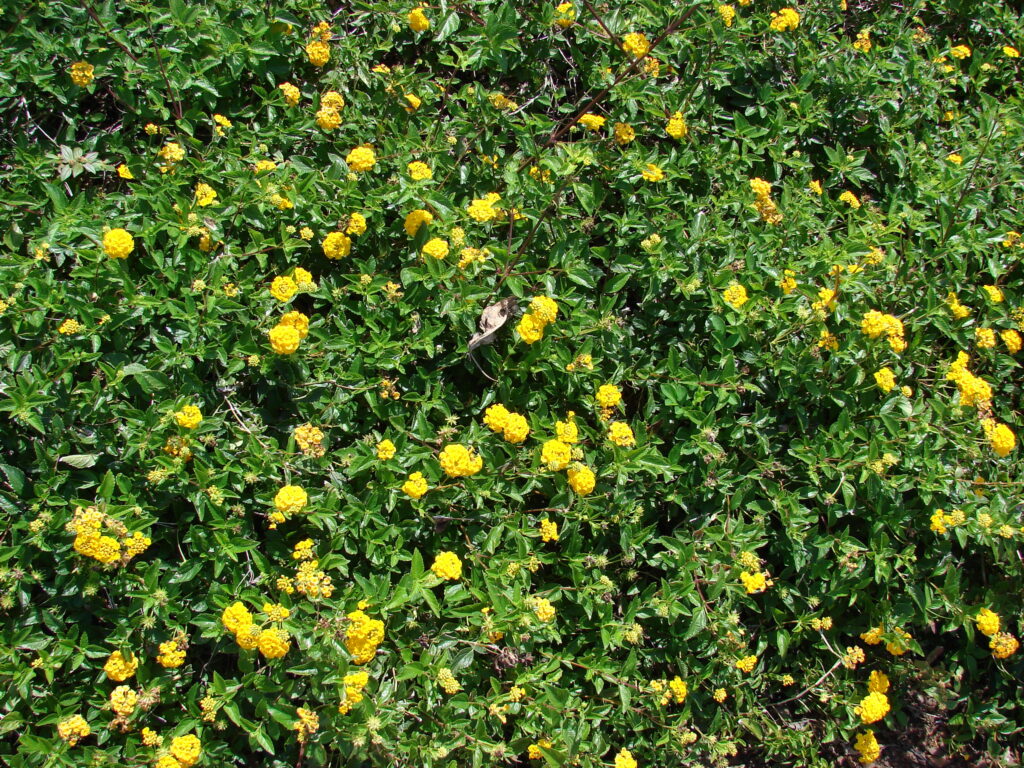
Pineland Lantana is a low-growing, spreading perennial shrub native to Florida’s upland habitats. It has fragrant, lance-shaped leaves that are covered with fine hairs, and it produces small clusters of brightly colored flowers that range from yellow to orange, eventually turning pink as they mature. These flowers are arranged in tight, rounded clusters, attracting pollinators.
The plant has a spreading, ground-covering habit, making it an excellent choice for filling in gaps in native landscapes or for use as a ground cover in sunny locations. It is drought-tolerant and thrives in well-drained soils.
Best Growing Region / Zone:
Pineland Lantana is found in USDA hardiness zones 8a to 11, making it suitable for Florida’s climate, particularly in the central and southern parts of the state. It is commonly found in dry pinelands and scrub habitats, where it grows in sandy soils and areas that receive full sun. This species is well adapted to the conditions of Florida’s uplands and can tolerate heat and drought.
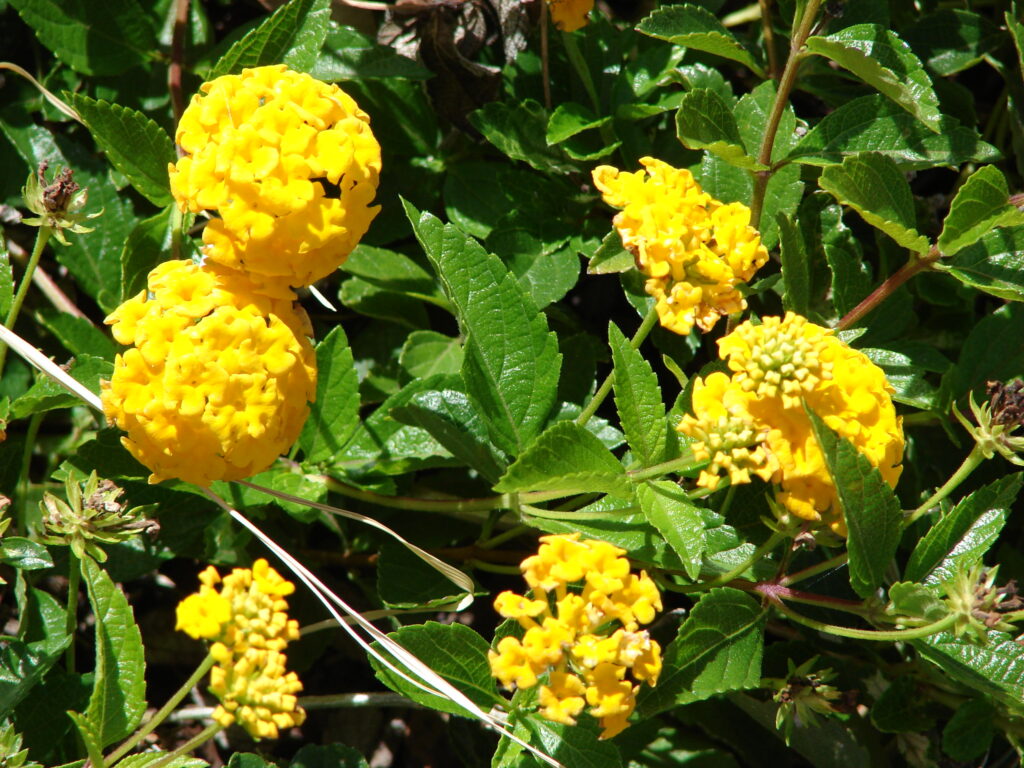
Preferred Growing Conditions:
This plant thrives in full sun and well-drained sandy or loamy soils, making it ideal for dry, sandy landscapes and coastal areas. It is highly drought-tolerant once established and performs well in poor soils with low fertility, making it perfect for xeriscaping or native plant gardens.
Pineland Lantana prefers dry to moderately moist conditions and is well-suited for areas where water is not regularly available, though it can tolerate some irrigation during extended dry periods. It is a heat-tolerant plant that does not require heavy watering once established.
Height / Spread:
Pineland Lantana typically grows to a height of 1 to 2 feet with a spread of 3 to 4 feet. Its spreading, ground-hugging habit makes it an excellent choice for ground cover or for planting in areas where a low, dense plant is needed to fill in space. The plant’s width allows it to cover a large area quickly, making it useful for erosion control in dry landscapes.
Lifespan:
This plant is a perennial, living for several years in its native habitat. Pineland Lantana is hardy in Florida’s hot and dry conditions, often surviving for multiple seasons with minimal care. It may experience dieback during particularly cold winters but will generally regenerate from its root system when temperatures rise in the spring.
Bloom Period:
Pineland Lantana blooms from spring through fall, with its peak bloom occurring during the warmer months. The plant produces colorful clusters of flowers from early spring through late autumn, with flowers changing color as they age, creating a continuous, vibrant display of yellow, orange, and pink hues.
Flower Color:
The flowers of Pineland Lantana are small and clustered, with a color range that transitions from yellow to orange and eventually to pink as they mature. This color change creates an eye-catching display, with different stages of flowers blooming at once in the same cluster. The bright, multicolored flowers attract a variety of pollinators, including bees and butterflies.
Wildlife Value:
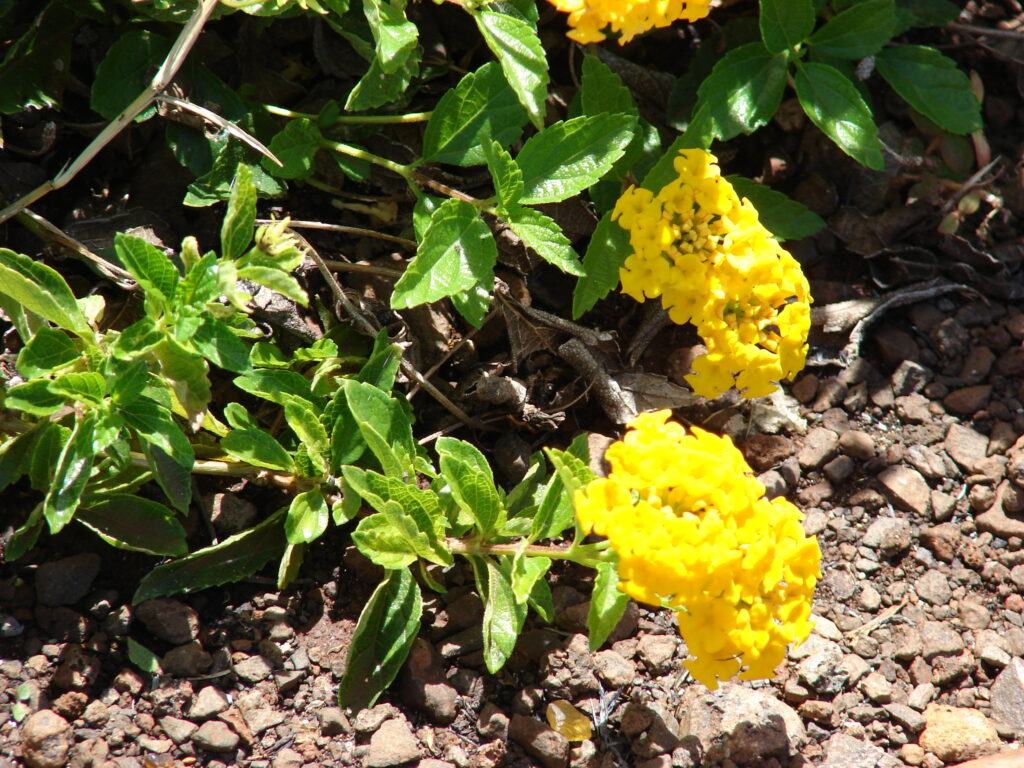
Pineland Lantana is highly attractive to pollinators, especially native bees, butterflies, and hummingbirds. The flowers provide nectar for a wide range of species, including the Zebra Longwing butterfly (Dione zebra) and the Great Purple Hairstreak (Atlides halesus), both of which are native to Florida.
The plant’s berries, when they develop, are also consumed by various bird species, including finches and sparrows. Pineland Lantana plays a key role in supporting a diverse range of wildlife in native plant gardens and xeriscapes.
15. Lyreleaf Sage (Salvia lyrata)
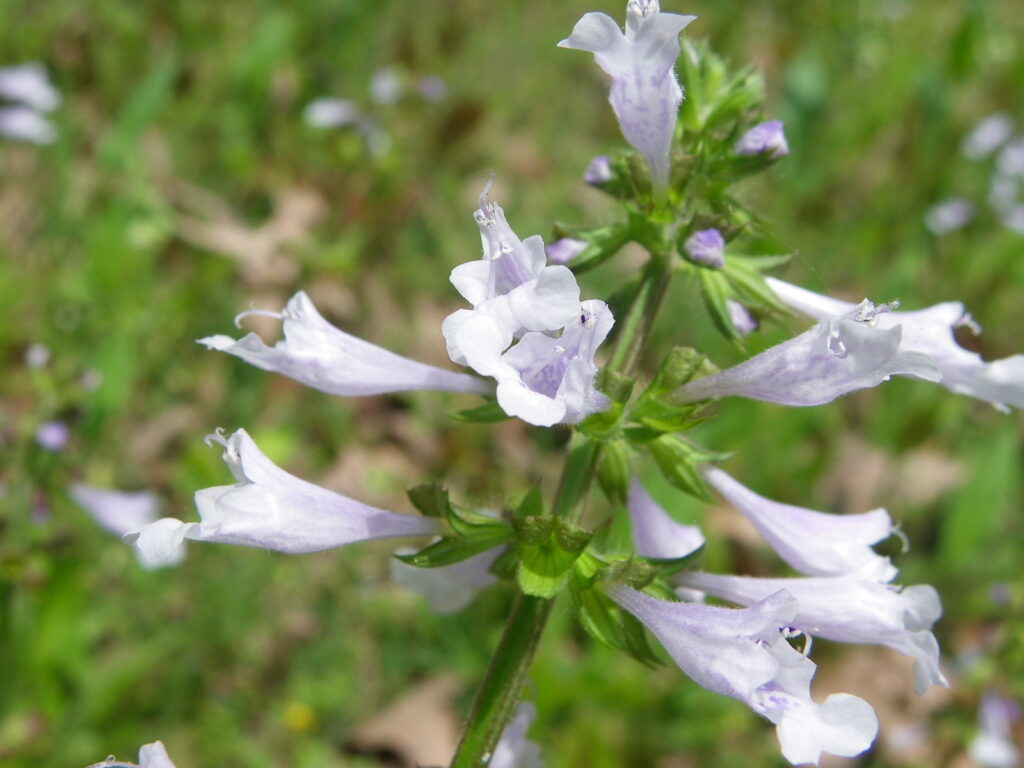
Lyreleaf Sage is a low-growing, perennial herb native to Florida’s sandy and forested areas. It has distinctive, dark green leaves that are shaped like the outline of a lyre, hence the name. The plant produces tall spikes of tubular purple flowers that are clustered at the top, which bloom in the spring and early summer.
The plant has a minty fragrance when disturbed, characteristic of the Salvia family. Lyreleaf Sage is often found in moist, well-drained soils, making it a good choice for rain gardens or wildflower gardens. It is also known for its ability to attract pollinators.
Best Growing Region / Zone:
Lyreleaf Sage is well-suited for USDA hardiness zones 7a to 11 and is native to the southeastern United States, including Florida. It grows in a variety of habitats, from sandy roadsides to pine forests and wetlands, thriving in the subtropical climate of Florida’s central and northern regions.
Preferred Growing Conditions:
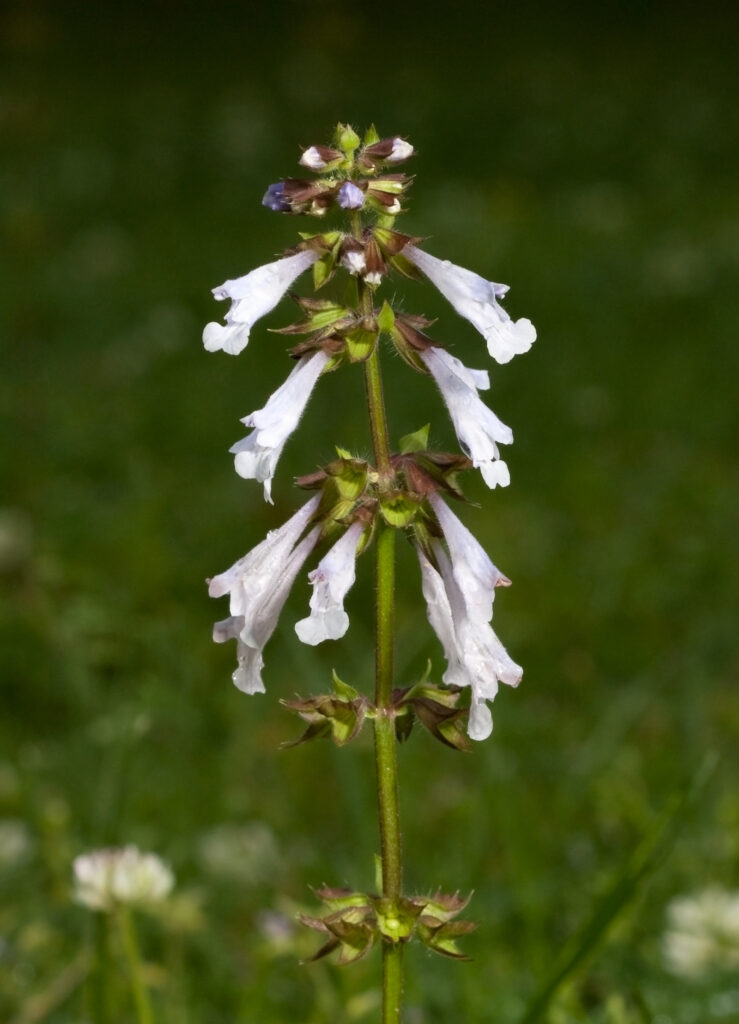
This plant prefers partial to full sun and well-drained, moist soils. It is tolerant of a variety of soil types, including sandy, loamy, and clay-rich soils. Lyreleaf Sage thrives in environments that receive regular rainfall but can also tolerate short periods of drought once established.
It benefits from occasional irrigation during drier times, especially during the blooming season. It also appreciates some protection from hot afternoon sun in the warmer regions of Florida, where it can tolerate light shade during the hottest months.
Height / Spread:
Lyreleaf Sage typically grows 1 to 2 feet tall and spreads about 1 to 2 feet in width. The plant’s compact size makes it an excellent choice for garden borders, mixed perennial beds, or as a low-growing accent plant in wildflower gardens. It forms a rosette of basal leaves, with flower spikes rising above the foliage during the blooming period.
Lifespan:
Lyreleaf Sage is a perennial, meaning it will return year after year in the right conditions. It has a relatively long lifespan for a native wildflower, often persisting for several years in the garden or natural landscape. In colder winters, it may experience dieback, but it will regenerate from the roots when temperatures rise in the spring.
Bloom Period:
The blooming period for Lyreleaf Sage is from early spring to early summer, with the peak bloom occurring in late spring. During this time, the plant produces showy spikes of tubular purple flowers that are highly attractive to pollinators. The flowers typically bloom in succession, providing a long-lasting display of color in the landscape.
Flower Color:
The flowers of Lyreleaf Sage are a deep lavender to purple, arranged in dense clusters along tall spikes. The tubular flowers are highly attractive to bees and hummingbirds, who visit the flowers for their nectar. The purple color stands out against the dark green, lyre-shaped foliage, creating an appealing contrast in garden settings.
Wildlife Value:
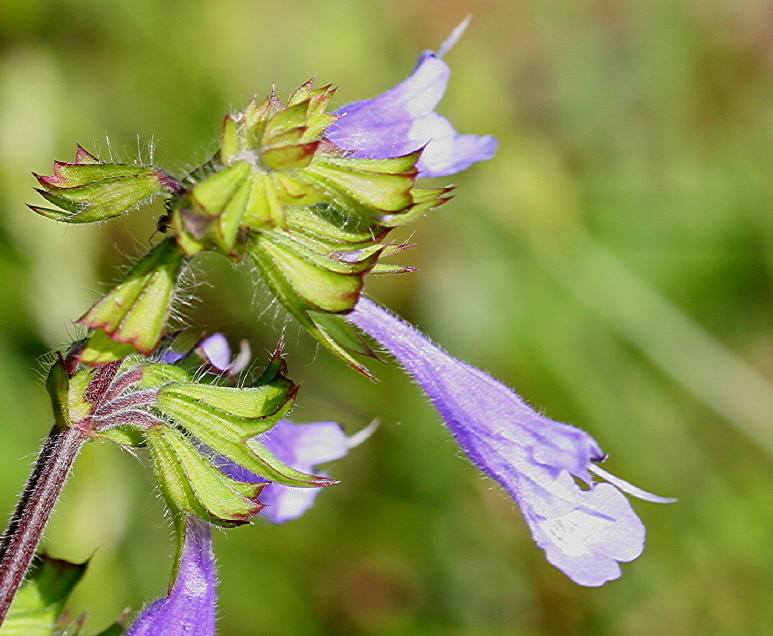
Lyreleaf Sage is an excellent plant for attracting pollinators, particularly bees, butterflies, and hummingbirds. Native bee species, including honeybees and bumblebees, are frequent visitors to the flowers. The plant is also important for butterfly species such as the Common Buckeye (Junonia coenia) and the Red-banded Hairstreak (Calycopis cecrops).
The plant’s dense foliage provides shelter for small insects and larvae, making it a valuable addition to wildlife-friendly gardens. Additionally, the seeds of Lyreleaf Sage can attract birds, particularly during the winter months.
16. Scarlet Hibiscus (Hibiscus coccineus)
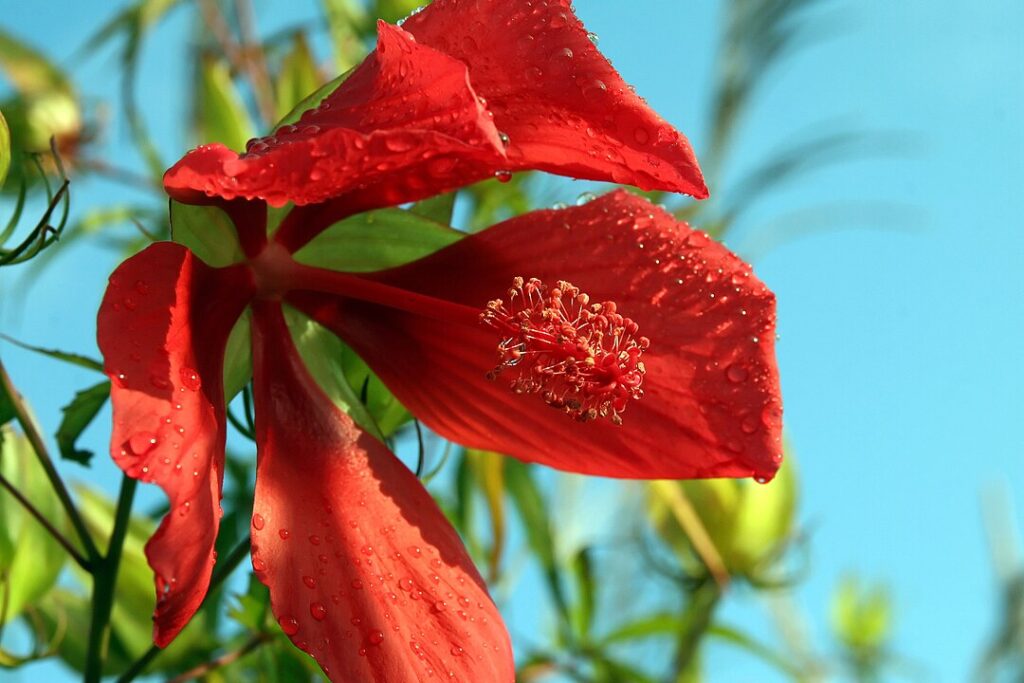
Scarlet Hibiscus is a large, striking perennial that produces large, bright red flowers with prominent, long stamens. The plant has deeply lobed, dark green leaves that are often a bit rough to the touch. It grows as a tall shrub or herbaceous perennial, and its flowers can be up to 6 inches across, blooming at the top of long, slender stems.
This species thrives in moist, well-drained soils, particularly in wetlands, along pond edges, and in rain gardens. Its showy red flowers create a dramatic splash of color, especially during the warm months of the growing season.
Best Growing Region / Zone:
Scarlet Hibiscus thrives in USDA hardiness zones 7a to 11. In Florida, it is found in the northern, central, and coastal regions, particularly in areas with abundant moisture such as wetlands, stream banks, and the edges of ponds. It grows best in areas with high humidity and frequent rainfall, which are common conditions in Florida’s subtropical to tropical climate.
Preferred Growing Conditions:
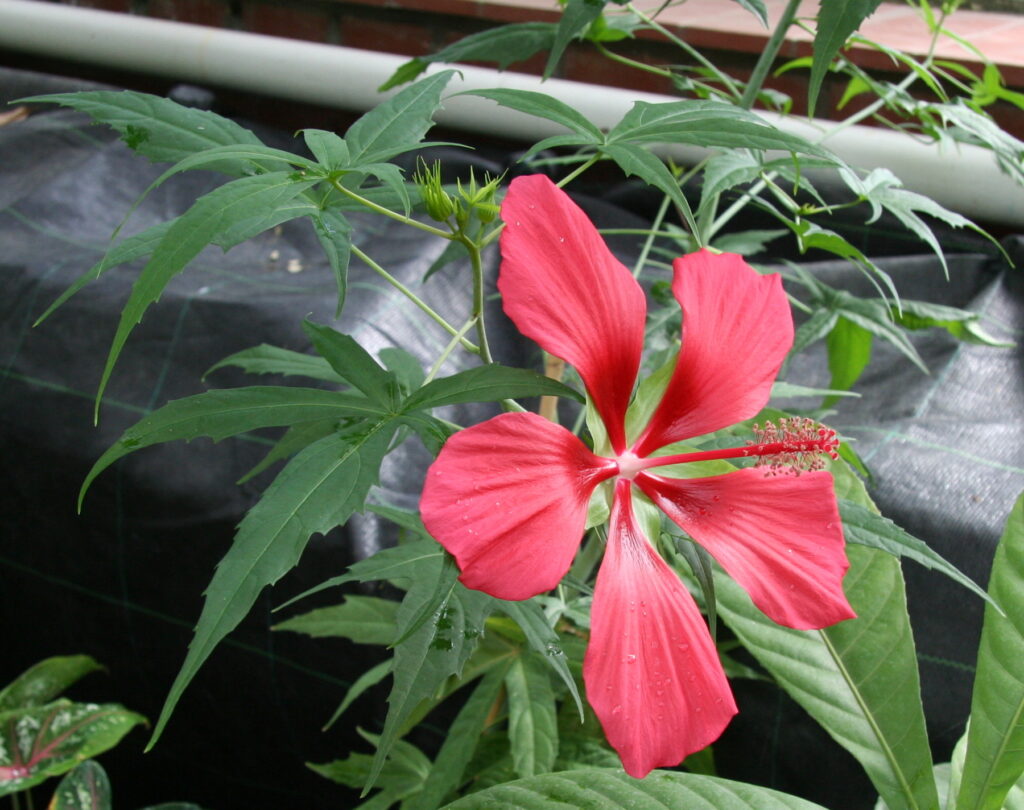
This plant prefers full sun to partial shade, with plenty of moisture. It thrives in wet soils and is ideal for rain gardens, boggy areas, and pond edges. Scarlet Hibiscus can tolerate occasional drought once established but requires consistent moisture for optimal growth.
It is well-suited for Florida’s humid climate and can tolerate high heat, making it a great choice for summer bloom in Florida gardens. Soil should be slightly acidic to neutral, and the plant may benefit from occasional fertilization to encourage strong flowering.
Height / Spread:
Scarlet Hibiscus can grow from 4 to 6 feet tall, with a spread of about 3 to 4 feet. Its large, upright stems make it an excellent background or focal plant in garden beds or naturalized landscapes. It’s often used in landscapes where its bold flowers can make an impact, but it also serves well as a screen or a border plant.
Lifespan:
Scarlet Hibiscus is a perennial that can live for several years in Florida, returning each spring from its root system. It may experience some dieback during the colder months but will regenerate once temperatures warm up. It’s considered a long-lived perennial in suitable conditions.
Bloom Period:
The blooming period of Scarlet Hibiscus occurs from late spring through the summer, with the peak bloom in the warmer months. The plant produces large, showy red flowers that last for a day or two, but new flowers continuously open over the blooming period. The flowers attract pollinators, including hummingbirds and butterflies, and provide a stunning display.
Flower Color:
The flowers of Scarlet Hibiscus are a bright, vibrant red with a central cluster of long, yellow stamens. Each flower can be up to 6 inches across, making it one of the more striking native hibiscus species. The deep red petals contrast beautifully with the green foliage, especially during the plant’s blooming season.
Wildlife Value:
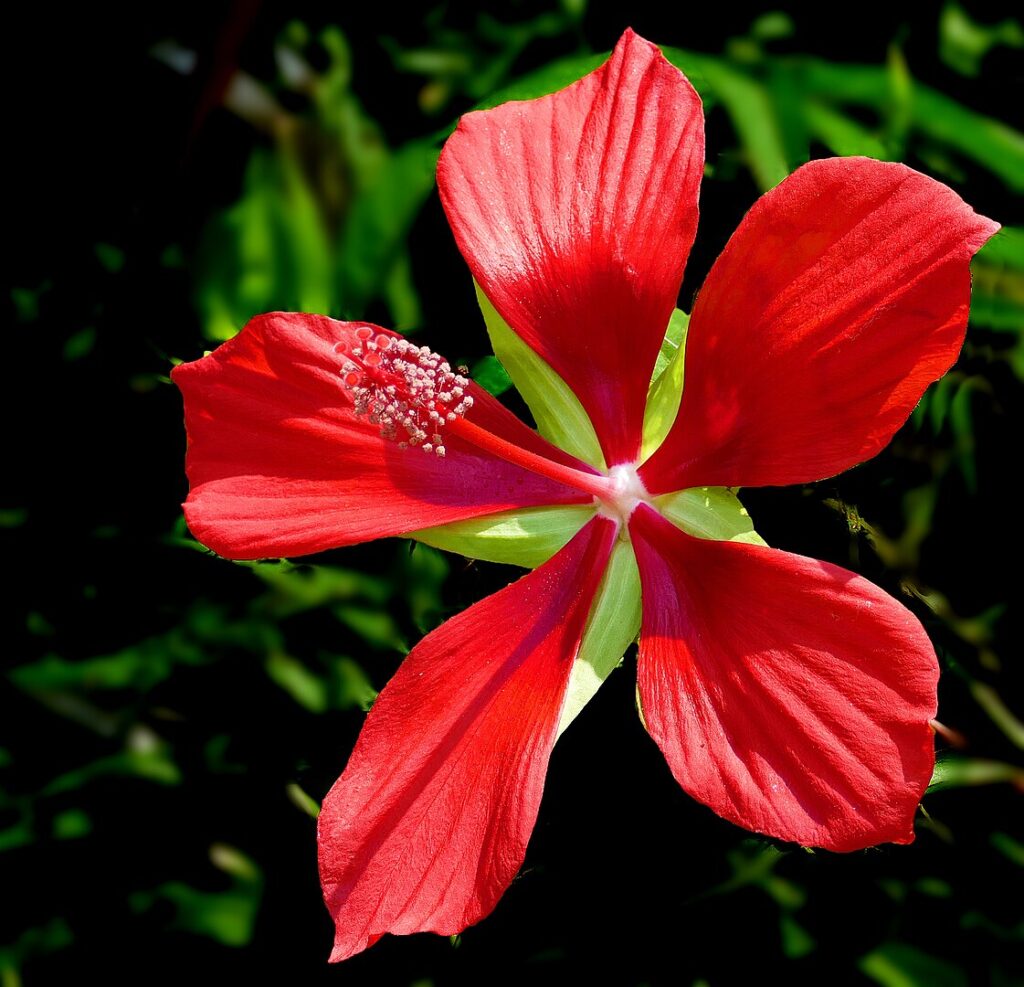
Scarlet Hibiscus is a valuable plant for pollinators. Its large, showy flowers are highly attractive to hummingbirds, which are drawn to the bright red color and rich nectar. Butterflies, including species like the Gulf Fritillary (Dione juno) and the Zebra Longwing (Dione idalia), also visit the flowers for nectar.
The plant’s leaves may provide shelter for various insects, and the seeds are consumed by birds, adding to its ecological value in the landscape. Its ability to thrive in moist, wet conditions also makes it important for supporting aquatic or riparian wildlife.
17. Swamp Milkweed (Asclepias incarnata)
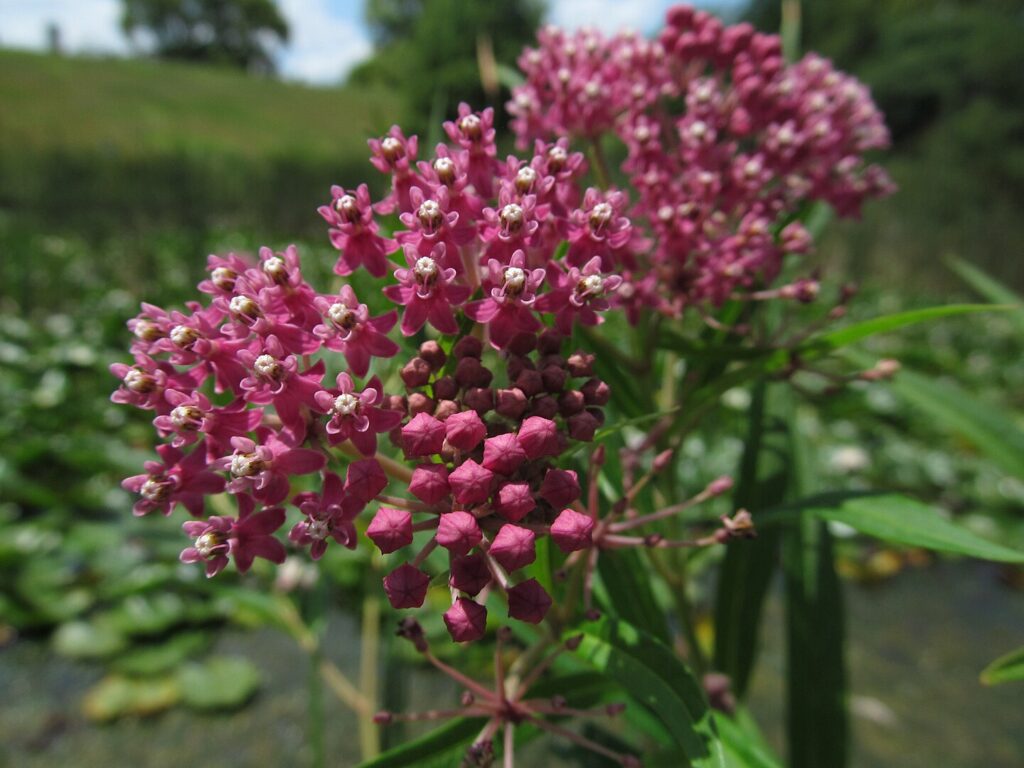
Swamp Milkweed is a perennial herb with narrow, lance-shaped leaves that are typically arranged in opposite pairs along the stems. The plant grows tall, with slender stems that reach up to 3 feet in height. Its flowers are clusters of small, star-shaped pink blooms with five petals and a characteristic five-lobed crown.
The plant has a smooth, upright growth habit and is known for its ability to thrive in moist, boggy soils. Swamp Milkweed produces attractive blooms in large clusters, which make it a striking addition to wetland gardens or naturalized landscapes.
Best Growing Region / Zone:
Swamp Milkweed is well-suited to USDA hardiness zones 7a to 11. In Florida, it is typically found in the central and northern regions, particularly in wetland areas, along stream banks, and in areas with consistently moist soil. It thrives in Florida’s humid climate, especially in locations that receive regular rainfall and in soils that retain moisture.
Preferred Growing Conditions:
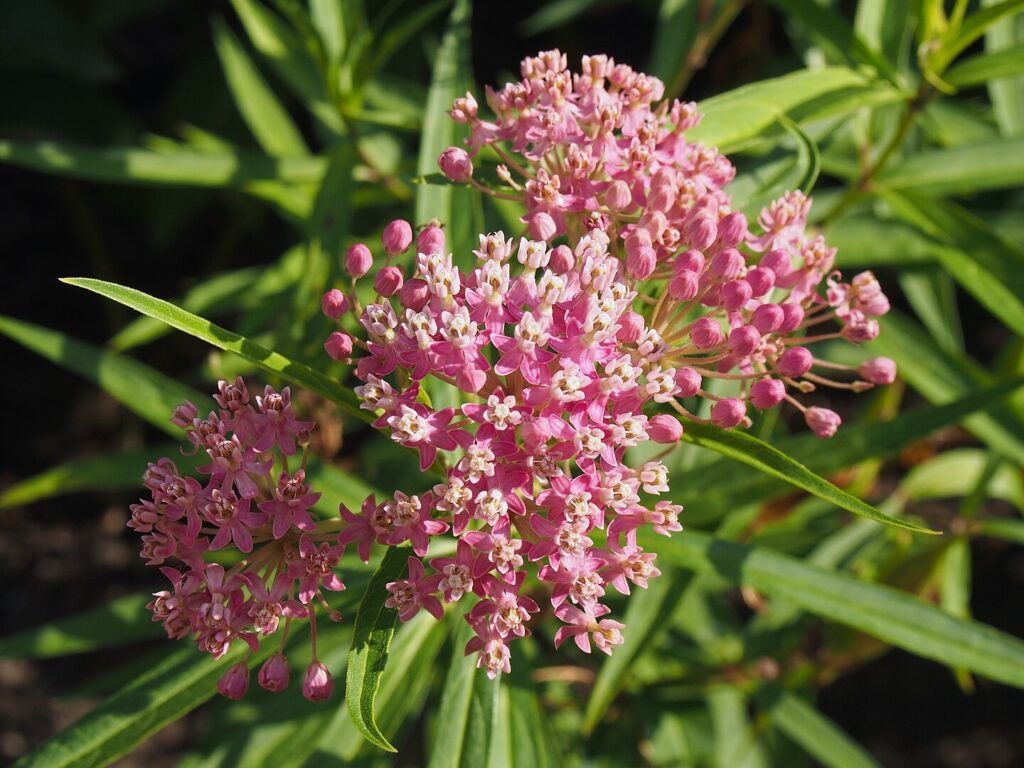
Swamp Milkweed thrives in full sun to partial shade, with a strong preference for moist, well-drained soils. It is ideally suited for wetland areas, rain gardens, or along the edges of ponds and streams where the soil remains consistently moist throughout the growing season.
It is not as tolerant of dry conditions as some other milkweed species but can adapt to slightly drier soils once established. The plant is also tolerant of high humidity and temperatures, making it well-suited for Florida’s climate.
Height / Spread:
Swamp Milkweed can reach up to 3 feet in height and typically spreads to about 2 feet wide. It grows in a clumping habit, which helps to create a dense, attractive mound of foliage and flowers. The plant can be used in groupings for a mass planting effect or as part of a naturalized wetland garden.
Lifespan:
Swamp Milkweed is a perennial in Florida and will return year after year from its root system. It is long-lived and can continue to thrive for many years when grown in appropriate conditions. During the cooler months, the plant may die back to the ground but will regenerate in the spring as temperatures rise.
Bloom Period:
The blooming period for Swamp Milkweed occurs in mid to late summer, typically from June to September. During this time, it produces clusters of small, pink flowers that are highly attractive to pollinators. Each flower cluster lasts for several weeks, providing a continuous source of nectar for butterflies, bees, and other pollinators.
Flower Color:
The flowers of Swamp Milkweed are a soft pink, forming small clusters with a characteristic star-shaped structure. Each flower has five petals and a unique five-lobed crown. The blooms are aromatic and highly attractive to pollinators, particularly monarch butterflies, which rely on milkweed species as a host plant for their larvae.
Wildlife Value:
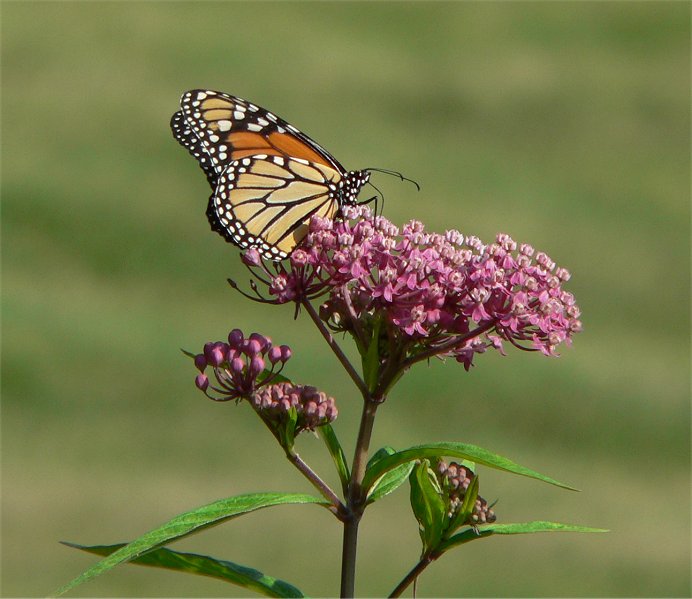
Swamp Milkweed is an important plant for wildlife, especially pollinators like butterflies, bees, and hummingbirds. Monarch butterflies (Danaus plexippus) rely on Swamp Milkweed as a host plant for laying their eggs and feeding their larvae.
The flowers also provide nectar for a variety of bee species, including native honeybees, and other butterflies, such as the Gulf Fritillary (Dione juno) and the Zebra Longwing (Dione idalia). Additionally, the plant’s dense foliage provides shelter for insects and small wildlife, making it a valuable plant in ecosystems that support biodiversity.
18. Coastal Mock Vervain (Glandularia maritima)
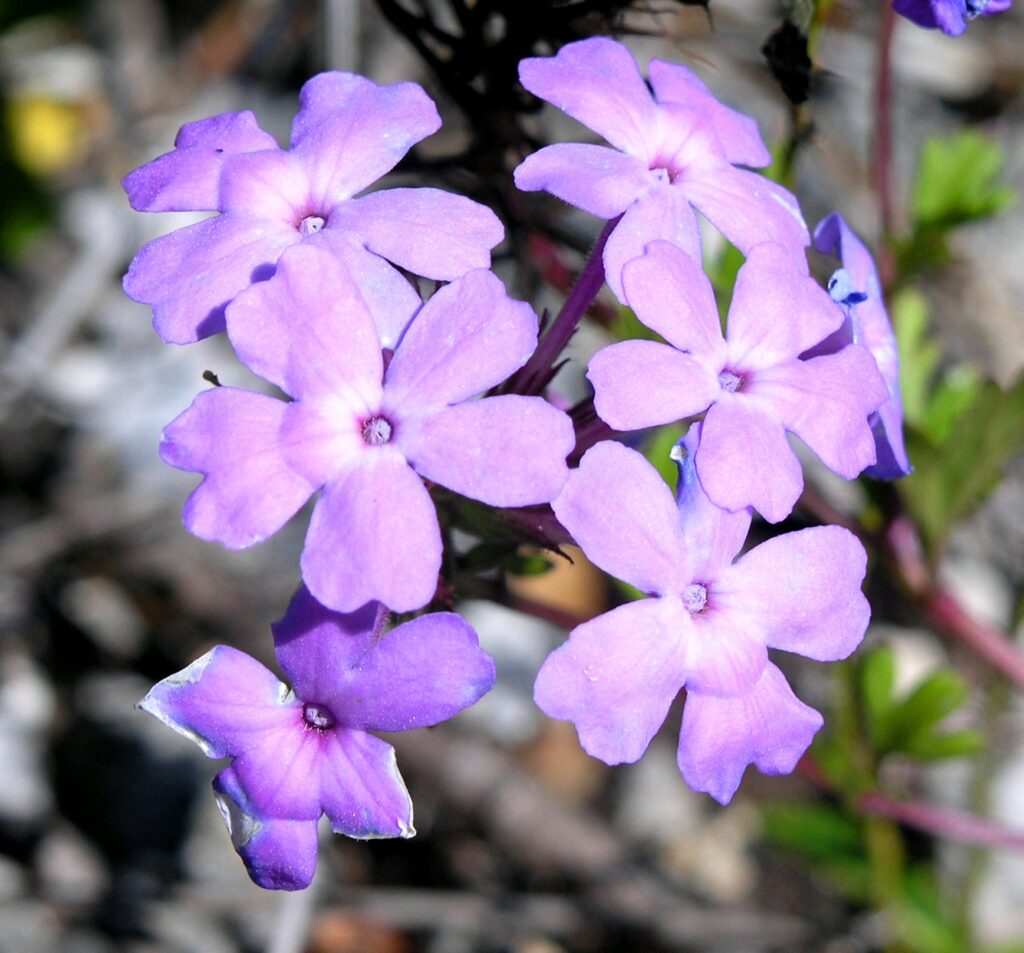
Coastal Mock Vervain, sometimes called “Beach Verbena,” is a low-growing, spreading perennial with small, narrow, and aromatic leaves that are grayish-green in color. It produces dense clusters of small, tubular flowers that range from purple to violet, often with a lighter throat, giving it a delicate appearance.
The plant has a woody base and fine, spreading stems that form a low ground cover or mat. It has a compact growth habit and is well-suited for coastal gardens, dunes, and areas where salt-tolerance is required. Coastal Mock Vervain is often seen in sandy soils and is known for its drought tolerance once established.
Best Growing Region / Zone:
Coastal Mock Vervain thrives in USDA hardiness zones 8a to 11. In Florida, it is most commonly found in coastal areas, including the eastern and southern regions. It prefers areas with direct exposure to saltwater and sea breezes, making it particularly well-suited for the state’s coastal environments, dunes, and sandy roadsides.
It is a native species in Florida’s coastal habitats and is found in areas that are exposed to the elements and often prone to occasional saltwater exposure.
Preferred Growing Conditions:
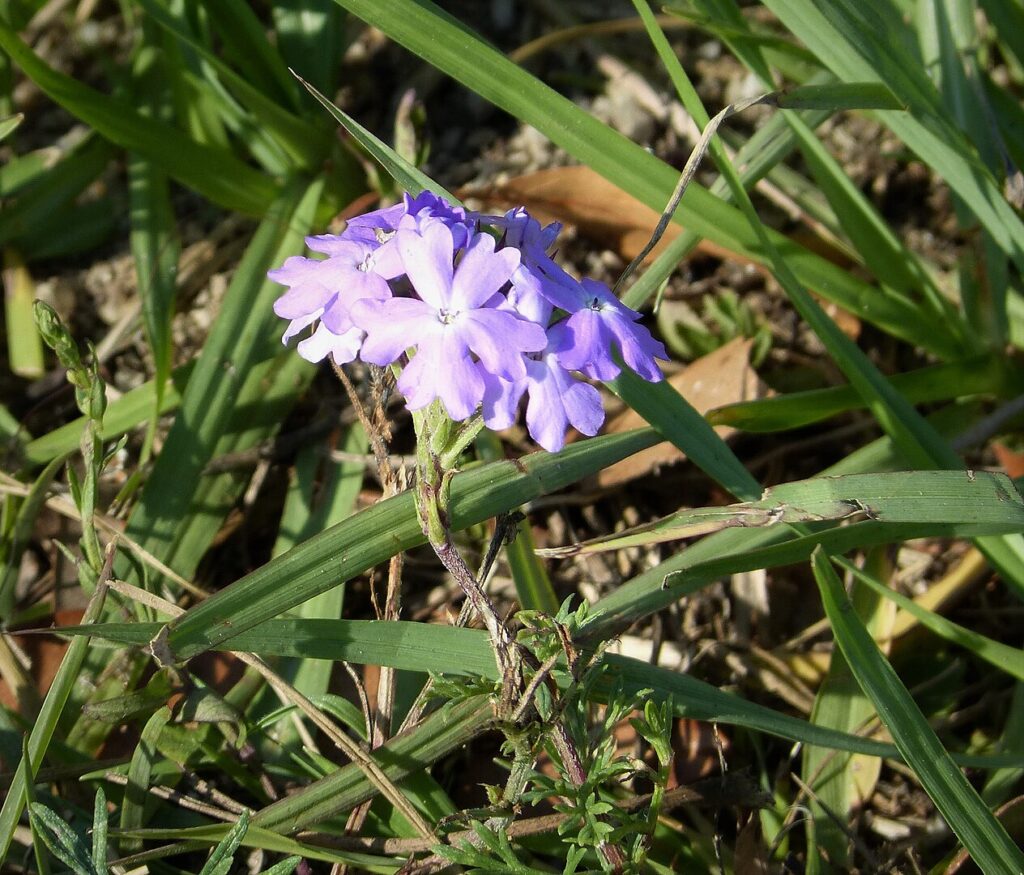
This plant prefers full sun and well-drained sandy or loamy soils. It is highly tolerant of salt, making it an excellent choice for coastal gardens, especially those that experience regular saltwater spray or exposure.
Coastal Mock Vervain thrives in dry, sandy conditions and can endure periods of drought once established. It is also tolerant of poor soils and does not require frequent fertilization. While it does best in full sun, it can tolerate light shade, especially in hotter climates.
Height / Spread:
Coastal Mock Vervain typically grows to about 1 to 2 feet in height and spreads 2 to 3 feet wide. Its spreading habit makes it an excellent ground cover plant, ideal for filling in gaps or stabilizing sandy soil along coastal areas. It can quickly cover large areas and is often used in landscaping to prevent erosion and promote soil stability.
Lifespan:
This plant is a perennial in Florida, capable of living for several years under the right growing conditions. It will typically die back during the cooler months but regrow in the spring, emerging from its root system. It is considered a hardy, long-lived plant in coastal landscapes, often surviving the toughest conditions.
Bloom Period:
Coastal Mock Vervain blooms from spring through summer, with peak blooming occurring in late spring to early summer. It produces an abundance of small, tubular flowers that are attractive to pollinators such as bees, butterflies, and hummingbirds. The flowers are produced in clusters, creating a striking display of color.
Flower Color:
The flowers of Coastal Mock Vervain are typically violet to purple, with a lighter, almost white throat. The tubular flowers are small and densely arranged in clusters, making them highly attractive to pollinators. The vibrant color of the flowers contrasts beautifully against the plant’s gray-green foliage.
Wildlife Value:
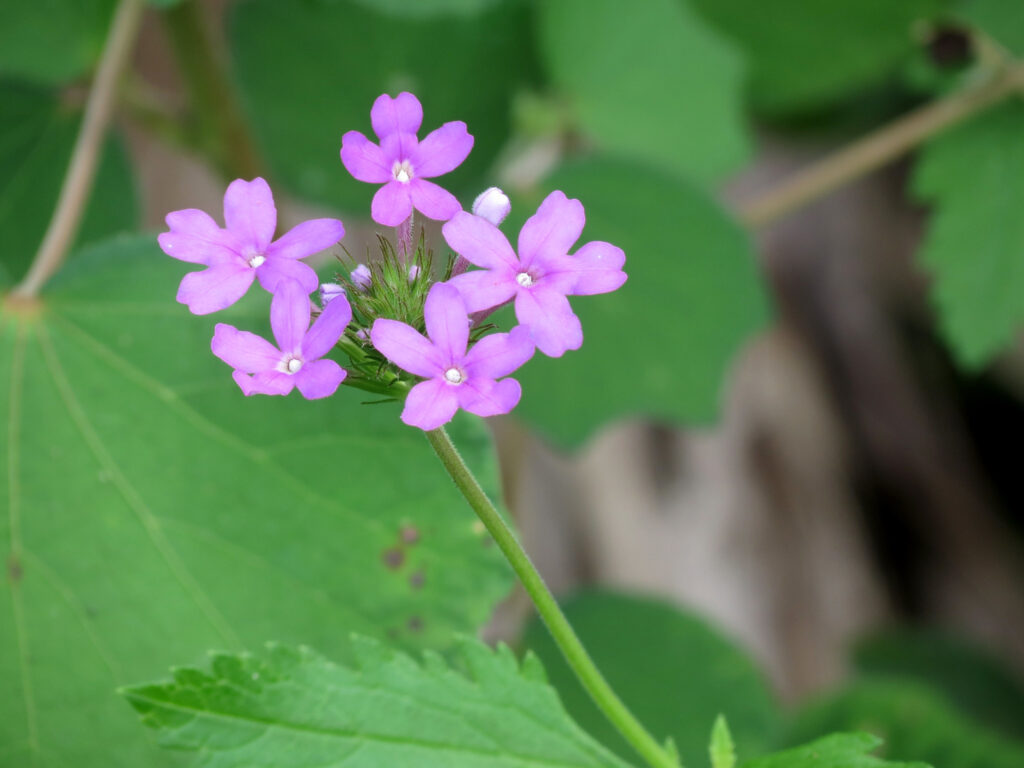
Coastal Mock Vervain is an excellent plant for attracting pollinators, especially butterflies and bees. It is particularly favored by various species of bees, including native bumblebees, as well as by butterflies like the Gulf Fritillary (Dione juno) and the Monarch (Danaus plexippus).
The plant’s dense flowers also provide nectar for hummingbirds. Additionally, Coastal Mock Vervain offers shelter to small insects and wildlife, making it a valuable component of a coastal ecosystem.
19. Elliot’s Aster (Symphyotrichum elliottii)
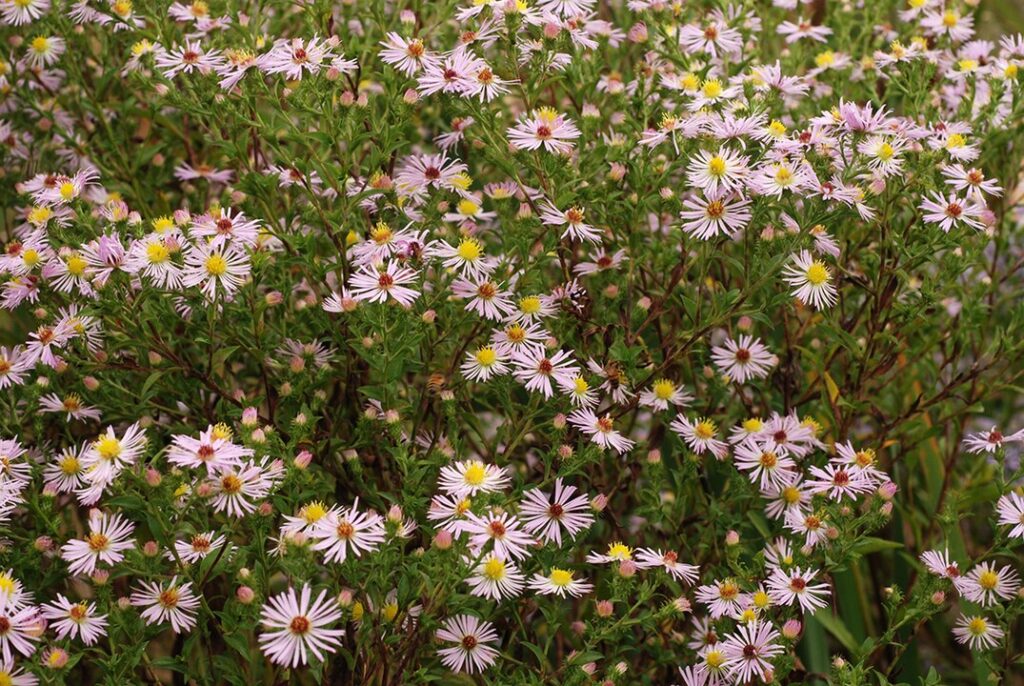
Elliot’s Aster is a native perennial with slender, lance-shaped leaves that form a bushy clump. The plant’s stems are upright, reaching heights of 2 to 4 feet, and are often lightly hairy. Its vibrant, daisy-like flowers bloom in late summer to fall, with lavender to light purple petals surrounding a yellow center.
The flowers attract numerous pollinators, and the plant has a soft, airy appearance when in full bloom. Elliot’s Aster thrives in moist, well-drained soils and is typically found in natural settings like wetlands, floodplains, and coastal uplands.
Best Growing Region / Zone:
Elliot’s Aster is found in USDA hardiness zones 8a to 10b, making it ideal for the warmer parts of Florida, particularly in central and southern regions. It naturally grows in moist environments, such as wet prairies, marshes, and coastal plains, and can be found in Florida’s wetland areas and along riverbanks. It thrives in areas with high humidity and regular rainfall.
Preferred Growing Conditions:
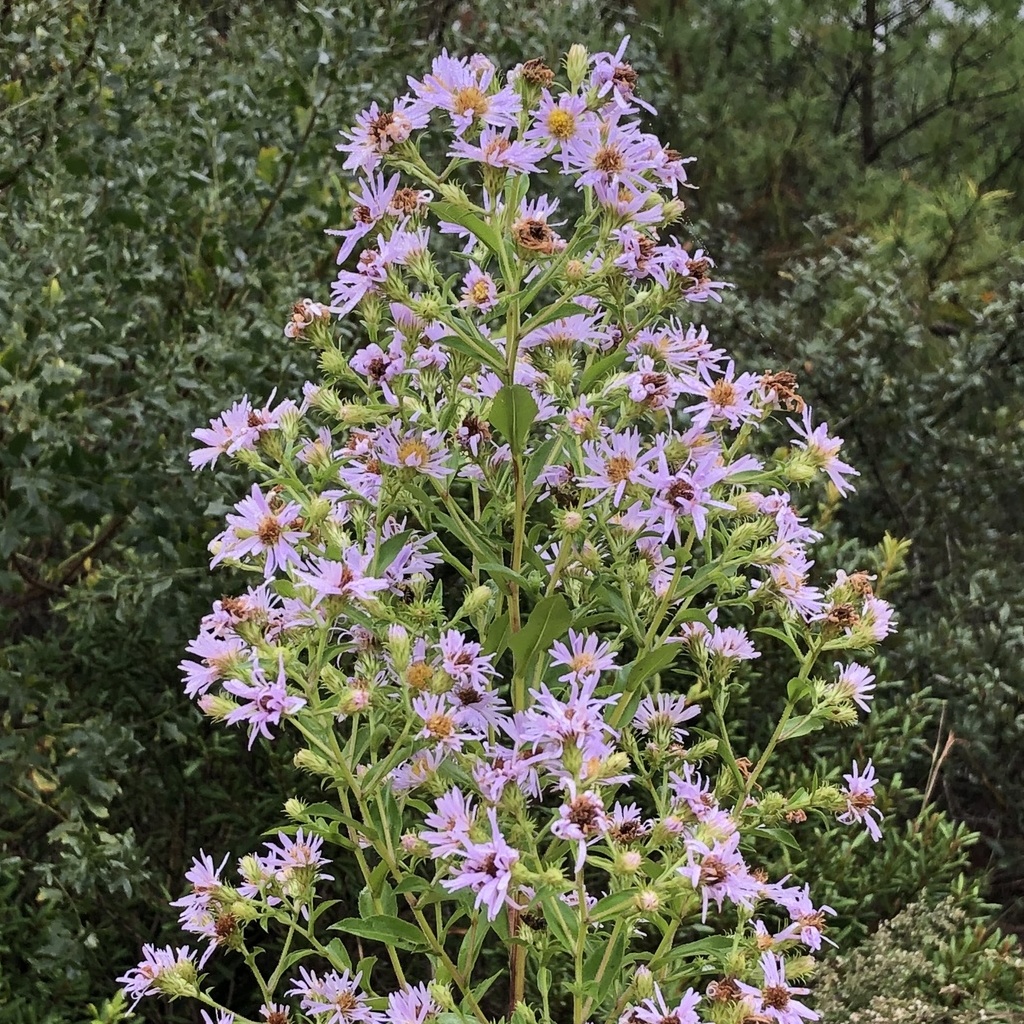
This species prefers moist to moderately wet, well-drained soils in full sun to partial shade. While it is adaptable to various soil types, it performs best in fertile, humus-rich soils. Elliot’s Aster is not particularly drought-tolerant, so it requires consistent moisture, especially during the hotter months.
It benefits from regular watering during dry periods but should not sit in standing water, as it prefers well-drained conditions. It is generally pest-resistant and requires minimal maintenance once established.
Height / Spread:
Elliot’s Aster typically grows to a height of 2 to 4 feet, with a spread of about 2 to 3 feet. The plant has a relatively compact growth habit, making it suitable for medium-sized landscapes or as part of a wildflower garden. Its erect stems and bushy form make it a good choice for adding vertical interest to garden beds or native plantings.
Lifespan:
Elliot’s Aster is a perennial that can live for several years in favorable conditions. While it will die back in the winter, the root system remains alive, and the plant will re-emerge in the spring. It can thrive for many years with minimal care, as long as it is in a location with adequate moisture.
Bloom Period:
This aster blooms from late summer through fall, typically from August to November, with peak flowering occurring in September and October. Its bright lavender flowers attract a wide variety of pollinators, especially bees and butterflies.
Flower Color:
The flowers of Elliot’s Aster are a soft lavender to pale purple, with a yellow center. The flowers are typically about 1 to 2 inches across and are arranged in loose clusters at the tops of the plant’s stems. The plant’s vibrant flowers stand out against its dark green foliage.
Wildlife Value:
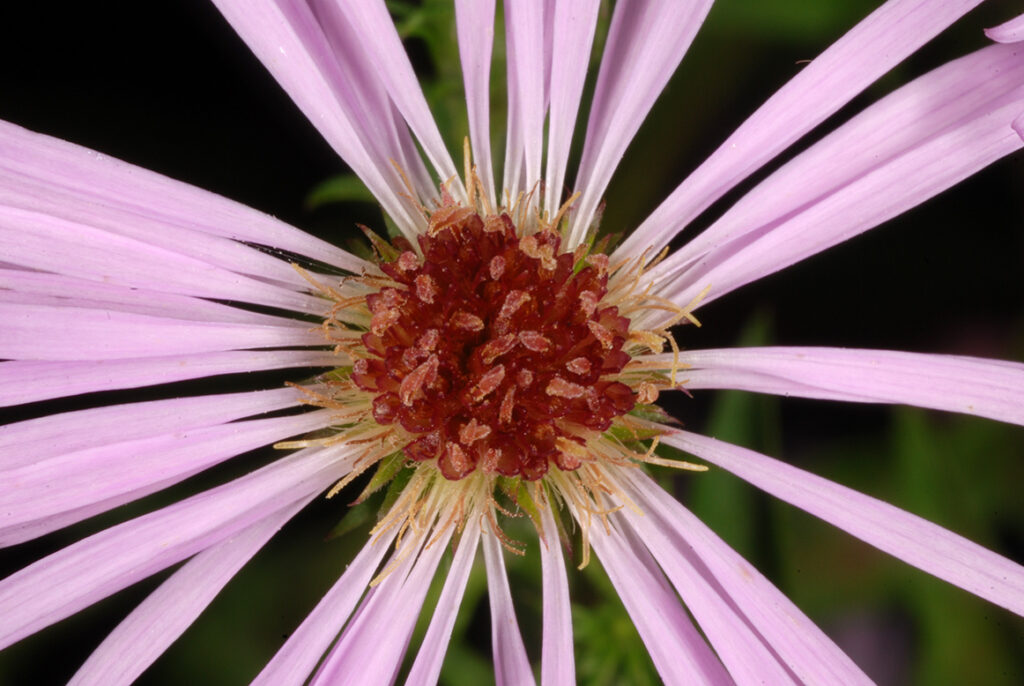
Elliot’s Aster is highly beneficial to wildlife, attracting a wide range of pollinators. It is particularly favored by native bees, such as honeybees and bumblebees, as well as butterflies like the American Snout (Libytheana carinenta) and the Painted Lady (Vanessa cardui).
The plant’s seeds are also an important food source for small birds, particularly sparrows. By supporting these pollinators and birds, Elliot’s Aster plays a crucial role in sustaining local ecosystems.
20. Spiderwort (Tradescantia ohiensis)
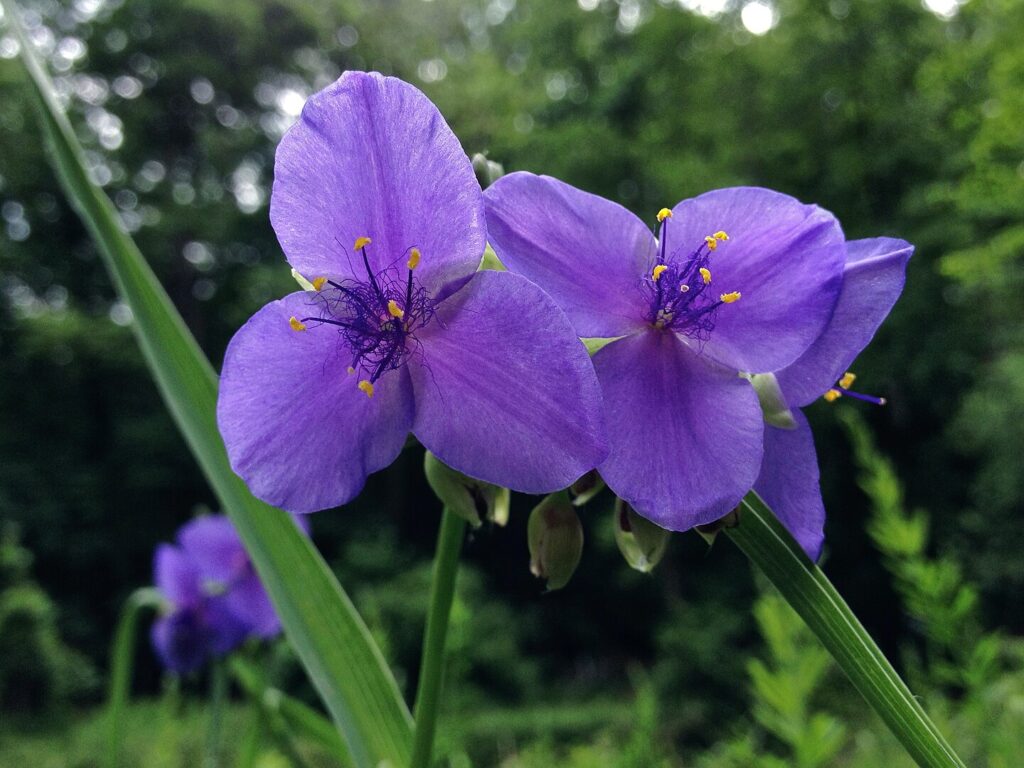
Spiderwort is a perennial herb known for its striking, triangular leaves and clusters of blue, three-petaled flowers. The plant’s leaves are long and lance-shaped, emerging from the base in a clump.
The flowers are bright blue with yellow stamens, and they bloom during the morning, often closing by the afternoon. Spiderwort’s grass-like foliage adds texture to gardens, while its vibrant flowers provide color from spring to early summer.
Best Growing Region / Zone:
Spiderwort thrives in USDA hardiness zones 5b to 9b, making it suitable for much of Florida, particularly in the northern and central regions. It grows well in moist, well-drained soils, especially in areas that mimic its natural habitat of meadows, prairies, and woodlands.
Preferred Growing Conditions:
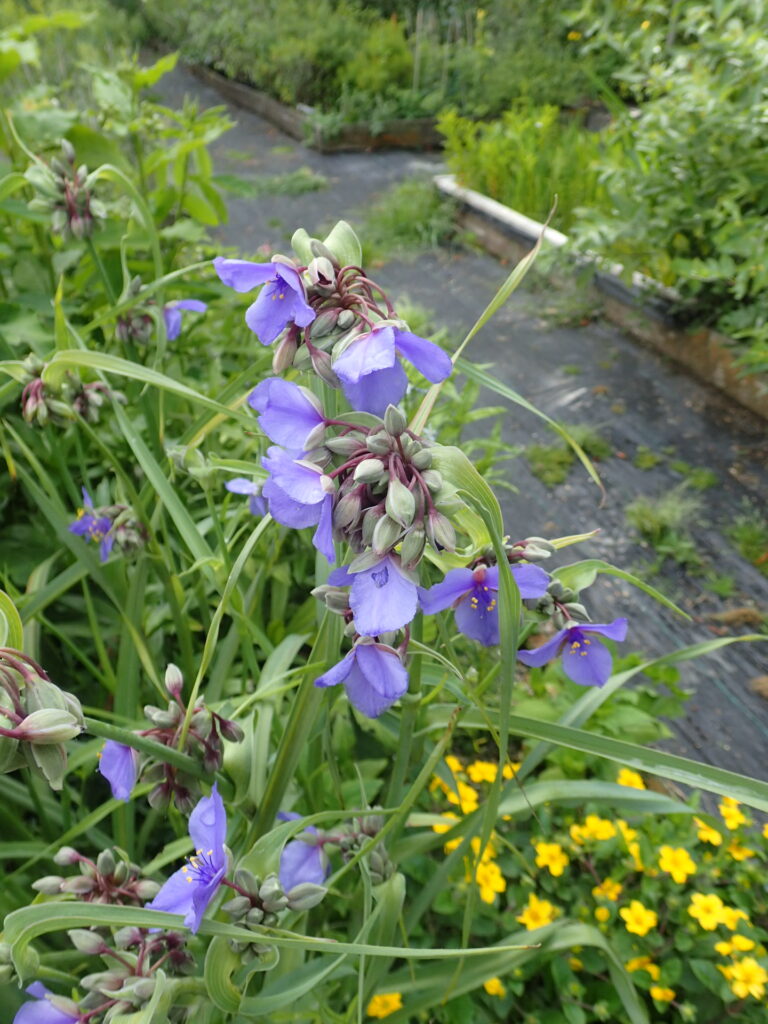
This plant prefers full sun to partial shade, though it blooms best when given at least a few hours of direct sunlight each day. Spiderwort is adaptable to a variety of soil types but does best in moderately rich, moist, well-draining soil. It tolerates both drought and wet conditions once established, though it generally prefers slightly moist environments.
Height / Spread:
Spiderwort generally grows between 1 to 2 feet tall and spreads about 1 to 1.5 feet wide. Its clumping growth habit makes it ideal for filling in borders or adding naturalistic texture to garden beds.
Lifespan:
Spiderwort is a perennial plant, typically returning each year. However, it is short-lived, with individual plants often dying back after a couple of seasons. It tends to self-seed freely, allowing it to persist in the garden even if older plants die off.
Bloom Period:
The bloom period for Spiderwort typically occurs in late spring to early summer, from April to June. It produces flowers that last only a day or two but continuously produces new blooms throughout the flowering season.
Flower Color:
Spiderwort flowers are bright blue or purple, often with a slight pinkish tinge in some varieties. The blooms have a unique, delicate appearance and are highlighted by the contrasting yellow stamens at their centers.
Wildlife Value:
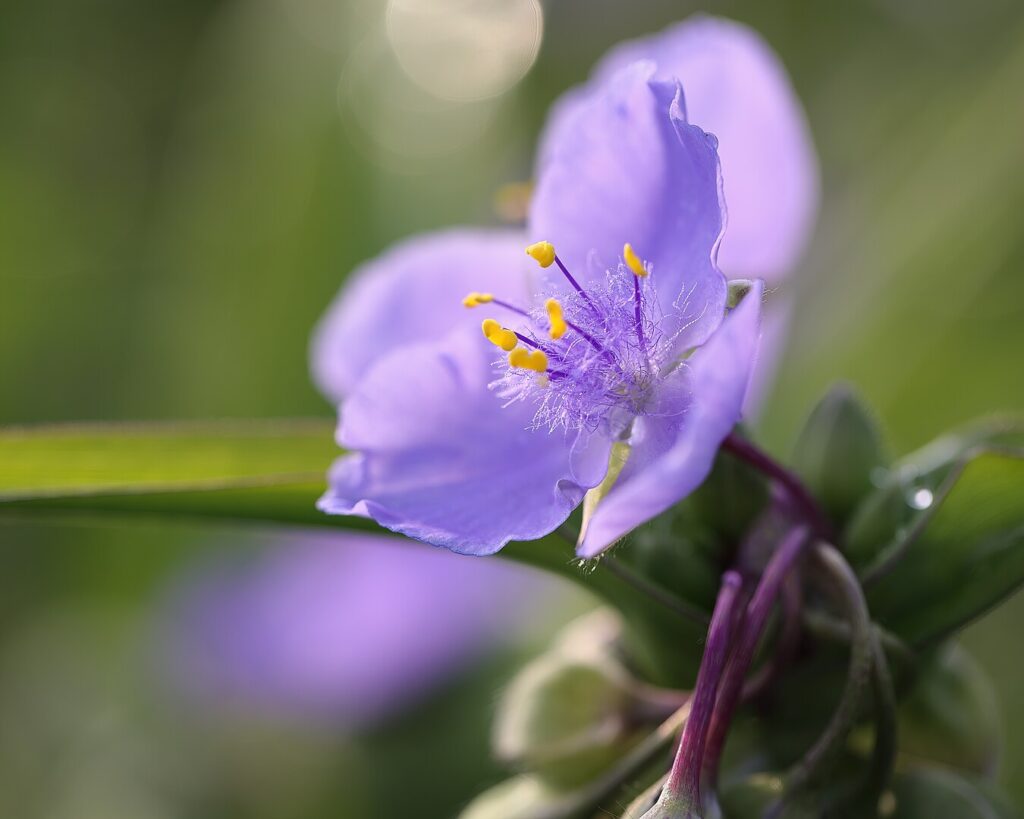
Spiderwort provides valuable nectar for pollinators, particularly bees and butterflies. Its flowers are especially attractive to native bees, and its seeds offer food for birds during the fall and winter months. It can also serve as cover for small wildlife.
21. Stokes Aster (Stokesia laevis)
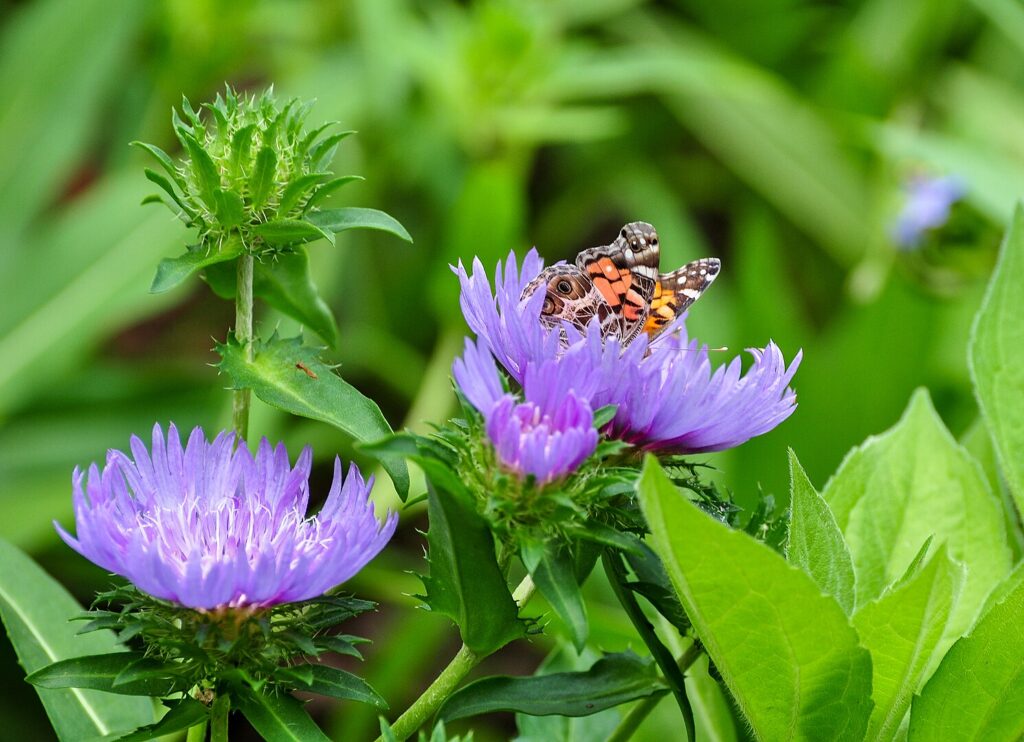
Stokes Aster is a perennial herb known for its large, daisy-like flowers that bloom in shades of lavender to blue. The plant has smooth, dark green leaves and an upright, bushy growth habit.
It typically produces flowers from mid to late summer, attracting pollinators like bees and butterflies. Its large, showy blooms and long flowering period make it a striking addition to native gardens. The plant can grow in clumps and is ideal for attracting pollinators due to its abundant nectar-rich flowers.
Best Growing Region / Zone:
Stokes Aster thrives in USDA Hardiness Zones 7b to 9a. It is native to the southeastern United States, particularly in areas such as the Carolinas and Georgia. This plant does best in regions with mild winters and warm summers, making it well-suited for Florida’s climate, especially in the northern and central parts of the state.
Preferred Growing Conditions:
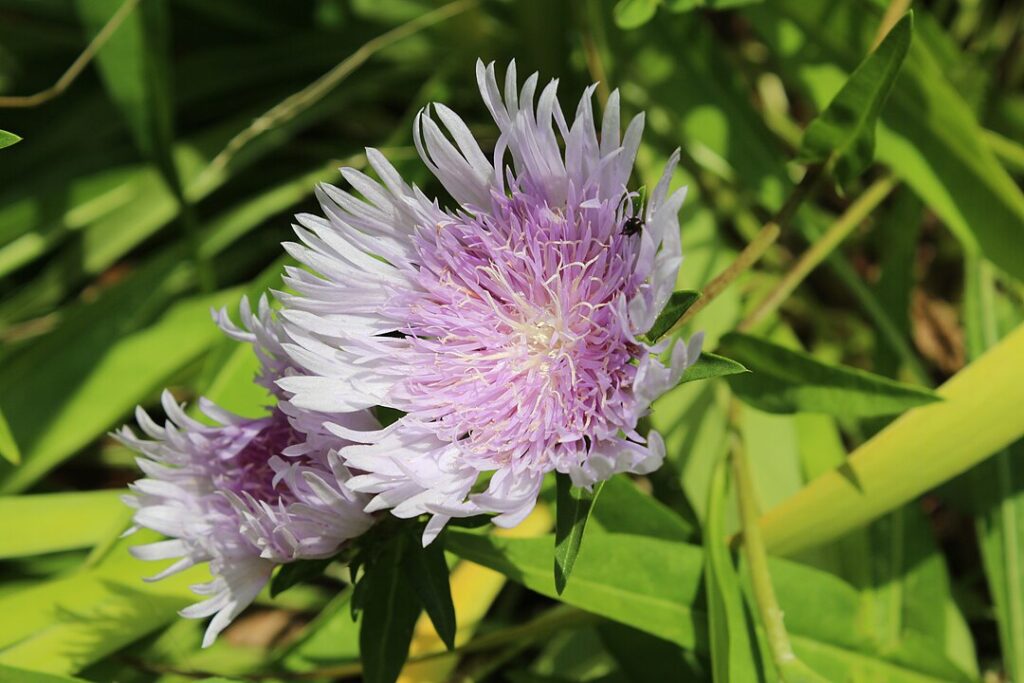
Stokes Aster prefers well-drained, slightly acidic soil and a sunny location. While it can tolerate some light shade, it blooms best when given full sun. It is relatively drought-tolerant once established but will perform better with moderate watering during dry spells. This plant also appreciates good air circulation and benefits from occasional mulching to maintain soil moisture.
Height / Spread:
Stokes Aster typically grows between 1 to 2 feet in height and spreads about 18 to 24 inches. It forms clumps, with each plant producing multiple stems that rise from a central base. The flowers appear on sturdy stems that stand above the foliage, creating a neat, bushy appearance.
Lifespan:
Stokes Aster is a perennial, meaning it lives for several years, typically blooming every summer as long as the plant is well-maintained. The plant can thrive for 3 to 5 years, sometimes longer, if grown in ideal conditions with proper care.
Bloom Period:
Stokes Aster begins blooming in early to mid-summer and continues until the fall. The flowers typically last from June through September, with the peak bloom occurring in July and August. This extended blooming period provides vital nectar for bees, butterflies, and other pollinators during the growing season.
Flower Color:
The flowers of Stokes Aster range in color from lavender to a deep blue, with a central yellow disk surrounded by soft, petal-like ray flowers. The color of the blooms can vary slightly depending on the growing conditions, but they are generally a striking shade of purple to blue.
Wildlife Value:
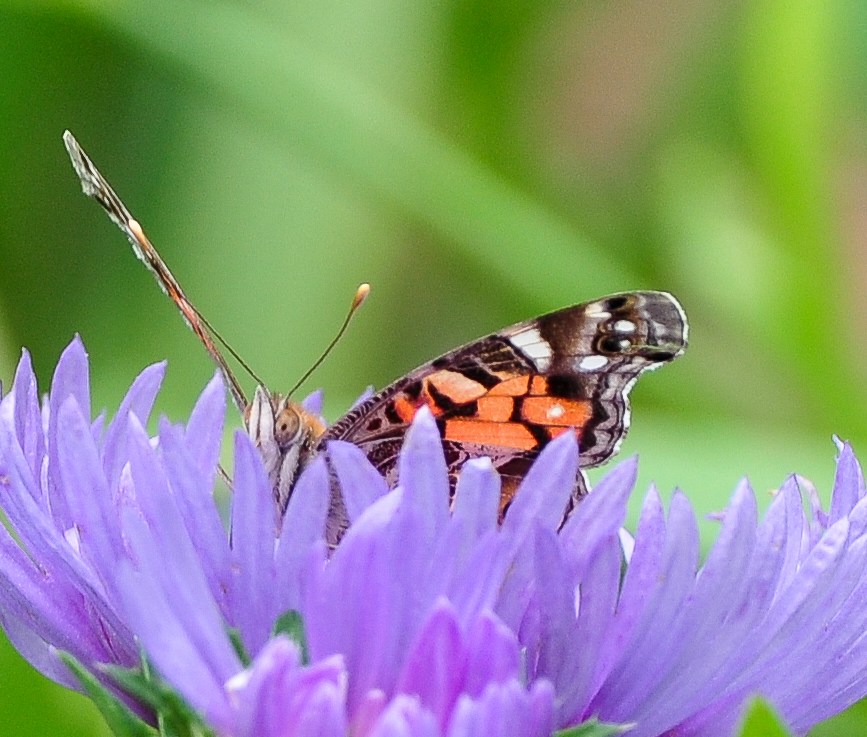
Stokes Aster is highly beneficial for pollinators, particularly for various species of native bees, such as the mason bee (Osmia spp.) and bumblebees (Bombus spp.). It also attracts butterflies, including the common eastern tiger swallowtail (Papilio glaucus) and the painted lady (Vanessa cardui), which feed on its nectar.
Additionally, the flowers provide a rich source of nectar for honeybees (Apis mellifera) throughout the blooming season, supporting local pollinator populations.
22. Swamp Rosemallow (Hibiscus grandiflorus)
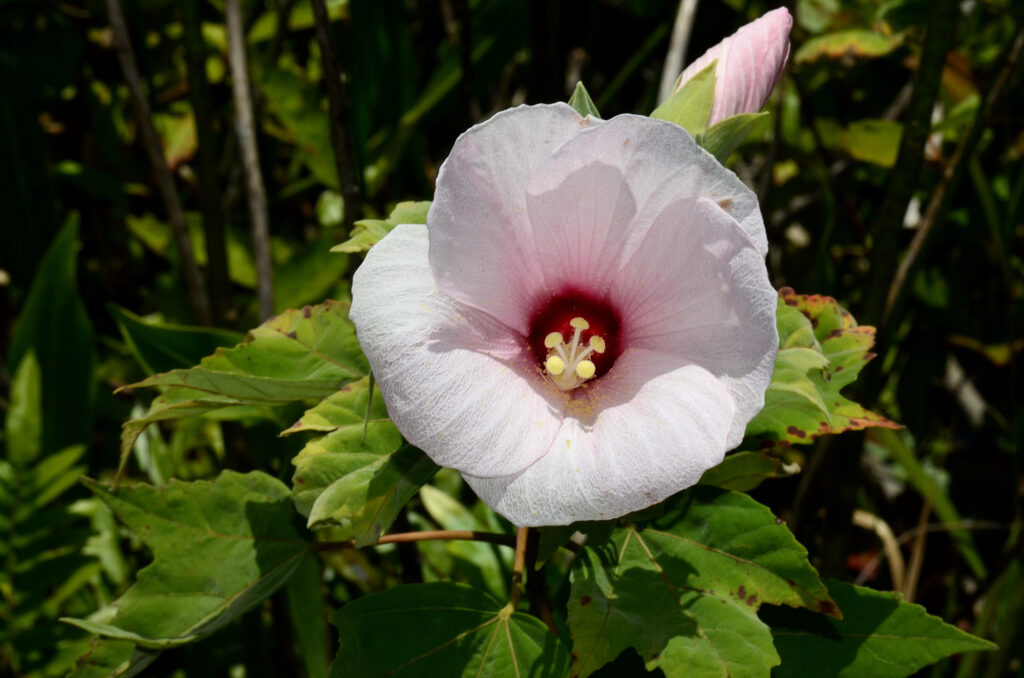
jimduggan24 CC BY 2.0
Swamp rosemallow is a striking perennial plant known for its large, showy flowers. The plant produces huge, trumpet-shaped blooms that can reach up to 6 inches in diameter. These flowers have a dramatic appearance with delicate, pale pink or white petals surrounding a prominent dark red center.
The plant’s foliage is deep green, and it tends to grow in a bushy clump. Its tall, erect stems add vertical interest to any garden, with the blooms positioned above the leaves for high visibility. Swamp rosemallow can be a wonderful addition to wetland areas or water gardens due to its moisture-loving nature.
Best Growing Region / Zone:
Swamp rosemallow thrives in USDA hardiness zones 8b to 11b, which covers much of Florida, especially in the central and southern regions. It is well-suited to the southeastern U.S. climate, where the warmth and humidity provide optimal growing conditions for this plant.
Preferred Growing Conditions:
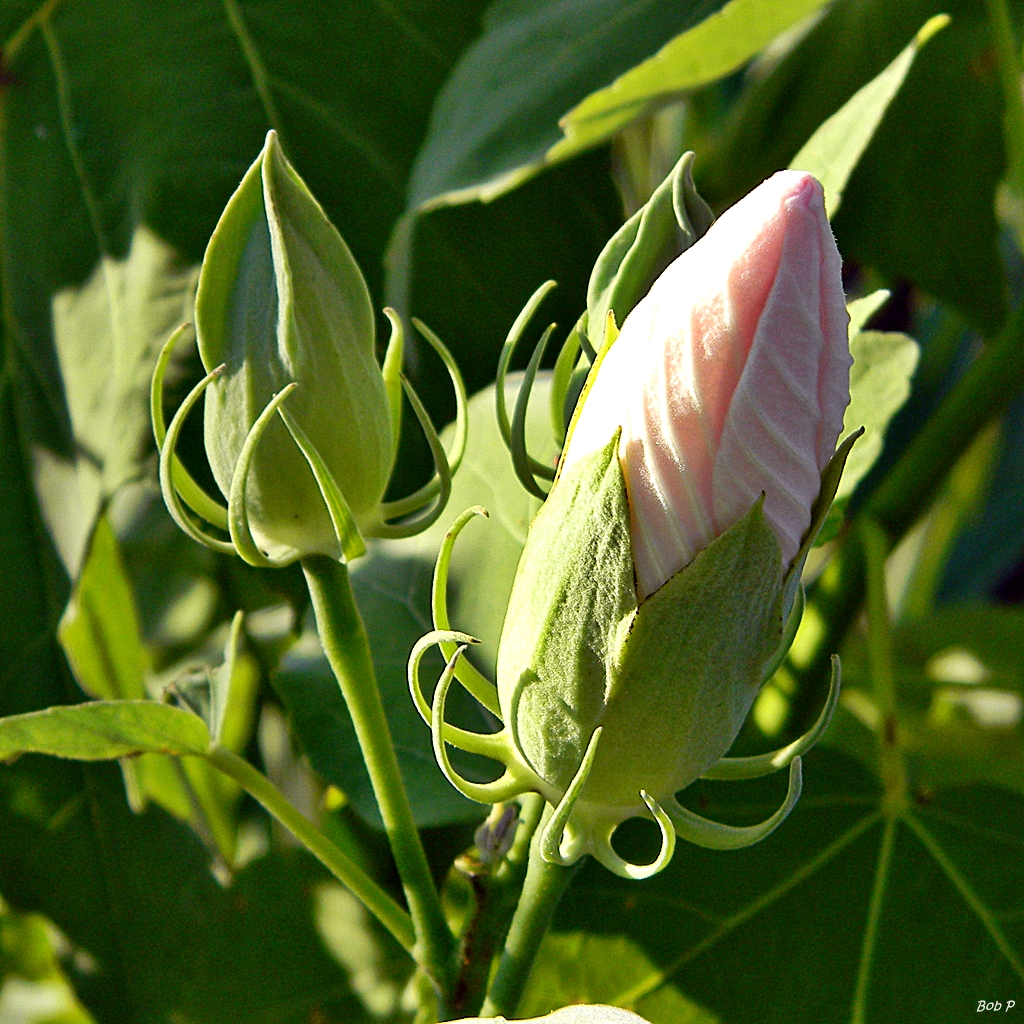
Bob Peterson CC BY 2.0
This plant prefers moist, well-drained soils and is often found growing near ponds, streams, or in marshy areas. It enjoys full sun but can tolerate partial shade in hotter climates. Swamp rosemallow can also tolerate occasional flooding, making it a great choice for areas with standing water during heavy rains. While it thrives in wet environments, it also does well in slightly drier, well-watered soil conditions.
Height / Spread:
Swamp rosemallow typically grows to a height of 4 to 6 feet, with a spread of about 3 to 4 feet. Its tall, upright growth makes it an excellent plant for adding height to garden borders, water features, or even as a background in larger garden beds.
Lifespan:
This plant is a perennial, meaning it will return year after year. Swamp rosemallow can live for several seasons when given the proper growing conditions, with new growth emerging in the spring as the weather warms.
Bloom Period:
Swamp rosemallow blooms during the late summer to fall months, typically from July through September. The large, beautiful flowers attract pollinators, and each individual bloom lasts only a day, but new ones appear continuously throughout the blooming period.
Flower Color:
The flowers of Swamp rosemallow are typically pale pink or white with a dark red or purple center. The dramatic contrast between the light petals and dark throat of the flower is a distinctive feature of this plant, making it a standout in the garden.
Wildlife Value:
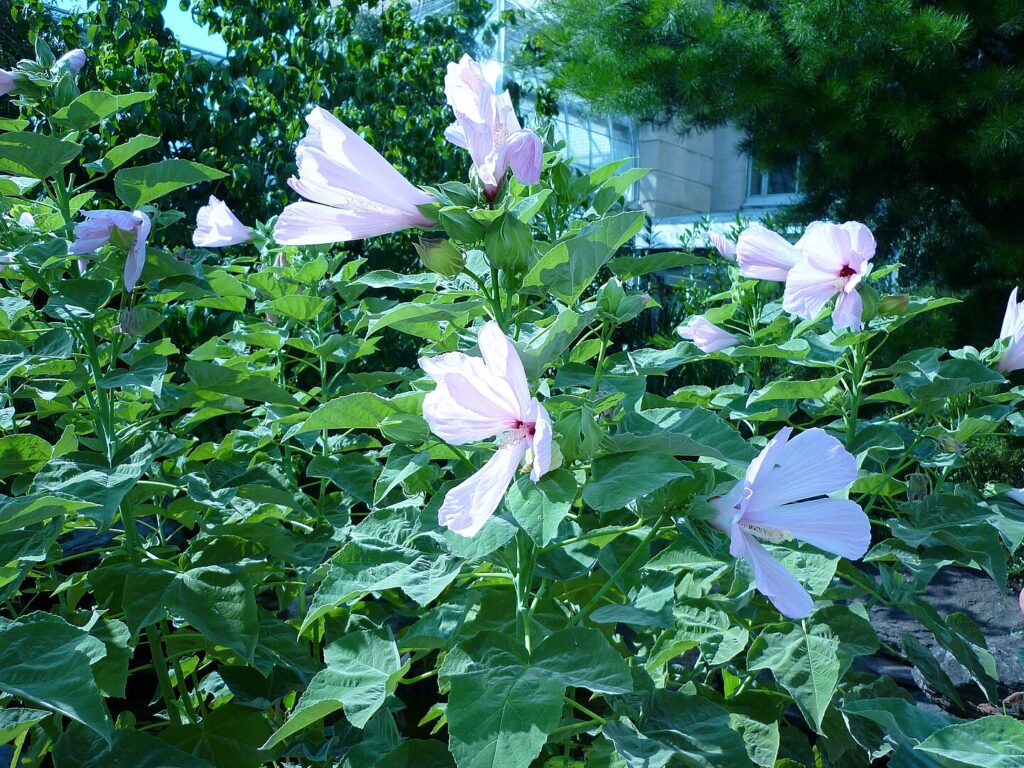
Swamp rosemallow is particularly attractive to pollinators, including bees such as the Eastern Bumblebee (Bombus impatiens) and butterflies like the Swallowtail species. The nectar-rich flowers provide an important food source for these pollinators, especially during the late summer when many other plants are past their blooming period.
It is also visited by hummingbirds, who are drawn to the bright, trumpet-like flowers.
23. Wild Blue Phlox (Phlox divaricata)
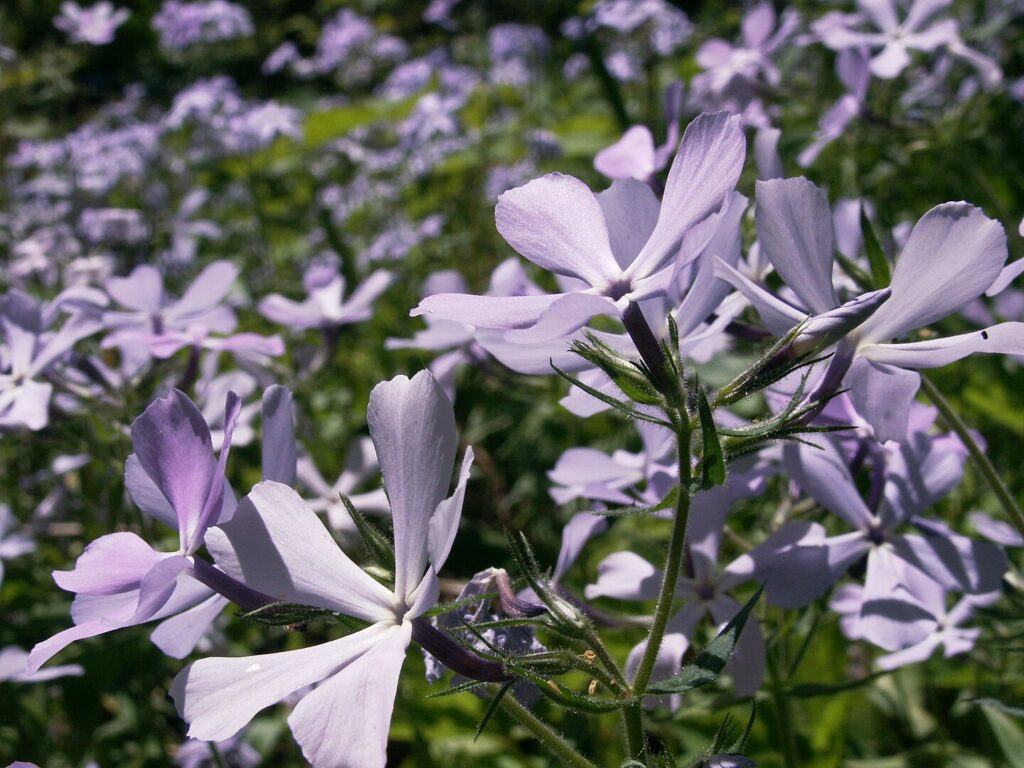
Wild blue phlox is a perennial herbaceous plant with fragrant, delicate blue or lavender flowers that bloom in loose clusters. The flowers have five petals each, forming a star-like shape, and the plant has a soft, spreading growth habit. The leaves are opposite and lance-shaped, giving the plant a bushy appearance.
Wild blue phlox is a low-maintenance plant that is often found in woodland or meadow settings. Its beauty and pleasant fragrance make it a popular choice for naturalized gardens or as an underplanting in shady areas.
Best Growing Region / Zone:
Wild blue phlox is well-suited to USDA hardiness zones 4 to 8, which encompasses much of the northern and central United States, extending into parts of the Southeast. It grows particularly well in moist, shaded areas and is common in the woodlands of eastern North America, making it a good fit for gardens in the Midwest and Northeast.
Preferred Growing Conditions:
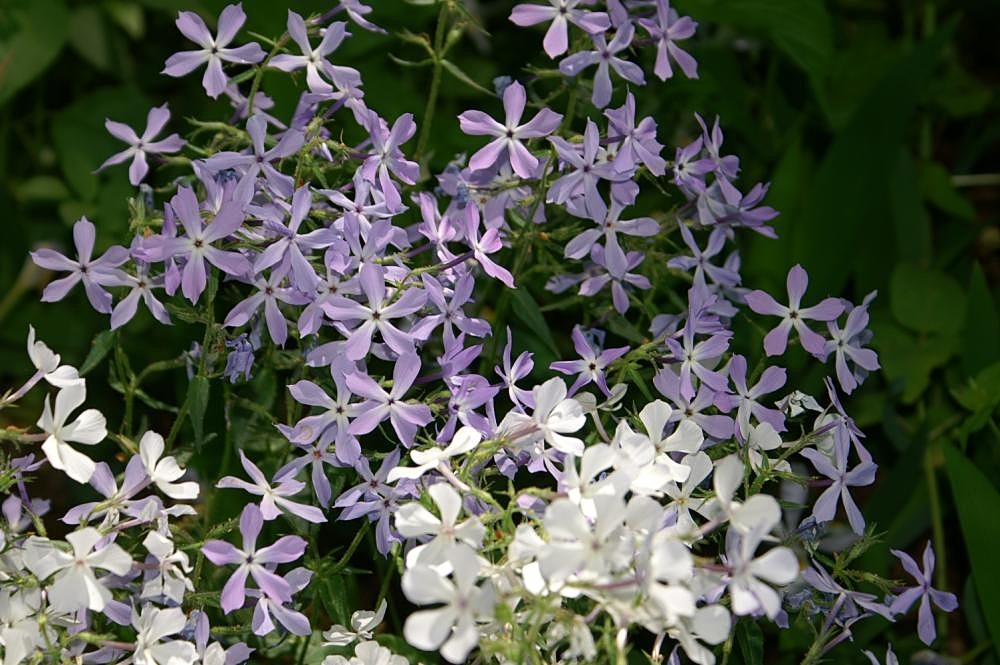
This plant thrives in moist, well-drained soil that is rich in organic matter. It prefers partial to full shade, making it an ideal choice for woodland gardens or areas with dappled sunlight.
Wild blue phlox also tolerates some sunlight but performs best in cooler, shaded conditions. It appreciates consistent moisture, especially during the blooming period, and should be watered regularly to avoid dry spells.
Height / Spread:
Wild blue phlox grows to a height of 12 to 18 inches and spreads up to 18 inches wide. Its compact, spreading growth habit makes it suitable for use in ground covers or as a low border in garden beds.
Lifespan:
As a perennial, wild blue phlox returns year after year, typically living for several seasons with minimal care. It is a reliable addition to any garden, particularly in shady or woodland environments, where it thrives and naturalizes over time.
Bloom Period:
The bloom period for wild blue phlox is in spring, typically from April to June, depending on the climate. The plant produces abundant clusters of small, tubular flowers that last for several weeks, providing an early source of nectar for pollinators.
Flower Color:
The flowers of wild blue phlox are typically shades of pale to medium blue or lavender, with a slight pinkish hue in some varieties. The five-petaled flowers have a star-like shape and a pleasant fragrance that attracts pollinators.
Wildlife Value:
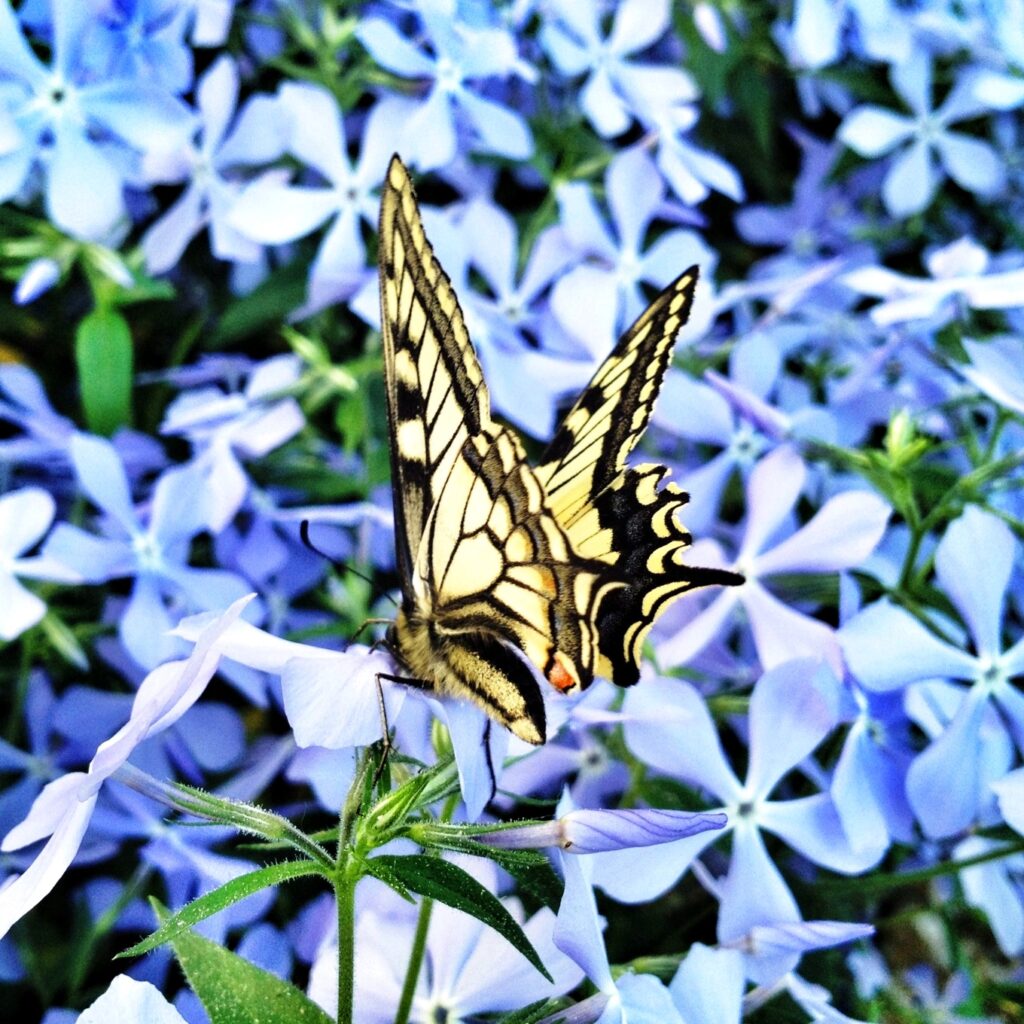
Wild blue phlox is an excellent plant for attracting a variety of pollinators, including bees such as the Common Eastern Bumblebee (Bombus impatiens) and butterflies like the Spring Azure (Celastrina ladon) and Fritillary species.
Its early blooming period provides important nectar sources for these insects, particularly in areas where few other plants are in bloom. Additionally, it serves as a host plant for several species of caterpillars, making it beneficial for the broader ecosystem.
Benefits of Florida Native Plants
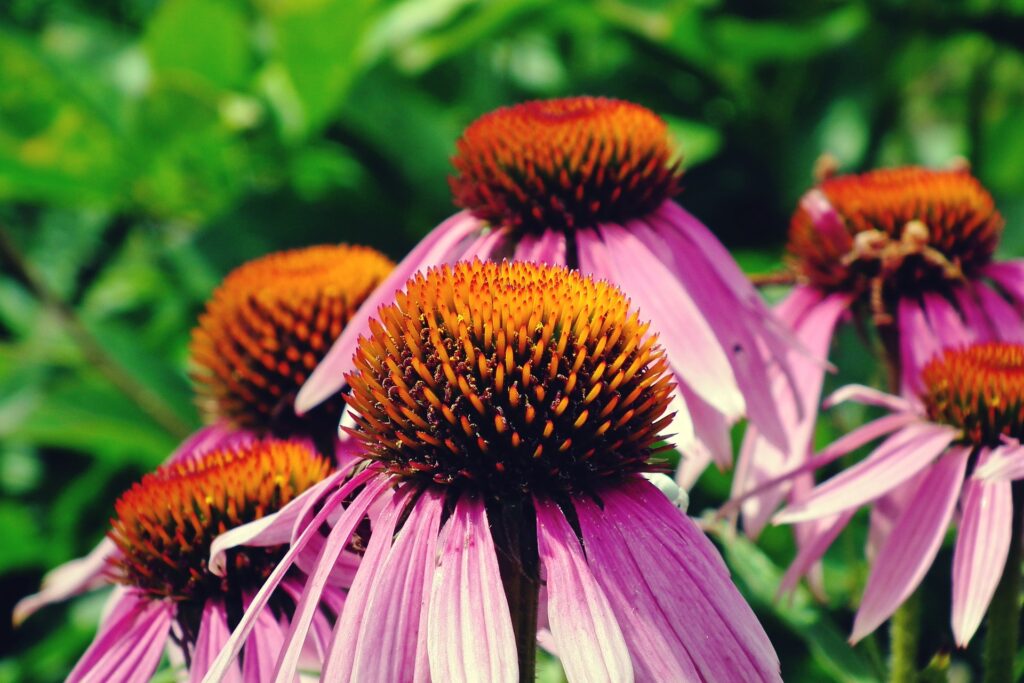
Focusing your garden planning to the use of plants native to Florida has a long list of benefits.
Environmental Benefits: How Florida Native Plants Help the Planet
One of the main benefits using native plants offer is helping to support the local ecosystems.
Save Water with Florida Native Plants
Florida native plants are water-saving heroes, requiring up to 60% less irrigation compared to non-native species.
Their natural ability to thrive on rainfall alone helps you conserve water and reduce dependency on supplemental watering systems, making them ideal for eco-conscious gardeners.
Create a Wildlife Haven with Florida Native Plants
Native plants are essential for supporting Florida’s ecosystems. They provide food and shelter for pollinators, birds, and other wildlife, ensuring your garden becomes a sanctuary for biodiversity.
By planting natives, you help sustain local species that rely on these plants for survival.
Prevent Erosion with Soil-Stabilizing Native Plants
Native plants are champions of soil health. Their deep and fibrous root systems stabilize the soil, preventing erosion even in Florida’s sandy or flood-prone areas.
Over time, they improve soil structure, making your garden more resilient.
Reduce Fertilizer Use with Low-Maintenance Native Plants
Florida native plants evolved to thrive in local soils, meaning they rarely require fertilizers.
This reduces nutrient runoff into waterways, protecting Florida’s fragile aquatic ecosystems from harmful algae blooms.
Shrink Your Carbon Footprint with Florida Native Plants
Native plants lower your garden’s carbon footprint. Since they don’t require extensive irrigation, fertilizers, or chemical treatments, they use fewer resources and reduce greenhouse gas emissions associated with their care.
Practical Benefits: Why Florida Native Plants Are a Gardener’s Best Friend
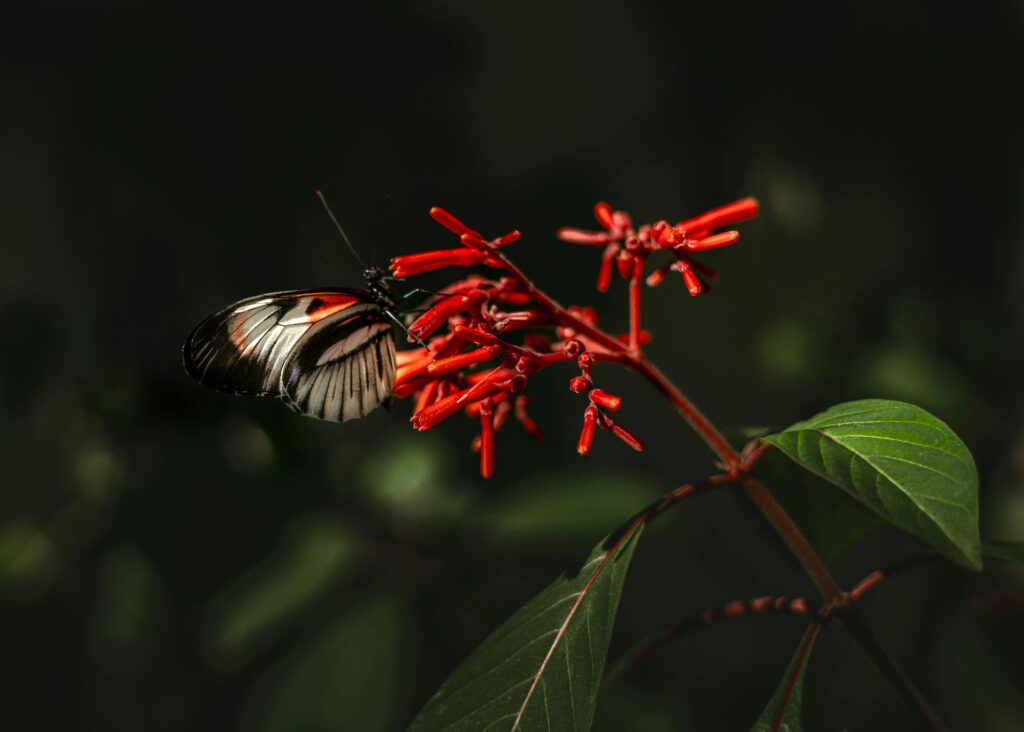
Using Florida native plants is also a great way to reduce your workload in the garden. While we may love to garden, spending fewer hours outdoors in July and August can make it even more enjoyable.
Lower Maintenance, More Enjoyment
One of the biggest perks of Florida native plants is their low-maintenance nature. These plants are adapted to local conditions, so they need less watering, pruning, and pest control, freeing up your time to enjoy your garden rather than work in it.
Cut Costs with Florida Native Plants
By reducing water usage and eliminating the need for fertilizers and pesticides, Florida native plants can lower your gardening expenses.
Additionally, their long lifespan means you’ll spend less on replacements over time.
Fewer Pest Problems, More Garden Harmony
Florida native plants are naturally resistant to many local pests and diseases. This means fewer infestations and less need for chemical treatments, making your garden healthier and safer for wildlife and people alike.
Stand Strong Against Florida’s Weather
From hurricanes to droughts, Florida’s climate can be extreme. Native plants are built to endure these challenges, standing up to high winds, heavy rains, and prolonged dry periods.
Their natural resilience makes them a reliable choice for disaster-prone regions.
Long-Term Savings with Florida Native Plants
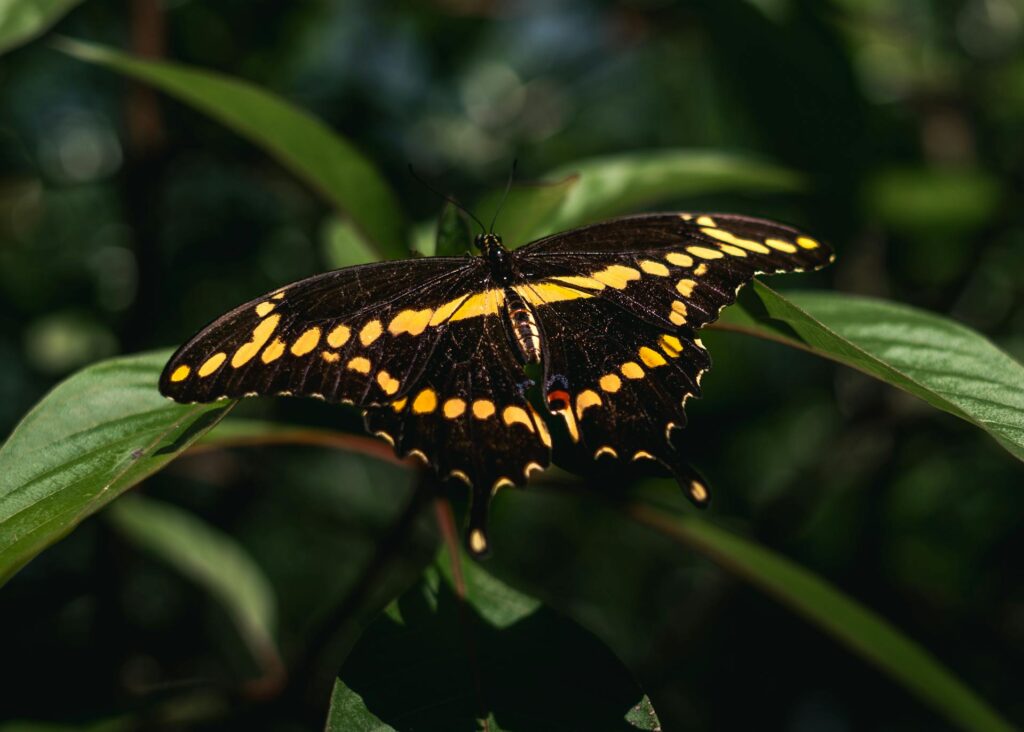
Over time, the cost savings from reduced water bills, fewer plant replacements, and minimal maintenance add up.
Florida native plants are not only an environmentally sound choice but also a financially savvy one for homeowners looking to create sustainable landscapes.



